Multidentate Dinuclear Cyclometallated Complexes Containing N^c^c^n-n^c^c^n Ligand
LI; Guijie ; et al.
U.S. patent application number 15/785020 was filed with the patent office on 2019-02-28 for multidentate dinuclear cyclometallated complexes containing n^c^c^n-n^c^c^n ligand. The applicant listed for this patent is AAC Microtech (Changzhou) Co., Ltd.,, Zhejiang University of Technology. Invention is credited to Shaohai CHEN, Guijie LI, Yuanbin SHE, Xiangdong ZHAO.
| Application Number | 20190067598 15/785020 |
| Document ID | / |
| Family ID | 61171377 |
| Filed Date | 2019-02-28 |
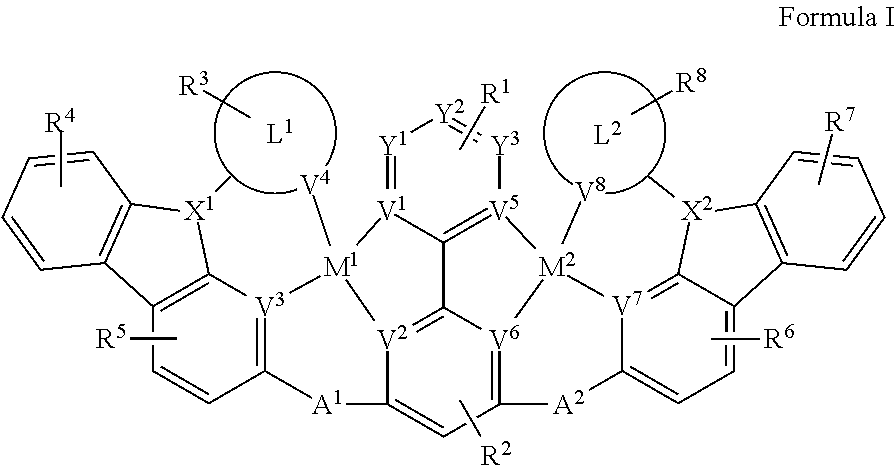
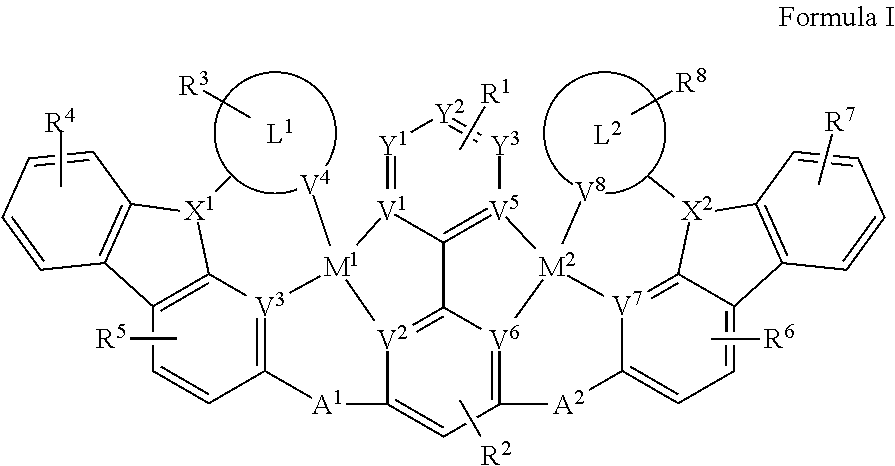


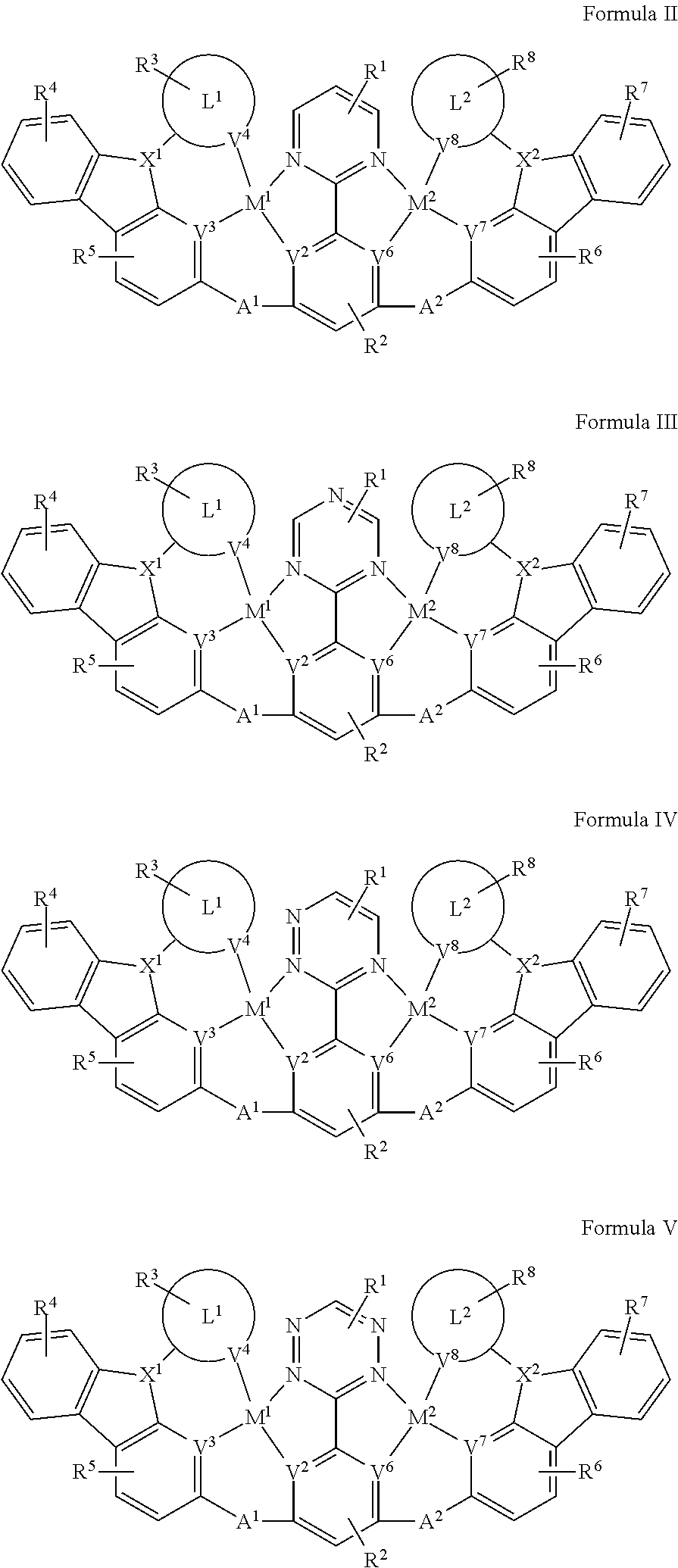
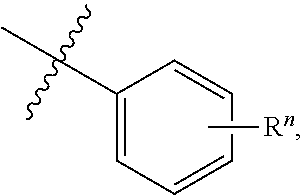
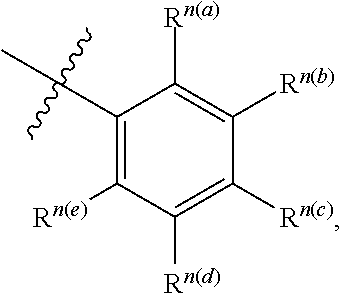

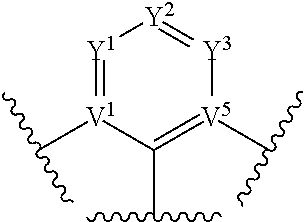
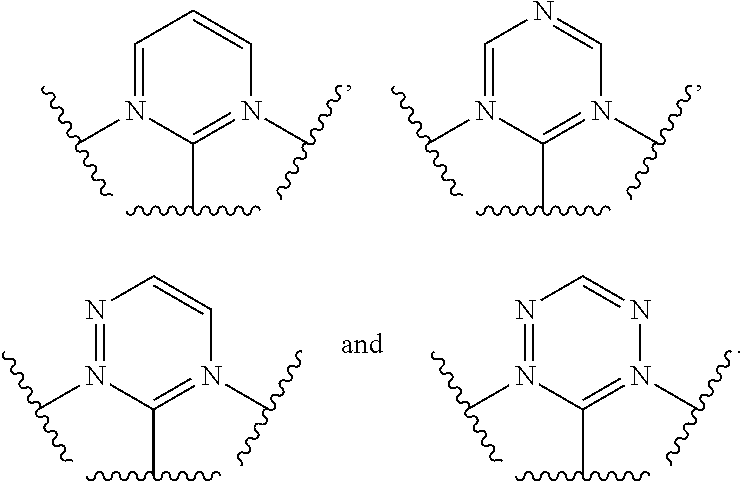
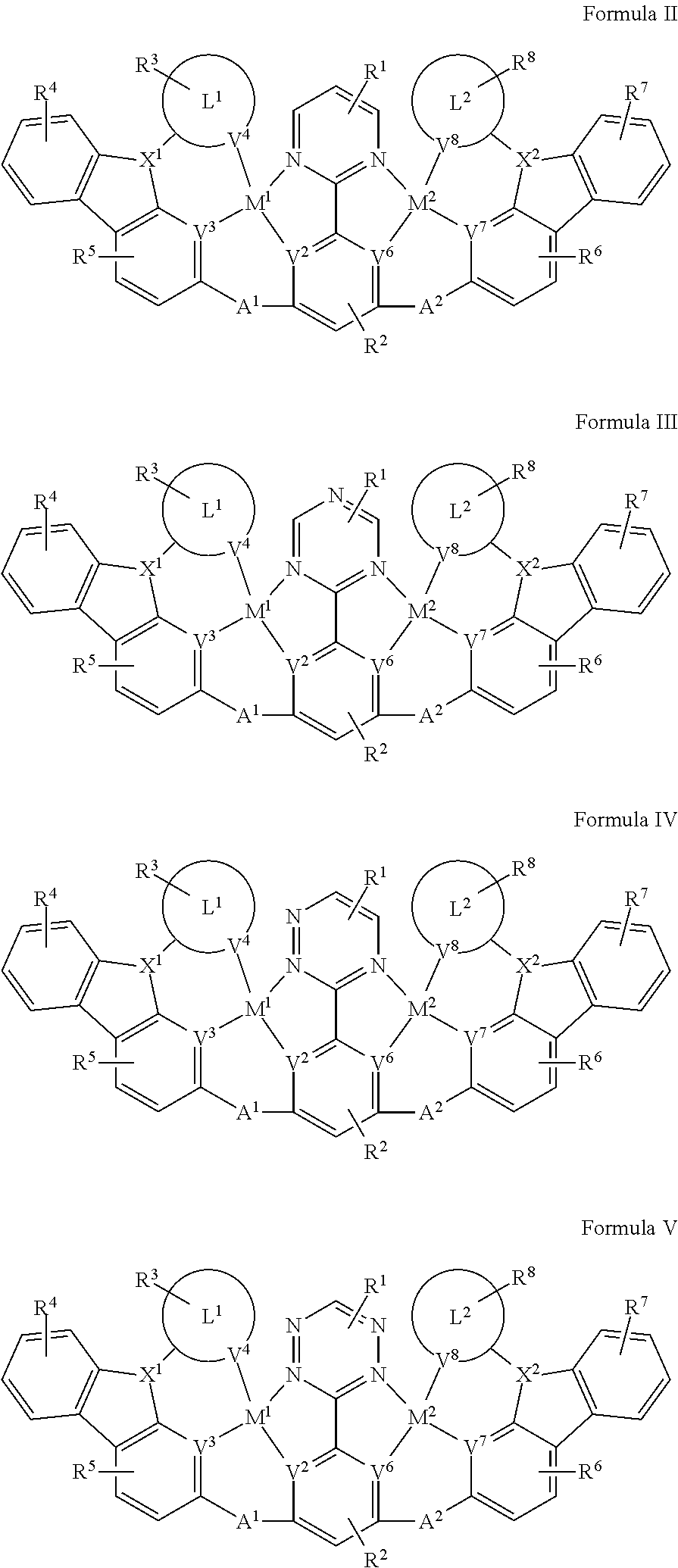

View All Diagrams
| United States Patent Application | 20190067598 |
| Kind Code | A1 |
| LI; Guijie ; et al. | February 28, 2019 |
MULTIDENTATE DINUCLEAR CYCLOMETALLATED COMPLEXES CONTAINING N^C^C^N-N^C^C^N LIGAND
Abstract
Disclosed herein are multidentate dinuclear cyclometallated complexes. The complexes are suitable as emitting materials or host materials in OLED devices. ##STR00001##
| Inventors: | LI; Guijie; (Hangzhou, CN) ; SHE; Yuanbin; (Hangzhou, CN) ; ZHAO; Xiangdong; (Hangzhou, CN) ; CHEN; Shaohai; (Saratoga, CA) | ||||||||||
| Applicant: |
|
||||||||||
|---|---|---|---|---|---|---|---|---|---|---|---|
| Family ID: | 61171377 | ||||||||||
| Appl. No.: | 15/785020 | ||||||||||
| Filed: | October 16, 2017 |
| Current U.S. Class: | 1/1 |
| Current CPC Class: | H01L 51/5016 20130101; C07D 239/02 20130101; H01L 51/0087 20130101; Y02E 10/549 20130101; C09K 11/06 20130101; C07F 15/006 20130101; H01L 51/009 20130101; C09K 2211/185 20130101; C09K 2211/1044 20130101; H01L 51/0084 20130101 |
| International Class: | H01L 51/00 20060101 H01L051/00; C09K 11/06 20060101 C09K011/06; C07F 15/00 20060101 C07F015/00 |
Foreign Application Data
| Date | Code | Application Number |
|---|---|---|
| Aug 31, 2017 | CN | 201710771918.X |
Claims
1. A compound of Formula I: ##STR00111## wherein each of L.sup.1 and L.sup.2 is independently a six-membered carbocyclic, heterocylic, heteroaryl ring; wherein V.sup.1, V.sup.2, V.sup.3, V.sup.4, V.sup.5, V.sup.6, V.sup.7 and V.sup.8 are coordinated with M.sup.1 or M.sup.2 and are each independently comprise N and C; and at least two of V.sup.1, V.sup.2, V.sup.3 and V.sup.4 are N, at least two of V.sup.5, V.sup.6, V.sup.7 and V.sup.8 are N; wherein each of A.sup.1 and A.sup.2 is independently selected from the group consisting O, S, CH.sub.2, CD.sub.2, CR.sup.aR.sup.b, C.dbd.O, SiR.sup.aR.sup.b, GeH.sub.2, GeR.sup.aR.sup.b NH, NR.sup.c, PH, PR.sup.c, R.sup.cP.dbd.O, AsR.sup.c, R.sup.cAs.dbd.O, S.dbd.O, SO.sub.2, Se, Se.dbd.O, SeO.sub.2, BH, BR.sup.c, R.sup.cBi.dbd.O, Bi, or BiR.sup.c; wherein each of X, X.sup.1 and X.sup.2 is independently selected from the group consisting N, B, CH, CD, CR.sup.a, SiH, SiD, SiR.sup.a, GeH, GeD, GeR.sup.d, P, P.dbd.O, As, As.dbd.O, Bi or Bi.dbd.O; wherein R.sup.1, R.sup.2, R.sup.3, R.sup.4, R.sup.5, R.sup.6, R.sup.7 and R.sup.8 may represent mono-, di, tri, tetra-substitutions, or no substitution, and R.sup.1, R.sup.2, R.sup.3, R.sup.4, R.sup.5, R.sup.6, R.sup.7, R.sup.8, R.sup.a, R.sup.b, R.sup.c and R.sup.d are independently selected from the group consisting hydrogen, deuterium, aryl, cycloalkyl, cycloalkenyl, heterocyclyl, heteroaryl, alkyl, alkenyl, alkynyl, halogen, hydroxyl, thiol, nitro, cyano, amino, a mono- or di-alkylamino, a mono- or diaryl amino, alkoxy, aryloxy, haloalkyl, aralkyl, ester, nitrile, isonitrile, heteroaryl, alkoxycarbonyl, acylamino, alkoxycarbonylamino, aryloxycarbonylamino, sulfonylamino, sulfamoyl, carbamoyl, alkylthio, sulfinyl, ureido, phosphoramide, amercapto, sulfo, carboxyl, hydrzino, substituted silyl, or polymerizable, or any conjugate or combination thereof. Two or more adjacent R.sup.1, R.sup.2, R.sup.3, R.sup.4, R.sup.5, R.sup.6, R.sup.7 and R.sup.8 are optionally joined to form a fused ring; wherein R.sup.a, R.sup.b, R.sup.c and R.sup.d may represent mono-, di, tri, tetra-substitutions, or no substitution, and R.sup.a, R.sup.b, R.sup.c and R.sup.d are independently selected from the group consisting hydrogen, deuterium, aryl, cycloalkyl, cycloalkenyl, heterocyclyl, heteroaryl, alkyl, alkenyl, alkynyl, halogen, hydroxyl, thiol, nitro, cyano, amino, a mono- or di-alkylamino, a mono- or diaryl amino, alkoxy, aryloxy, haloalkyl, aralkyl, ester, nitrile, isonitrile, heteroaryl, alkoxycarbonyl, acylamino, alkoxycarbonylamino, aryloxycarbonylamino, sulfonylamino, sulfamoyl, carbamoyl, alkylthio, sulfinyl, ureido, phosphoramide, amercapto, sulfo, carboxyl, hydrzino, substituted silyl, or polymerizable, or any conjugate or combination thereof.
2. The compound of claim 1, wherein ##STR00112## is selected from the group consisting ##STR00113##
3. The compound of claim 1, wherein the compound has one of the structure of Formula III, Formula IV, Formula V, or Formula VI: ##STR00114##
4. The compound of claim 1, wherein the compound has the structure of from Compound Pt1-Compound Pt262, Compound Pd1-Compound Pd262, Compound PtPd1-Compound PtPd262, Compound PdPt263-Compound PdPt291.
5. The compound of any one of claim 1, wherein the compound has a neutral charge.
6. The compound of any one of claim 2, wherein the compound has a neutral charge.
7. The compound of any one of claim 3, wherein the compound has a neutral charge.
8. The compound of any one of claim 4, wherein the compound has a neutral charge.
9. A device comprising any one of the composition of claim 1.
10. The device of claim 9, wherein the device comprises a full color display.
11. The device of claim 9, wherein the device is a photovoltaic device.
12. The device of claim 9, wherein the device is a luminescent display device.
13. The device of claim 9, wherein the device comprises an organic light emitting diode (OLED).
14. The device of claim 9, wherein the device comprises a phosphorescent organic light emitting diode.
15. The device of claim 9, wherein the device is a phosphorescent organic light emitting diode.
16. A light emitting device comprising the composition of claim 1.
17. A light emitting device comprising the composition of claim 2.
18. A light emitting device comprising the composition of claim 3.
19. A light emitting device comprising the composition of claim 4.
20. The device of claim 9, wherein the compound is selected to have 100% internal quantum efficiency in the device settings.
Description
TECHNICAL FIELD
[0001] The present disclosure relates to multidentate dinuclear cyclometallated complexes. The complexes are suitable as emitting materials or host materials in OLED devices.
BACKGROUND
[0002] Compounds capable of absorbing and/or emitting light can be ideally suited for use in a wide variety of optical and electroluminescent devices, including, for example, photo-absorbing devices such as solar- and photo-sensitive devices, organic light emitting diodes (OLEDs), photo-emitting devices, or devices capable of both photo-absorption and emission and as markers for bio-applications. Much research has been devoted to the discovery and optimization of organic and organometallic materials for using in optical and electroluminescent devices. Generally, research in this area aims to accomplish a number of goals, including improvements in absorption and emission efficiency, improvements in the stability of devices, as well as improvements in processing ability.
[0003] Despite significant advances in research devoted to optical and electro-optical materials, for example, red and green phosphorescent organometallic materials are commercial, and they have been used as phosphors in organic light emitting diodes (OLEDs), lighting and advanced displays. Many currently available materials exhibit a number of disadvantages, including poor processing ability, inefficient emission or absorption, and less than ideal stability, among others.
[0004] Especially, good blue emitters are very scarce. One big challenge is the stability of the blue devices. And the choice of the host materials has a great effect on the stability and the efficiency of the devices. The lowest triplet excited state energy of the blue phosphors is very high compared with that of the red and green phosphors, which means that the lowest triplet excited state energy of host materials for the blue devices should be even higher. So one of the problems is that there are very limited host materials to be used for the blue devices.
[0005] Generally, a chemical structural change will affect the electronic structure of the compounds, which thereby affects the optical properties of the compounds, for example, emission and absorption spectra. Thus, the compounds of this present invention can be tailored or tuned to a specific application that desires a particular emission or absorption characteristic. The optical properties of the metal compounds in this disclosure can be tuned by varying the structure of the ligand surrounding the metal center. For example, the metal compounds having a ligand with electron donating substituents or electron withdrawing substituents can be generally exhibit different optical properties, including emission and absorption spectra.
[0006] Owing to the potential of phosphorescent multidentate cyclometallated complexes for harvesting both electrogenerated singlet and triplet excitions to achieve 100% internal quantum efficiency, these complexes are good candidate for the emitting materials of OLEDs. Usually, there are "emitting portion" and "ancillary portion" in ligand of multidentate platinum complexe. If stabilizing substitution(s), such as conjugated group(s), aryl or heteroaromatic substitution(s) and so on, were introduced into the emitting portion. The "Highest Occupied Molecular Orbital" (HOMO) and/or "Lowest Unoccupied Molecular Orbital" (LUMO) energy level may be changed. So the energy gap between the HOMO and LUMO can be tuned. Thus the emission spectra of phosphorescent tetradentate platinum complexes can be modified to lesser or greater extents, such that the emission spectra can become narrower or broader, and/or such that the emission spectra can exhibit a blue shift or a red shift.
[0007] Thus, a need exists for new materials which exhibit improved performance in optical emitting and absorbing applications. Accordingly, such compounds, compositions, and devices comprising the same are disclosed herein.
SUMMARY
[0008] The present disclosure relates to multidentate dinuclear cyclometallated complexes. The complexes are suitable as emitting materials or host materials in OLED devices.
[0009] Disclosed herein are compounds of Formula I:
##STR00002##
[0010] wherein each of M.sup.1 and M.sup.2 is independently a platinum or palladium.
[0011] wherein each of L.sup.1 and L.sup.2 is independently a six-membered carbocyclic, heterocyclic, heteroaryl ring.
[0012] wherein V.sup.1, V.sup.2, V.sup.3, V.sup.4, V.sup.5, V.sup.6, V.sup.7 and V.sup.8 are coordinated with Pt or Pd and are each independently comprise N and C; and at least two of V.sup.1, V.sup.2, V.sup.3 and V.sup.4 are N, at least two of V.sup.5, V.sup.6. V.sup.7 and V.sup.8 are N.
[0013] wherein each of A.sup.1 and A.sup.2 is independently selected from the group consisting O, S, CH.sub.2, CD.sub.2, CR.sup.aR.sup.b, C.dbd.O, SiR.sup.aR.sup.b, GeH.sub.2, GeR.sup.aR.sup.b, NH, NR.sup.c, PH, PR.sup.c, R.sup.cP.dbd.O, AsR.sup.c, R.sup.cAs.dbd.O, S.dbd.O, SO.sub.2, Se, Se.dbd.O, SeO.sub.2, BH, BR.sup.c, R.sup.cBi.dbd.O, BiH, or BiR.sup.c.
[0014] wherein each of X.sup.1 and X.sup.2 is independently selected from the group consisting N, B, CH, CD.sub.2, CR.sup.a, SiH, SiD, SiR.sup.a, GeH.sub.2, GeD, GeR.sup.d, P, P.dbd.O, As, As.dbd.O, Bi or Bi.dbd.O.
[0015] wherein R.sup.1, R.sup.2, R.sup.3, R.sup.4, R.sup.5, R.sup.6, R.sup.7 and R.sup.8 may represent mono-, di, tri, tetra-substitutions, or no substitution, and R.sup.1, R.sup.2, R.sup.3, R.sup.4, R.sup.5, R.sup.6, R.sup.7, R.sup.8, R.sup.a, R.sup.b, R.sup.c and R.sup.d are independently selected from the group consisting hydrogen, deuterium, aryl, cycloalkyl, cycloalkenyl, heterocyclyl, heteroaryl, alkyl, alkenyl, alkynyl, halogen, hydroxyl, thiol, nitro, cyano, amino, a mono- or di-alkylamino, a mono- or diaryl amino, alkoxy, aryloxy, haloalkyl, aralkyl, ester, nitrile, isonitrile, heteroaryl, alkoxycarbonyl, acylamino, alkoxycarbonylamino, aryloxycarbonylamino, sulfonylamino, sulfamoyl, carbamoyl, alkylthio, sulfinyl, ureido, phosphoramide, amercapto, sulfo, carboxyl, hydrzino, substituted silyl, or polymerizable, or any conjugate or combination thereof. Two or more adjacent R.sup.1, R.sup.2, R.sup.3, R.sup.4, R.sup.5, R.sup.6, R.sup.7 and R.sup.8 are optionally joined to form a fused ring.
[0016] wherein R.sup.a, R.sup.b, R.sup.c and R.sup.d may represent mono-, di, tri, tetra-substitutions, or no substitution, and R.sup.a, R.sup.b, R.sup.c and R.sup.d are independently selected from the group consisting hydrogen, deuterium, aryl, cycloalkyl, cycloalkenyl, heterocyclyl, heteroaryl, alkyl, alkenyl, alkynyl, halogen, hydroxyl, thiol, nitro, cyano, amino, a mono- or di-alkylamino, a mono- or diaryl amino, alkoxy, aryloxy, haloalkyl, aralkyl, ester, nitrile, isonitrile, heteroaryl, alkoxycarbonyl, acylamino, alkoxycarbonylamino, aryloxycarbonylamino, sulfonylamino, sulfamoyl, carbamoyl, alkylthio, sulfinyl, ureido, phosphoramide, amercapto, sulfo, carboxyl, hydrzino, substituted silyl, or polymerizable, or any conjugate or combination thereof.
[0017] In one aspect,
##STR00003##
is selected from the group consisting
##STR00004##
[0018] In one aspect, the compound has the structure of Formula II, Formula III, Formula IV and Formula V:
##STR00005##
[0019] Also disclosed herein are compositions comprising one or more compounds disclosed herein.
[0020] Also disclosed herein are devices, such as OLEDs, comprising one or more compounds or compositions disclosed herein.
BRIEF DESCRIPTION OF THE FIGURES
[0021] The accompanying figures, which are incorporated in and constitute a part of this specification, illustrate several non-limiting aspects and together with the description serve to explain the principles of the invention.
[0022] FIG. 1 shows the .sup.1H NMR spectrum of Compound Pd1 in MDSO-d.sub.6.
[0023] FIG. 2 shows the High Resolution MS of Compound Pd 1.
[0024] FIG. 3 shows the PL spectrum of Compound Pd 1 in dichloromethane at room temperature.
[0025] Additional aspects of the invention will be set forth in part in the description which follows, and in part will be obvious from the description, or can be learned by practice of the invention. The advantages of the invention will be realized and attained by means of the elements and combinations particularly pointed out in the appended claims. It is to be understood that both the foregoing general description and the following detailed description are exemplary and explanatory only and are not restrictive of the invention, as claimed.
DETAILED DESCRIPTION
[0026] The present invention can be understood more readily by reference to the following detailed description of the invention and the Examples included therein.
[0027] Before the present compounds, devices, and/or methods are disclosed and described, it is to be understood that they are not limited to specific synthetic methods unless otherwise specified, or to particular reagents unless otherwise specified, as such can, of course, vary. It is also to be understood that the terminology used herein is for the purpose of describing particular aspects only and is not intended to be limiting. Although any methods and materials similar or equivalent to those described herein can be used in the practice or testing of the present invention, example methods and materials are now described.
[0028] As used in the specification and the appended claims, the singular forms "a", "an", and "the" include plural referents unless the context clearly dictates otherwise. Thus, for example, reference to "a component" includes mixtures of two or more components.
[0029] As used herein, the terms "optional" or "optionally" means that the subsequently described event or circumstance can or cannot occur, and that the description includes instances where said event or circumstance occurs and instances where it does not.
[0030] Disclosed are the components to be used to prepare the compositions of the invention as well as the compositions themselves to be used within the methods disclosed herein. These and other materials are disclosed herein, and it is understood that when combinations, subsets, interactions, groups, etc. of these materials are disclosed that while specific reference of each various individual and collective combinations and permutation of these compounds cannot be explicitly disclosed, each is specifically contemplated and described herein. For example, if a particular compound is disclosed and discussed and a number of modifications that can be made to a number of molecules including the compounds are discussed, specifically contemplated is each and every combination and permutation of the compound and the modifications that are possible unless specifically indicated to the contrary. Thus, if a class of molecules A, B, and C are disclosed as well as a class of molecules D, E, and F and an example of a combination molecule, A-D is disclosed, then even if each is not individually recited each is individually and collectively contemplated meaning combinations, A-E, A-F, B-D, B-E, B-F, C-D, C-E, and C-F are considered disclosed. Likewise, any subset or combination of these is also disclosed. Thus, for example, the sub-group of A-E, B-F, and C-E would be considered disclosed. This concept applies to all aspects of this application including, but not limited to, steps in methods of making and using the compositions of the invention. Thus, if there are a variety of additional steps that can be performed it is understood that each of these additional steps can be performed with any specific embodiment or combination of embodiments of the methods of the invention.
[0031] As referred to herein, a linking atom can connect two groups such as, for example, an N and C group. A linking group is in one aspect disclosed as A, A.sup.1, and/or A.sup.3 herein. The linking atom can optionally, if valency permits, have other chemical moieties attached. For example, in one aspect, an oxygen would not have any other chemical groups attached as the valency is satisfied once it is bonded to two groups (e.g., N and/or C groups). In another aspect, when carbon is the linking atom, two additional chemical moieties can be attached to the carbon. Suitable chemical moieties includes, but are not limited to, hydrogen, hydroxyl, alkyl, alkoxy, .dbd.O, halogen, nitro, amine, amide, thiol, aryl, heteroaryl, cycloalkyl, and heterocyclyl.
[0032] The term "cyclic structure" or the like terms used herein refer to any cyclic chemical structure which includes, but is not limited to, aryl, heteroaryl, cycloalkyl, cycloalkenyl, heterocyclyl, carbene, and N-heterocyclic carbene.
[0033] As used herein, the term "substituted" is contemplated to include all permissible substituents of organic compounds. In a broad aspect, the permissible substituents include acyclic and cyclic, branched and unbranched, carbocyclic and heterocyclic, and aromatic and nonaromatic substituents of organic compounds. Illustrative substituents include, for example, those described below. The permissible substituents can be one or more and the same or different for appropriate organic compounds. For purposes of this disclosure, the heteroatoms, such as nitrogen, can have hydrogen substituents and/or any permissible substituents of organic compounds described herein which satisfy the valences of the heteroatoms. This disclosure is not intended to be limited in any manner by the permissible substituents of organic compounds. Also, the terms "substitution" or "substituted with" include the implicit proviso that such substitution is in accordance with permitted valence of the substituted atom and the substituent, and that the substitution results in a stable compound, e.g., a compound that does not spontaneously undergo transformation such as by rearrangement, cyclization, elimination, etc. It is also contemplated that, in certain aspects, unless expressly indicated to the contrary, individual substituents can be further optionally substituted (i.e., further substituted or unsubstituted).
[0034] In defining various terms, "R.sup.1," "R.sup.2," "R.sup.3," and "R.sup.4" are used herein as generic symbols to represent various specific substituents. These symbols can be any substituent, not limited to those disclosed herein, and when they are defined to be certain substituents in one instance, they can, in another instance, be defined as some other substituents.
[0035] The term "alkyl" as used herein is a branched or unbranched saturated hydrocarbon group of 1 to 24 carbon atoms, such as methyl, ethyl, n-propyl, isopropyl, n-butyl, isobutyl, s-butyl, t-butyl, n-pentyl, isopentyl, s-pentyl, neopentyl, hexyl, heptyl, octyl, nonyl, decyl, dode cyl, tetradecyl, hexadecyl, eicosyl, tetracosyl, and the like. The alkyl group can be cyclic or acyclic. The alkyl group can be branched or unbranched. The alkyl group can also be substituted or unsubstituted. For example, the alkyl group can be substituted with one or more groups including, but not limited to, alkyl, cycloalkyl, alkoxy, amino, ether, halide, hydroxy, nitro, silyl, sulfo-oxo, or thiol, as described herein. A "lower alkyl" group is an alkyl group containing from one to six (e.g., from one to four) carbon atoms.
[0036] Throughout the specification "alkyl" is generally used to refer to both unsubstituted alkyl groups and substituted alkyl groups; however, substituted alkyl groups are also specifically referred to herein by identifying the specific substituent(s) on the alkyl group. For example, the term "halogenated alkyl" or "haloalkyl" specifically refers to an alkyl group that is substituted with one or more halide, e.g., fluorine, chlorine, bromine, or iodine. The term "alkoxyalkyl" specifically refers to an alkyl group that is substituted with one or more alkoxy groups, as described below. The term "alkylamino" specifically refers to an alkyl group that is substituted with one or more amino groups, as described below, and the like. When "alkyl" is used in one instance and a specific term such as "alkylalcohol" is used in another, it is not meant to imply that the term "alkyl" does not also refer to specific terms such as "alkylalcohol" and the like.
[0037] This practice is also used for other groups described herein. That is, while a term such as "cycloalkyl" refers to both unsubstituted and substituted cycloalkyl moieties, the substituted moieties can, in addition, be specifically identified herein; for example, a particular substituted cycloalkyl can be referred to as, e.g., an "alkylcycloalkyl." Similarly, a substituted alkoxy can be specifically referred to as, e.g., a "halogenated alkoxy," a particular substituted alkenyl can be, e.g., an "alkenylalcohol," and the like. Again, the practice of using a general term, such as "cycloalkyl," and a specific term, such as "alkylcycloalkyl," is not meant to imply that the general term does not also include the specific term.
[0038] The term "cycloalkyl" as used herein is a non-aromatic carbon-based ring composed of at least three carbon atoms. Examples of cycloalkyl groups include, but are not limited to, cyclopropyl, cyclobutyl, cyclopentyl, cyclohexyl, norbornyl, and the like. The term "heterocycloalkyl" is a type of cycloalkyl group as defined above, and is included within the meaning of the term "cycloalkyl," where at least one of the carbon atoms of the ring is replaced with a heteroatom such as, but not limited to, nitrogen, oxygen, sulfur, or phosphorus. The cycloalkyl group and heterocycloalkyl group can be substituted or unsubstituted. The cycloalkyl group and heterocycloalkyl group can be substituted with one or more groups including, but not limited to, alkyl, cycloalkyl, alkoxy, amino, ether, halide, hydroxy, nitro, silyl, sulfo-oxo, or thiol as described herein.
[0039] The term "polyalkylene group" as used herein is a group having two or more CH.sub.2 groups linked to one another. The polyalkylene group can be represented by the formula --(CH.sub.2).sub.a--, where "a" is an integer of from 2 to 500.
[0040] The terms "alkoxy" and "alkoxyl" as used herein to refer to an alkyl or cycloalkyl group bonded through an ether linkage, that is, an "alkoxy" group can be defined as --OR.sup.1 where R.sup.1 is alkyl or cycloalkyl as defined above. "Alkoxy" also includes polymers of alkoxy groups as just described; that is, an alkoxy can be a polyether such as --OR.sup.1--OR.sup.2 or --OR.sup.1--(OR.sup.2).sub.a--OR.sup.3, where "a" is an integer of from 1 to 200 and R.sup.1, R.sup.2, and R.sup.3 are alkyl and/or cycloalkyl groups.
[0041] The term "alkenyl" as used herein is a hydrocarbon group of from 2 to 24 carbon atoms with a structural formula containing at least one carbon-carbon double bond. Asymmetric structures such as (R.sup.1R.sup.2)C.dbd.C(R.sup.3R.sup.4) are intended to include both the E and Z isomers. This can be presumed in structural formulae herein wherein an asymmetric alkene is present, or it can be explicitly indicated by the bond symbol C.dbd.C. The alkenyl group can be substituted with one or more groups including, but not limited to, alkyl, cycloalkyl, alkoxy, alkenyl, cycloalkenyl, alkynyl, cycloalkynyl, aryl, heteroaryl, aldehyde, amino, carboxylic acid, ester, ether, halide, hydroxy, ketone, azide, nitro, silyl, sulfo-oxo, or thiol, as described herein.
[0042] The term "cycloalkenyl" as used herein is a non-aromatic carbon-based ring composed of at least three carbon atoms and containing at least one carbon-carbon double bound, i.e., C.dbd.C. Examples of cycloalkenyl groups include, but are not limited to, cyclopropenyl, cyclobutenyl, cyclopentenyl, cyclopentadienyl, cyclohexenyl, cyclohexadienyl, norbornenyl, and the like. The term "heterocycloalkenyl" is a type of cycloalkenyl group as defined above, and is included within the meaning of the term "cycloalkenyl," where at least one of the carbon atoms of the ring is replaced with a heteroatom such as, but not limited to, nitrogen, oxygen, sulfur, or phosphorus. The cycloalkenyl group and heterocycloalkenyl group can be substituted or unsubstituted. The cycloalkenyl group and heterocycloalkenyl group can be substituted with one or more groups including, but not limited to, alkyl, cycloalkyl, alkoxy, alkenyl, cycloalkenyl, alkynyl, cycloalkynyl, aryl, heteroaryl, aldehyde, amino, carboxylic acid, ester, ether, halide, hydroxy, ketone, azide, nitro, silyl, sulfo-oxo, or thiol as described herein.
[0043] The term "alkynyl" as used herein is a hydrocarbon group of 2 to 24 carbon atoms with a structural formula containing at least one carbon-carbon triple bond. The alkynyl group can be unsubstituted or substituted with one or more groups including, but not limited to, alkyl, cycloalkyl, alkoxy, alkenyl, cycloalkenyl, alkynyl, cycloalkynyl, aryl, heteroaryl, aldehyde, amino, carboxylic acid, ester, ether, halide, hydroxy, ketone, azide, nitro, silyl, sulfo-oxo, or thiol, as described herein.
[0044] The term "cycloalkynyl" as used herein is a non-aromatic carbon-based ring composed of at least seven carbon atoms and containing at least one carbon-carbon triple bound. Examples of cycloalkynyl groups include, but are not limited to, cycloheptynyl, cyclooctynyl, cyclononynyl, and the like. The term "heterocycloalkynyl" is a type of cycloalkenyl group as defined above, and is included within the meaning of the term "cycloalkynyl," where at least one of the carbon atoms of the ring is replaced with a heteroatom such as, but not limited to, nitrogen, oxygen, sulfur, or phosphorus. The cycloalkynyl group and heterocycloalkynyl group can be substituted or unsubstituted. The cycloalkynyl group and heterocycloalkynyl group can be substituted with one or more groups including, but not limited to, alkyl, cycloalkyl, alkoxy, alkenyl, cycloalkenyl, alkynyl, cycloalkynyl, aryl, heteroaryl, aldehyde, amino, carboxylic acid, ester, ether, halide, hydroxy, ketone, azide, nitro, silyl, sulfo-oxo, or thiol as described herein.
[0045] The term "aryl" as used herein is a group that contains any carbon-based aromatic group including, but not limited to, benzene, naphthalene, phenyl, biphenyl, phenoxybenzene, and the like. The term "aryl" also includes "heteroaryl," which is defined as a group that contains an aromatic group that has at least one heteroatom incorporated within the ring of the aromatic group. Examples of heteroatoms include, but are not limited to, nitrogen, oxygen, sulfur, and phosphorus. Likewise, the term "non-heteroaryl," which is also included in the term "aryl," defines a group that contains an aromatic group that does not contain a heteroatom. The aryl group can be substituted or unsubstituted. The aryl group can be substituted with one or more groups including, but not limited to, alkyl, cycloalkyl, alkoxy, alkenyl, cycloalkenyl, alkynyl, cycloalkynyl, aryl, heteroaryl, aldehyde, amino, carboxylic acid, ester, ether, halide, hydroxy, ketone, azide, nitro, silyl, sulfo-oxo, or thiol as described herein. The term "biaryl" is a specific type of aryl group and is included in the definition of "aryl." Biaryl refers to two aryl groups that are bound together via a fused ring structure, as in naphthalene, or are attached via one or more carbon-carbon bonds, as in biphenyl.
[0046] The term "aldehyde" as used herein is represented by the formula --C(O)H. Throughout this specification "C(O)" is a short hand notation for a carbonyl group, i.e., C.dbd.O.
[0047] The terms "amine" or "amino" as used herein are represented by the formula --NR.sup.1R.sup.2, where R.sup.1 and R.sup.2 can be, independently, hydrogen or alkyl, cycloalkyl, alkenyl, cycloalkenyl, alkynyl, cycloalkynyl, aryl, or heteroaryl group as described herein.
[0048] The term "alkylamino" as used herein is represented by the formula --NH(-alkyl) where alkyl is a described herein. Representative examples include, but are not limited to, methylamino group, ethylamino group, propylamino group, isopropylamino group, butylamino group, isobutylamino group, (sec-butyl)amino group, (tert-butyl)amino group, pentylamino group, isopentylamino group, (tert-pentyl)amino group, hexylamino group, and the like.
[0049] The term "dialkylamino" as used herein is represented by the formula --N(-alkyl).sub.2 where alkyl is a described herein. Representative examples include, but are not limited to, dimethylamino group, diethylamino group, dipropylamino group, diisopropylamino group, dibutylamino group, diisobutylamino group, di(sec-butyl)amino group, di(tert-butyl)amino group, dipentylamino group, diisopentylamino group, di(tert-pentyl)amino group, dihexylamino group, N-ethyl-N-methylamino group, N-methyl-N-propylamino group, N-ethyl-N-propylamino group and the like.
[0050] The term "carboxylic acid" as used herein is represented by the formula --C(O)OH.
[0051] The term "ester" as used herein is represented by the formula --OC(O)R.sup.1 or --C(O)OR.sup.1, where R.sup.1 can be alkyl, cycloalkyl, alkenyl, cycloalkenyl, alkynyl, cycloalkynyl, aryl, or heteroaryl group as described herein. The term "polyester" as used herein is represented by the formula --(R.sup.1O(O)C--R.sup.2--C(O)O).sub.a-- or --(R.sup.1O(O)C--R.sup.2--OC(O))--, where R.sup.1 and R.sup.2 can be, independently, an alkyl, cycloalkyl, alkenyl, cycloalkenyl, alkynyl, cycloalkynyl, aryl, or heteroaryl group described herein and "a" is an integer from 1 to 500. "Polyester" is as the term used to describe a group that is produced by the reaction between a compound having at least two carboxylic acid groups with a compound having at least two hydroxyl groups.
[0052] The term "ether" as used herein is represented by the formula R.sup.1OR.sup.2, where R.sup.1 and R.sup.2 can be, independently, an alkyl, cycloalkyl, alkenyl, cycloalkenyl, alkynyl, cycloalkynyl, aryl, or heteroaryl group described herein. The term "polyether" as used herein is represented by the formula --(R.sup.1O--R.sup.2O).sub.a--, where R.sup.1 and R.sup.2 can be, independently, an alkyl, cycloalkyl, alkenyl, cycloalkenyl, alkynyl, cycloalkynyl, aryl, or heteroaryl group described herein and "a" is an integer of from 1 to 500. Examples of polyether groups include polyethylene oxide, polypropylene oxide, and polybutylene oxide.
[0053] The term "halide" as used herein refers to the halogens fluorine, chlorine, bromine, and iodine.
[0054] The term "heterocyclyl," as used herein refers to single and multi-cyclic non-aromatic ring systems and "heteroaryl as used herein refers to single and multi-cyclic aromatic ring systems: in which at least one of the ring members is other than carbon. The terms includes azetidine, dioxane, furan, imidazole, isothiazole, isoxazole, morpholine, oxazole, oxazole, including, 1,2,3-oxadiazole, 1,2,5-oxadiazole and 1,3,4-oxadiazole, piperazine, piperidine, pyrazine, pyrazole, pyridazine, pyridine, pyrimidine, pyrrole, pyrrolidine, tetrahydrofuran, tetrahydropyran, tetrazine, including 1,2,4,5-tetrazine, tetrazole, including 1,2,3,4-tetrazole and 1,2,4,5-tetrazole, thiadiazole, including, 1,2,3-thiadiazole, 1,2,5-thiadiazole, and 1,3,4-thiadiazole, thiazole, thiophene, triazine, including 1,3,5-triazine and 1,2,4-triazine, triazole, including, 1,2,3-triazole, 1,3,4-triazole, and the like.
[0055] The term "hydroxyl" as used herein is represented by the formula --OH.
[0056] The term "ketone" as used herein is represented by the formula R.sup.1C(O)R.sup.2, where R.sup.1 and R.sup.2 can be, independently, an alkyl, cycloalkyl, alkenyl, cycloalkenyl, alkynyl, cycloalkynyl, aryl, or heteroaryl group as described herein.
[0057] The term "azide" as used herein is represented by the formula --N.sub.3.
[0058] The term "nitro" as used herein is represented by the formula --NO.sub.2.
[0059] The term "nitrile" as used herein is represented by the formula --CN.
[0060] The term "silyl" as used herein is represented by the formula --SiR.sup.1R.sup.2R.sup.1, where R.sup.1, R.sup.2, and R.sup.3 can be, independently, hydrogen or an alkyl, cycloalkyl, alkoxy, alkenyl, cycloalkenyl, alkynyl, cycloalkynyl, aryl, or heteroaryl group as described herein.
[0061] The term "sulfo-oxo" as used herein is represented by the formulas --S(O)R.sup.1, --S(O).sub.2R.sup.1, --OS(O).sub.2R', or --OS(O).sub.2OR', where R.sup.1 can be hydrogen or an alkyl, cycloalkyl, alkenyl, cycloalkenyl, alkynyl, cycloalkynyl, aryl, or heteroaryl group as described herein. Throughout this specification "S(O)" is a short hand notation for S.dbd.O. The term "sulfonyl" is used herein to refer to the sulfo-oxo group represented by the formula --S(O).sub.2R.sup.1, where R.sup.1 can be hydrogen or an alkyl, cycloalkyl, alkenyl, cycloalkenyl, alkynyl, cycloalkynyl, aryl, or heteroaryl group as described herein. The term "sulfone" as used herein is represented by the formula R.sup.1S(O).sub.2R.sup.2, where R.sup.1 and R.sup.2 can be, independently, an alkyl, cycloalkyl, alkenyl, cycloalkenyl, alkynyl, cycloalkynyl, aryl, or heteroaryl group as described herein. The term "sulfoxide" as used herein is represented by the formula R.sup.1S(O)R.sup.2, where R.sup.1 and R.sup.2 can be, independently, an alkyl, cycloalkyl, alkenyl, cycloalkenyl, alkynyl, cycloalkynyl, aryl, or heteroaryl group as described herein.
[0062] The term "thiol" as used herein is represented by the formula --SH.
[0063] "R.sup.1," "R.sup.2," "R.sup.3," "R.sup.n," where n is an integer, as used herein can, independently, possess one or more of the groups listed above. For example, if R.sup.1 is a straight chain alkyl group, one of the hydrogen atoms of the alkyl group can optionally be substituted with a hydroxyl group, an alkoxy group, an alkyl group, a halide, and the like. Depending upon the groups that are selected, a first group can be incorporated within second group or, alternatively, the first group can be pendant (i.e., attached) to the second group. For example, with the phrase "an alkyl group comprising an amino group," the amino group can be incorporated within the backbone of the alkyl group. Alternatively, the amino group can be attached to the backbone of the alkyl group. The nature of the group(s) that is (are) selected will determine if the first group is embedded or attached to the second group.
[0064] As described herein, compounds of the invention may contain "optionally substituted" moieties. In general, the term "substituted." whether preceded by the term "optionally" or not, means that one or more hydrogens of the designated moiety are replaced with a suitable substituent. Unless otherwise indicated, an "optionally substituted" group may have a suitable substituent at each substitutable position of the group, and when more than one position in any given structure may be substituted with more than one substituent selected from a specified group, the substituent may be either the same or different at every position. Combinations of substituents envisioned by this invention are preferably those that result in the formation of stable or chemically feasible compounds. In is also contemplated that, in certain aspects, unless expressly indicated to the contrary, individual substituents can be further optionally substituted (i.e., further substituted or unsubstituted).
[0065] In some aspects, a structure of a compound can be represented by a formula:
##STR00006##
which is understood to be equivalent to a formula:
##STR00007##
wherein n is typically an integer. That is, R.sup.n is understood to represent five independent substituents, R.sup.n(a), R.sup.n(b), R.sup.n(c), R.sup.n(d), R.sup.n(e). By "independent substituents," it is meant that each R substituent can be independently defined. For example, if in one instance R.sup.n(a) is halogen, then R.sup.n(b) is not necessarily halogen in that instance.
[0066] Several references to R.sup.1, R.sup.2, R.sup.3, R.sup.4, R.sup.5, R.sup.6, etc. are made in chemical structures and moieties disclosed and described herein. Any description of R.sup.1, R.sup.2, R.sup.3, R.sup.4, R.sup.5, R.sup.6, etc. in the specification is applicable to any structure or moiety reciting R.sup.1, R.sup.2, R.sup.3, R.sup.4, R.sup.5, R.sup.6, etc. respectively.
1. Compounds
[0067] Opto-electronic devices that make use of organic materials are becoming increasingly desirable for a number of reasons. Many of the materials used to make such devices are relatively inexpensive, so organic opto-electronic devices have the potential for cost advantages over inorganic devices. In addition, the inherent properties of organic materials, such as their flexibility, may make them well suited for particular applications such as fabrication on a flexible substrate. Examples of organic opto-electronic devices include organic light emitting devices (OLEDs), organic phototransistors, organic photovoltaic cells, and organic photodetectors. For OLEDs, the organic materials may have performance advantages over conventional materials. For example, the wavelength at which an organic emissive layer emits light may generally be readily tuned with appropriate dopants.
[0068] Excitons decay from singlet excited states to ground state to yield prompt luminescence, which is fluorescence. If Excitons decay from triplet excited states to ground state to generate luminescence, which is phosphorescence. Because the strong spin-orbit coupling of the heavy metal atom enhances intersystem crossing (ISC) very efficiently between singlet and triplet excited state, phosphorescent metal complexes, such as platinum complexes, have demonstrated their potential to harvest both the singlet and triplet excitons to achieve 100% internal quantum efficiency. Thus phosphorescent metal complexes are good candidates as dopants in the emissive layer of organic light emitting devices (OLEDs) and a great deal of attention has been received both in the academic and industrial fields. And much achievement has been made in the past decade to led to the lucrative commercialization of the technology, for example, OLEDs have been used in advanced displays in smart phones, televisions and digital cameras.
[0069] However, to date, blue electroluminescent devices remain the most challenging area of this technology, one big problem is the stability of the blue devices. It has been proved that the choice of host materials is very important to the stability of the blue devices. But the lowest triplet excited state (T.sub.1) energy of the blue phosphors is very high, which means that the lowest triplet excited state (T.sub.1) energy of host materials for the blue devices should be even higher. This leads to much difficulty in the development of the host materials for the blue devices.
[0070] The metal complexes of this present invention can be tailored or tuned to a specific application that desires a particular emission or absorption characteristic. The optical properties of the metal complexes in this disclosure can be tuned by varying the structure of the ligand surrounding the metal center or varying the structure of fluorescent luminophore(s) on the ligands. For example, the metal complexes having a ligand with electron donating substituents or electron withdrawing substituents can be generally exhibit different optical properties, including emission and absorption spectra. The color of the metal complexes can be tuned by modifying the conjugated groups on the fluorescent luminophores and ligands.
[0071] The emission of such inventive complexes can be tuned, for example, from the ultraviolet to near-infrared, by, for example, modifying the ligand or fluorescent luminophore structure. A fluorescent luminophore is a group of atoms in an organic molecule, which can absorb energy to generate singlet excited state(s), the singlet exciton(s) produce(s) decay rapidly to yield prompt luminescence. In another aspect, the inventive complexes can provide emission over a majority of the visible spectrum. In a specific example, the inventive complexes can emit light over a range of from about 400 nm to about 700 nm. In another aspect, the inventive complexes have improved stability and efficiency over traditional emission complexes. In yet another aspect, the inventive complexes can be useful as luminescent labels in, for example, bio-applications, anti-cancer agents, emitters in organic light emitting diodes (OLED), or a combination thereof. In another aspect, the inventive complexes can be useful in light emitting devices, such as, for example, compact fluorescent lamps (CFL), light emitting diodes (LED), incandescent lamps, and combinations thereof.
[0072] Disclosed herein are compounds or compound complexes comprising platinum. The terms compound or compound complex are used interchangeably herein. In one aspect, the compounds discloses herein have a neutral charge.
[0073] The compounds disclosed herein, can exhibit desirable properties and have emission and/or absorption spectra that can be tuned via the selection of appropriate ligands. In another aspect, the present invention can exclude any one or more of the compounds, structures, or portions thereof, specifically recited herein.
[0074] The compounds disclosed herein are suited for use in a wide variety of optical and electro-optical devices, including, but not limited to, photo-absorbing devices such as solar- and photo-sensitive devices, organic light emitting diodes (OLEDs), photo-emitting devices, or devices capable of both photo-absorption and emission and as markers for bio-applications.
[0075] As briefly described above, the disclosed compounds are platinum complexes. In one aspect, the compounds disclosed herein can be used as host materials for OLED applications, such as full color displays.
[0076] The compounds disclosed herein are useful in a variety of applications. As light emitting materials, the compounds can be useful in organic light emitting diodes (OLED)s, luminescent devices and displays, and other light emitting devices.
[0077] In another aspect, the compounds can provide improved efficiency and/or operational lifetimes in lighting devices, such as, for example, organic light emitting devices, as compared to conventional materials.
[0078] The compounds of the invention can be made using a variety of methods, including, but not limited to those recited in the examples provided herein.
[0079] The compound disclosed herein can be a delayed fluorescent and/or phosphorescent emitter. In one aspect, the compounds disclosed herein can be a delayed fluorescent emitter. In another aspect, the compounds disclosed herein can be a phosphorescent emitter. In yet another aspect, the compounds disclosed herein can be a delayed fluorescent emitter and a phosphorescent emitter.
[0080] The present disclosure relates to multidentate dinuclear cyclometallated complexes. The complexes are suitable as emitting materials or host materials in OLED devices.
[0081] Disclosed herein are compounds of Formula I:
##STR00008##
[0082] wherein each of M.sup.1 and M.sup.2 is independently a platinum or palladium.
[0083] wherein each of L.sup.1 and L.sup.2 is independently a six-membered carbocyclic, heterocyclic, heteroaryl ring.
[0084] wherein V.sup.1, V.sup.2, V.sup.3. V.sup.4, V.sup.5, V.sup.6, V.sup.7 and V.sup.8 are coordinated with Pt and are each independently comprise N and C; and at least two of V.sup.1, V.sup.2, V.sup.3 and V.sup.7 are N, at least two of V.sup.5, V.sup.6, V.sup.7 and V.sup.8 are N.
[0085] wherein each of A.sup.1 and A.sup.2 is independently selected from the group consisting O, S, CH.sub.2, CD.sub.2, CR.sup.aR.sup.b, C.dbd.O, SiR.sup.aR.sup.b, GeH.sub.2, GeR.sup.aR.sup.b, NH, NR.sup.c, PH, PR.sup.c, R.sup.cP.dbd.O, AsR.sup.c, R.sup.cAs.dbd.O, S.dbd.O, SO.sub.2, Se, Se.dbd.O, SeO.sub.2, BH, BR.sup.c, R.sup.cBi.dbd.O, BiH, or BiR.sup.c.
[0086] wherein each of X.sup.1 and X.sup.2 is independently selected from the group consisting N, B, CH, CD.sub.2, CR.sup.a, SiH, SiD, SiR.sup.a, GeH.sub.2, GeD, GeR.sup.d, P, P.dbd.O, As, As.dbd.O, Bi or Bi.dbd.O.
[0087] wherein R.sup.1, R.sup.2, R.sup.3, R.sup.4, R.sup.5, R.sup.6, R.sup.7 and R.sup.8 may represent mono-, di, tri, tetra-substitutions, or no substitution, and R.sup.1, R.sup.2, R.sup.3, R.sup.4, R.sup.5, R.sup.6, R.sup.7, R.sup.8, R.sup.a, R.sup.b, R.sup.c and R.sup.d are independently selected from the group consisting hydrogen, deuterium, aryl, cycloalkyl, cycloalkenyl, heterocyclyl, heteroaryl, alkyl, alkenyl, alkynyl, halogen, hydroxyl, thiol, nitro, cyano, amino, a mono- or di-alkylamino, a mono- or diaryl amino, alkoxy, aryloxy, haloalkyl, aralkyl, ester, nitrile, isonitrile, heteroaryl, alkoxycarbonyl, acylamino, alkoxycarbonylamino, aryloxycarbonylamino, sulfonylamino, sulfamoyl, carbamoyl, alkylthio, sulfinyl, ureido, phosphoramide, amercapto, sulfo, carboxyl, hydrzino, substituted silyl, or polymerizable, or any conjugate or combination thereof. Two or more adjacent R.sup.1, R.sup.2, R.sup.3, R.sup.4, R.sup.5, R.sup.6, R.sup.7 and R.sup.8 are optionally joined to form a fused ring.
[0088] wherein R.sup.a, R.sup.b, R.sup.c and R.sup.d may represent mono-, di, tri, tetra-substitutions, or no substitution, and R.sup.a, R.sup.b, R.sup.c and R.sup.d are independently selected from the group consisting hydrogen, deuterium, aryl, cycloalkyl, cycloalkenyl, heterocyclyl, heteroaryl, alkyl, alkenyl, alkynyl, halogen, hydroxyl, thiol, nitro, cyano, amino, a mono- or di-alkylamino, a mono- or diaryl amino, alkoxy, aryloxy, haloalkyl, aralkyl, ester, nitrile, isonitrile, heteroary, alkoxycarbonyl, acylamino, alkoxycarbonylamino, aryloxycarbonylamino, sulfonylamino, sulfamoyl, carbamoyl, alkylthio, sulfinyl, ureido, phosphoramide, amercapto, sulfo, carboxyl, hydrzino, substituted silyl, or polymerizable, or any conjugate or combination thereof.
[0089] In one aspect,
##STR00009##
is selected from the group consisting
##STR00010##
[0090] In one aspect, the compound has one of the structure of Formula II, Formula III, Formula IV and Formula V:
##STR00011##
A. M Groups
[0091] In one aspect, each of M.sup.1 and M.sup.2 is independently a platinum or palladium.
[0092] In another aspect, M.sup.1 is a platinum, M.sup.2 is a palladium.
[0093] In another aspect, M.sup.1 is a palladium, M.sup.2 is a platinum.
[0094] In another aspect, M.sup.1 is a platinum, M.sup.2 is also a platinum.
[0095] In another aspect, M.sup.1 is a palladium, M.sup.2 is also a palladium.
B. L Groups
[0096] In one aspect, L.sup.1 is a six-membered carbocyclic, heterocyclic, heteroaryl ring.
[0097] In another aspect, L.sup.2 is a six-membered carbocyclic, heterocyclic, heteroaryl ring.
C. V Groups
[0098] In one aspect, V.sup.1, V.sup.2, V.sup.3, V.sup.4, V.sup.5, V.sup.6, V.sup.7 and V.sup.8 are coordinated with M.sup.1 or M.sup.2 and are each independently comprise N and C; and at least two of V.sup.1, V.sup.2, V.sup.3 and V.sup.4 are N, at least two of V.sup.5, V.sup.6, V.sup.7 and V.sup.8 are N.
[0099] In another aspect, V.sup.1 and V.sup.4 are N, V.sup.2 and V.sup.3 are C, V.sup.5 and V.sup.8 are N, V.sup.6 and V.sup.7 are C.
[0100] In yet another aspect, V.sup.1, V.sup.2 and V.sup.3 are C, and V.sup.4 is N, V.sup.5 and V.sup.8 are N, V.sup.6 and V.sup.7 are C.
[0101] In yet another aspect, V.sup.1 and V.sup.3 are C, V.sup.2 and V.sup.4 are N, V.sup.5 and V.sup.7 are C, V.sup.6 and V.sup.8 are N.
D. A Groups
[0102] In one aspect, each of A.sup.1 and A.sup.2 is independently selected from the group consisting O, S, CH.sub.2, CD.sub.2, CR.sup.aR.sup.b, C.dbd.O, SiR.sup.aR.sup.b, GeH.sub.2, GeR.sup.aR.sup.b, NH, NR.sup.c, PH, PR.sup.c, R.sup.cP.dbd.O, AsR.sup.c, R.sup.cAs.dbd.O, S.dbd.O, SO.sub.2, Se, Se.dbd.O, SeO.sub.2, BH, BR.sup.c, R.sup.cBi.dbd.O, BiH, or BiR.sup.c.
[0103] In another aspect, A.sup.1 is O, A.sup.2 is O.
[0104] In another aspect, A.sup.1 is O, A.sup.2 is S.
[0105] In another aspect, A.sup.1 is CR.sup.aR.sup.b, A.sup.2 is CR.sup.aR.sup.b.
[0106] In another aspect, A.sup.1 is NR.sup.c, A.sup.2 is NR.sup.c.
[0107] In another aspect, A.sup.1 is O, A.sup.2 is NR.sup.c.
[0108] In another aspect, A.sup.1 is CR.sup.aR.sup.b, A.sup.2 is NR.sup.c.
[0109] In yet another aspect, A.sup.1 is BR.sup.c, A.sup.2 is BR.sup.c.
E. X Groups
[0110] In one aspect, each of X.sup.1 and X.sup.2 is independently selected from the group consisting N, B, CH, CD, CR.sup.a, SiH, SiD, SiR.sup.a, GeH, GeD, GeR.sup.d, P, P.dbd.O, As, As.dbd.O, Bi or Bi.dbd.O.
[0111] In another aspect, X.sup.1 is N, X.sup.2 is N.
[0112] In another aspect, X.sup.1 is B, X.sup.2 is B.
[0113] In another aspect, X.sup.1 is B, X.sup.2 is N.
[0114] In another aspect, X.sup.1 is N, X.sup.2 is B.
[0115] In another aspect, X.sup.1 is P.dbd.O, X.sup.2 is N.
[0116] In another aspect, X.sup.1 is N, X.sup.2 is P.dbd.O.
[0117] In another aspect, is N X.sup.2 is P.dbd.O.
[0118] In another aspect, X.sup.1 is CR.sup.a, X.sup.2 is CR.sup.a.
[0119] 1 In another aspect, X.sup.1 is CR.sup.a, X.sup.2 is N.
[0120] In another aspect, X.sup.1 is N, X.sup.2 is CR.sup.a.
[0121] In another aspect, X.sup.1 is CR.sup.a, X.sup.2 is CR.sup.a.
[0122] In another aspect, X.sup.1 is SiR.sup.a, X.sup.2 is N.
[0123] In another aspect. X.sup.1 is N, X.sup.2 is SiR.sup.a.
[0124] In another aspect, X.sup.1 is SiR.sup.a, X.sup.2 is SiR.sup.a.
[0125] In yet another aspect, X.sup.1 is SiR.sup.a, X.sup.2 is N.
F. R Groups
[0126] In one aspect, R.sup.1 is present. In another aspect, R.sup.1 is absent.
[0127] In one aspect, R.sup.1 is a mono-substitution. In another aspect, R.sup.1 is a di-substitution. In another aspect, R.sup.1 is a tri-substitution. In yet another aspect, R.sup.1 is a tetra-substitution.
[0128] In another aspect, R.sup.1 is selected from the group consisting hydrogen, deuterium, aryl, cycloalkyl, cycloalkenyl, heterocyclyl, heteroaryl, alkyl, alkenyl, alkynyl, halogen, hydroxyl, thiol, nitro, cyano, amino, a mono- or di-alkylamino, a mono- or diaryl amino, alkoxy, aryloxy, haloalkyl, aralkyl, ester, nitrile, isonitrile, heteroaryl, alkoxycarbonyl, acylamino, alkoxycarbonylamino, aryloxycarbonylamino, sulfonylamino, sulfamoyl, carbamoyl, alkylthio, sulfinyl, ureido, phosphoramide, amercapto, sulfo, carboxyl, hydrzino, substituted silyl, or polymerizable, or any conjugate or combination thereof.
[0129] In one aspect, R.sup.2 is present. In another aspect, R.sup.2 is absent.
[0130] In one aspect. R.sup.2 is a mono-substitution. In another aspect, R.sup.2 is a di-substitution. In another aspect, R.sup.2 is a tri-substitution. In yet another aspect, R.sup.2 is a tetra-substitution.
[0131] In another aspect, R.sup.2 is selected from the group consisting hydrogen, deuterium, aryl, cycloalkyl, cycloalkenyl, heterocyclyl, heteroaryl, alkyl, alkenyl, alkynyl, halogen, hydroxyl, thiol, nitro, cyano, amino, a mono- or di-alkylamino, a mono- or diaryl amino, alkoxy, aryloxy, haloalkyl, aralkyl, ester, nitrile, isonitrile, heteroaryl, alkoxycarbonyl, acylamino, alkoxycarbonylamino, aryloxycarbonylamino, sulfonylamino, sulfamoyl, carbamoyl, alkylthio, sulfinyl, ureido, phosphoramide, amercapto, sulfo, carboxyl, hydrzino, substituted silyl, or polymerizable, or any conjugate or combination thereof.
[0132] In one aspect. R.sup.3 is present. In another aspect, R.sup.3 is absent.
[0133] In one aspect, R.sup.3 is a mono-substitution. In another aspect. R.sup.3 is a di-substitution. In another aspect. R.sup.3 is a tri-substitution. In yet another aspect, R.sup.3 is a tetra-substitution.
[0134] In another aspect, R.sup.3 is selected from the group consisting hydrogen, deuterium, aryl, cycloalkyl, cycloalkenyl, heterocyclyl, heteroaryl, alkyl, alkenyl, alkynyl, halogen, hydroxyl, thiol, nitro, cyano, amino, a mono- or di-alkylamino, a mono- or diaryl amino, alkoxy, aryloxy, haloalkyl, aralkyl, ester, nitrile, isonitrile, heteroaryl, alkoxycarbonyl, acylamino, alkoxycarbonylamino, aryloxycarbonylamino, sulfonylamino, sulfamoyl, carbamoyl, alkylthio, sulfinyl, ureido, phosphoramide, amercapto, sulfo, carboxyl, hydrzino, substituted silyl, or polymerizable, or any conjugate or combination thereof.
[0135] In one aspect, R.sup.4 is present. In another aspect, R.sup.4 is absent.
[0136] In one aspect, R.sup.4 is a mono-substitution. In another aspect, R.sup.4 is a di-substitution.
[0137] In another aspect, R.sup.4 is selected from the group consisting hydrogen, deuterium, aryl, cycloalkyl, cycloalkenyl, heterocyclyl, heteroaryl, alkyl, alkenyl, alkynyl, halogen, hydroxyl, thiol, nitro, cyano, amino, a mono- or di-alkylamino, a mono- or diaryl amino, alkoxy, aryloxy, haloalkyl, aralkyl, ester, nitrile, isonitrile, heteroaryl, alkoxycarbonyl, acylamino, alkoxycarbonylamino, aryloxycarbonylamino, sulfonylamino, sulfamoyl, carbamoyl, alkylthio, sulfinyl, ureido, phosphoramide, amercapto, sulfo, carboxyl, hydrzino, substituted silyl, or polymerizable, or any conjugate or combination thereof.
[0138] In one aspect, R.sup.5 is present. In another aspect, R.sup.5 is absent.
[0139] In one aspect, R.sup.5 is a mono-substitution. In another aspect, R.sup.5 is a di-substitution.
[0140] In another aspect, R.sup.5 is selected from the group consisting hydrogen, deuterium, aryl, cycloalkyl, cycloalkenyl, heterocyclyl, heteroaryl, alkyl, alkenyl, alkynyl, halogen, hydroxyl, thiol, nitro, cyano, amino, a mono- or di-alkylamino, a mono- or diaryl amino, alkoxy, aryloxy, haloalkyl, aralkyl, ester, nitrile, isonitrile, heteroaryl, alkoxycarbonyl, acylamino, alkoxycarbonylamino, aryloxycarbonylamino, sulfonylamino, sulfamoyl, carbamoyl, alkylthio, sulfinyl, ureido, phosphoramide, amercapto, sulfo, carboxyl, hydrzino, substituted silyl, or polymerizable, or any conjugate or combination thereof.
[0141] In one aspect. R.sup.6 is present. In another aspect, R.sup.6 is absent.
[0142] In one aspect, R.sup.6 is a mono-substitution. In another aspect, R.sup.6 is a di-substitution.
[0143] In another aspect, R.sup.6 is selected from the group consisting hydrogen, deuterium, aryl, cycloalkyl, cycloalkenyl, heterocyclyl, heteroaryl, alkyl, alkenyl, alkynyl, halogen, hydroxyl, thiol, nitro, cyano, amino, a mono- or di-alkylamino, a mono- or diaryl amino, alkoxy, aryloxy, haloalkyl, aralkyl, ester, nitrile, isonitrile, heteroaryl, alkoxycarbonyl, acylamino, alkoxycarbonylamino, aryloxycarbonylamino, sulfonylamino, sulfamoyl, carbamoyl, alkylthio, sulfinyl, ureido, phosphoramide, amercapto, sulfo, carboxyl, hydrzino, substituted silyl, or polymerizable, or any conjugate or combination thereof.
[0144] In one aspect. R.sup.7 is present. In another aspect, R.sup.7 is absent.
[0145] In one aspect, R.sup.7 is a mono-substitution. In another aspect, R.sup.7 is a di-substitution.
[0146] In another aspect, R.sup.7 is selected from the group consisting hydrogen, deuterium, aryl, cycloalkyl, cycloalkenyl, heterocyclyl, heteroaryl, alkyl, alkenyl, alkynyl, halogen, hydroxyl, thiol, nitro, cyano, amino, a mono- or di-alkylamino, a mono- or diaryl amino, alkoxy, aryloxy, haloalkyl, aralkyl, ester, nitrile, isonitrile, heteroaryl, alkoxycarbonyl, acylamino, alkoxycarbonylamino, aryloxycarbonylamino, sulfonylamino, sulfamoyl, carbamoyl, alkylthio, sulfinyl, ureido, phosphoramide, amercapto, sulfo, carboxyl, hydrzino, substituted silyl, or polymerizable, or any conjugate or combination thereof.
[0147] In one aspect, R.sup.8 is present. In another aspect, R.sup.8 is absent.
[0148] In one aspect, R.sup.8 is a mono-substitution. In another aspect. R.sup.8 is a di-substitution. In another aspect, R.sup.8 is a tri-substitution. In yet another aspect, R.sup.8 is a tetra-substitution.
[0149] In another aspect, R.sup.8 is selected from the group consisting hydrogen, deuterium, aryl, cycloalkyl, cycloalkenyl, heterocyclyl, heteroaryl, alkyl, alkenyl, alkynyl, halogen, hydroxyl, thiol, nitro, cyano, amino, a mono- or di-alkylamino, a mono- or diaryl amino, alkoxy, aryloxy, haloalkyl, aralkyl, ester, nitrile, isonitrile, heteroaryl, alkoxycarbonyl, acylamino, alkoxycarbonylamino, aryloxycarbonylamino, sulfonylamino, sulfamoyl, carbamoyl, alkylthio, sulfinyl, ureido, phosphoramide, amercapto, sulfo, carboxyl, hydrzino, substituted silyl, or polymerizable, or any conjugate or combination thereof.
[0150] In one aspect, R.sup.a is selected from the group consisting hydrogen, deuterium, aryl, cycloalkyl, cycloalkenyl, heterocyclyl, heteroaryl, alkyl, alkenyl, alkynyl, halogen, hydroxyl, thiol, nitro, cyano, amino, a mono- or di-alkylamino, a mono- or diaryl amino, alkoxy, aryloxy, haloalkyl, aralkyl, ester, nitrile, isonitrile, heteroaryl, alkoxycarbonyl, acylamino, alkoxycarbonylamino, aryloxycarbonylamino, sulfonylamino, sulfamoyl, carbamoyl, alkylthio, sulfinyl, ureido, phosphoramide, amercapto, sulfo, carboxyl, hydrzino, substituted silyl, or polymerizable, or any conjugate or combination thereof.
[0151] In another aspect, R.sup.b is selected from the group consisting hydrogen, deuterium, aryl, cycloalkyl, cycloalkenyl, heterocyclyl, heteroaryl, alkyl, alkenyl, alkynyl, halogen, hydroxyl, thiol, nitro, cyano, amino, a mono- or di-alkylamino, a mono- or diaryl amino, alkoxy, aryloxy, haloalkyl, aralkyl, ester, nitrile, isonitrile, heteroaryl, alkoxycarbonyl, acylamino, alkoxycarbonylamino, aryloxycarbonylamino, sulfonylamino, sulfamoyl, carbamoyl, alkylthio, sulfinyl, ureido, phosphoramide, amercapto, sulfo, carboxyl, hydrzino, substituted silyl, or polymerizable, or any conjugate or combination thereof.
[0152] In one aspect, R.sup.c is selected from the group consisting hydrogen, deuterium, aryl, cycloalkyl, cycloalkenyl, heterocyclyl, heteroaryl, alkyl, alkenyl, alkynyl, halogen, hydroxyl, thiol, nitro, cyano, amino, a mono- or di-alkylamino, a mono- or diaryl amino, alkoxy, aryloxy, haloalkyl, aralkyl, ester, nitrile, isonitrile, heteroaryl, alkoxycarbonyl, acylamino, alkoxycarbonylamino, aryloxycarbonylamino, sulfonylamino, sulfamoyl, carbamoyl, alkylthio, sulfinyl, ureido, phosphoramide, amercapto, sulfo, carboxyl, hydrzino, substituted silyl, or polymerizable, or any conjugate or combination thereof.
[0153] In another aspect, R.sup.d is selected from the group consisting hydrogen, deuterium, aryl, cycloalkyl, cycloalkenyl, heterocyclyl, heteroaryl, alkyl, alkenyl, alkynyl, halogen, hydroxyl, thiol, nitro, cyano, amino, a mono- or di-alkylamino, a mono- or diaryl amino, alkoxy, aryloxy, haloalkyl, aralkyl, ester, nitrile, isonitrile, heteroaryl, alkoxycarbonyl, acylamino, alkoxycarbonylamino, aryloxycarbonylamino, sulfonylamino, sulfamoyl, carbamoyl, alkylthio, sulfinyl, ureido, phosphoramide, amercapto, sulfo, carboxyl, hydrzino, substituted silyl, or polymerizable, or any conjugate or combination thereof.
[0154] In one aspect, for any of the platinum complexes illustrated in this disclosure, can comprise one or more of the following structures. In another aspect, they can also comprise other structures or portions thereof not specifically recited herein, and the present invention is not intended to be limited to those structures or portions thereof specifically recited.
G. Exemplary Compounds
##STR00012## ##STR00013## ##STR00014## ##STR00015## ##STR00016## ##STR00017## ##STR00018## ##STR00019## ##STR00020## ##STR00021## ##STR00022## ##STR00023## ##STR00024## ##STR00025## ##STR00026## ##STR00027## ##STR00028## ##STR00029## ##STR00030## ##STR00031## ##STR00032## ##STR00033## ##STR00034## ##STR00035## ##STR00036## ##STR00037## ##STR00038## ##STR00039## ##STR00040## ##STR00041##
##STR00042## ##STR00043## ##STR00044## ##STR00045## ##STR00046## ##STR00047## ##STR00048## ##STR00049## ##STR00050## ##STR00051## ##STR00052## ##STR00053## ##STR00054## ##STR00055## ##STR00056## ##STR00057## ##STR00058## ##STR00059## ##STR00060## ##STR00061## ##STR00062## ##STR00063## ##STR00064## ##STR00065## ##STR00066## ##STR00067## ##STR00068## ##STR00069## ##STR00070## ##STR00071##
##STR00072## ##STR00073## ##STR00074## ##STR00075## ##STR00076## ##STR00077## ##STR00078## ##STR00079## ##STR00080## ##STR00081## ##STR00082## ##STR00083## ##STR00084## ##STR00085## ##STR00086## ##STR00087## ##STR00088## ##STR00089## ##STR00090## ##STR00091## ##STR00092## ##STR00093## ##STR00094## ##STR00095## ##STR00096## ##STR00097## ##STR00098## ##STR00099## ##STR00100## ##STR00101##
[0155] wherein R.sup.x is hydrogen, aryl, cycloalkyl, cycloalkenyl, heterocyclyl, heteroaryl, alkyl, alkenyl, alkynyl, deuterium, halogen, hydroxyl, thiol, nitro, cyano, amino, a mono- or di-alkylamino, a mono- or diaryl amino, alkoxy, aryloxy, haloalkyl, aralkyl, ester, nitrile, isonitrile, heteroaryl, alkoxycarbonyl, acylamino, alkoxycarbonylamino, aryloxycarbonylamino, sulfonylamino, sulfamoyl, carbamoyl, alkylthio, sulfinyl, ureido, phosphoramide, amercapto, sulfo, carboxyl, hydrzino, substituted silyl, or polymerizable, or any conjugate or combination thereof.
2. Devices
[0156] Also disclosed herein are devices comprising one or more of the compounds disclosed herein.
[0157] The compounds disclosed herein are suited for use in a wide variety of devices, including, for example, optical and electro-optical devices, including, for example, photo-absorbing devices such as solar- and photo-sensitive devices, organic light emitting diodes (OLEDs), photo-emitting devices, or devices capable of both photo-absorption and emission and as markers for bio-applications.
Examples
[0158] The following examples are put forth so as to provide those of ordinary skill in the art with a complete disclosure and description of how the compounds, compositions, articles, devices and/or methods claimed herein are made and evaluated, and are intended to be purely exemplary of the invention and are not intended to limit the scope of what the inventors regard as their invention. Efforts have been made to ensure accuracy with respect to numbers (e.g., amounts, temperature, etc.), but some errors and deviations should be accounted for. Unless indicated otherwise, parts are parts by weight, temperature is in .degree. C. or is at ambient temperature, and pressure is at or near atmospheric.
[0159] Various methods for the preparation method of the inventive compounds described herein are recited in the examples. These methods are provided to illustrate various methods of preparation, but the present invention is not intended to be limited to any of the methods recited herein. Accordingly, one of skill in the art in possession of this disclosure could readily modify a recited method or utilize a different method to prepare one or more of the inventive compounds. The following aspects are only exemplary and are not intended to limit the scope of the invention. Temperatures, catalysts, concentrations, reactant compositions, and other process conditions can vary, and one of skill in the art, in possession of this disclosure, could readily select appropriate reactants and conditions for a desired complex.
[0160] .sup.1H spectra were recorded at 400 MHz, .sup.13C NMR spectra were recorded at 100 MHz on Varian Liquid-State NMR instruments in CDCl.sub.3 or DMSO-d.sub.6 solutions and chemical shifts were referenced to residual protiated solvent. If CDCl.sub.3 was used as solvent, .sup.1H NMR spectra were recorded with tetramethylsilane (.delta.=0.00 ppm) as internal reference; .sup.13C NMR spectra were recorded with CDCl.sub.3 (.delta.=77.00 ppm) as internal reference. If DMSO-d.sub.6 was used as solvent, .sup.1H NMR spectra were recorded with residual H.sub.2O (5=3.33 ppm) as internal reference; .sup.13C NMR spectra were recorded with DMSO-d.sub.6 (.delta.=39.52 ppm) as internal reference. The following abbreviations (or combinations thereof) were used to explain .sup.1H NMR multiplicities: s=singlet, d=doublet, t=triplet, q=quartet, p=quintet, m=multiplet, br=broad.
[0161] Prophetic Synthetic Routes
[0162] A general proposed synthetic route for the compounds disclosed herein includes:
##STR00102## ##STR00103## ##STR00104##
[0163] Platinum complex Compound 1 can be prepared according to the following scheme:
##STR00105##
[0164] 2-Bromopyrimidine (4.8 g, 30 mmol, 1.0 equiv), 3,5-dibromophenylboric acid (10.7 g, 36 mmol, 1.2 equiv), Pd(PPh.sub.3).sub.4 (1.7 g, 1.5 mmol, 0.05 equiv) and Na.sub.2CO (9.5 g, 90 mmol, 3.0 equiv) were added to a dry three-necked flask equipped with a magnetic stir bar. The flask was then evacuated and backfilled with nitrogen, this evacuation and backfill procedure was repeated twice. Then solvent Tetrahydrofuran/H.sub.2O (90 mL/45 mL) were added under nitrogen. Then the mixture was bubbled with nitrogen for 20 minutes and was stirred at 80.degree. C. oil bath for 3 days. The reaction mixture was allowed to cool to room temperature and concentrated under reduced pressure, diluted with EtOAc. The organic layer was then separated and aqueous layer was extracted with ethyl acetate three times. The combined organic layer was dried over anhydrous Na.sub.2SO.sub.4, filtered and concentrated under reduced pressure. The crude product was purified with silica gel chromatography (eluent: petroleum ether/ethyl acetate=10:1-5:1) to afford product as a white solid 6.9 g in 74% yield. .sup.1H NMR (500 MHz, DMSO-d.sub.6): .delta. 7.53 (t. J=5.0 Hz, 1H), 8.00 (t, J=2.0 Hz, 1H), 8.45 (d, J=2.0 Hz, 2H), 8.94 (d, J=5.0 Hz, 2H).
##STR00106##
[0165] 2-Bromo-9H-carbazole (14.77 g, 60.00 mmol, 1.0 eq), CuCl (60.0 mg, 0.60 mmol, 0.01 eq) and lithium t-butoxide (7.21 g, 90.00 mmol, 1.5 eq) were added to a 500 mL three-neck bottom flask with magnetic stir bar. Then the flask was evacuated and backfilled with nitrogen. This procedure was repeated for total of three times. Then 2-bromopyridine (8.58 mL, 90.00 mmol, 1.5 eq), 1-methylimidazole (95.1 uL, 1.20 mmol, 0.02 eq) and toluene (240.0 mL) were added into flask under nitrogen atmosphere. The flask was placed in 130.degree. C. oil bath and stirred for 5.0 h. Cooled down, 100.0 mL solution of Na.sub.2SO.sub.3 was added. Then vacuum filtered and washed with ethyl acetate. The organic layer was separated, and the aqueous layer was extracted with EtOAc (100 mL.times.3). The mixture was washed with 50 mL water Then dried over Na.sub.2SO.sub.4 and filtered, and the filtrate was concentrated in vacuum. The residue was recrystallized in PE/DCM (40 mL/5 mL) to afford the desired product as a white solid 16.77 g in 87%. .sup.1H NMR (500 MHz, CDCl.sub.3): .delta. 7.31-7.34 (m, 2H), 7.42 (dd, J=8.0, 1.5 Hz, H), 7.44-7.47 (m, 1H), 7.61 (d, J=8.5 Hz, 1H), 7.77 (d, J=8.0 Hz, 1H), 7.93-7.96 (m, 2H), 8.01 (d, J=1.5 Hz, 1H), 8.08 (d, J=7.5 Hz, 1H), 8.73 (d, J=5.0, 1.5 Hz, 1H).
##STR00107##
[0166] 2-Bromo-9-(2-pyridinyl)-carbazole (9.70 g, 30.00 mmol, 1.0 eq), CuCl (148.5 mg, 1.50 mmol, 0.05 eq), L2 (493.0 mg, 1.50 mmol, 0.05 eq) and t-BuONa (6.05 g, 63.0 mmol, 2.1 eq) were added to a dry flask equipped with a magnetic stir bar. The flask was then evacuated and backfilled with nitrogen, this evacuation and backfill procedure was repeated twice. Then DMSO/H.sub.2O (37.5 mL/9.5 mL) were added into the tube under nitrogen atmosphere. The tube was placed in oil bath (110.degree. C.) and stirred for 48 h until the starting material was consumed completely monitoring by TLC. Then the mixture was cooled to room temperature, H.sub.2O (100 mL) and EtOAc (100 mL) were added, filtered through a pad of celite, and washed with EtOAc three times. The organic layer was then separated, and the aqueous layer was extracted with EtOAc (100 mL.times.5). The combined organic layer was washed with water (50 mL) and then dried over Na.sub.2SO.sub.4 and filtered, and the filtrate was concentrated in vacuum. The residue was recrystallized in PE/EtOAc (10 mL.times.10 mL) to afford the desired product as a gray solid 5.77 g. The mother liquor was concentrated, and the residue was purified through column chromatography on silica gel using PE/DCM=5:1-3:1 as eluent to afford the product as a gray solid 1.5 g. The total yield was 93%. .sup.1H NMR (500 MHz, DMSO-d.sub.6): .delta. 6.79 (dd, J=8.5, 2.0 Hz, 1H), 7.18 (d, J=2.0 Hz, 1H), 7.23-7.26 (m, 1H), 7.32 (td, J=8.5, 1.0 Hz, 1H), 7.47 (ddd, J=7.5, 5.0, 1.0 Hz, 1H), 7.69 (d, J=8.0 Hz, 1H), 7.74 (d, J=8.0 Hz, 1H), 7.99 (d, J=8.5 Hz, 1H), 8.06 (d, J=7.5 Hz, 1H), 8.11 (td, J=8.0, 2.0 Hz, 1H), 8.72 (ddd, J=5.0, 2.0, 0.5 Hz, 1H), 9.61 (s, 1H). .sup.13C NMR (126 MHz, DMSO-d.sub.6): .delta. 97.10, 110.34, 110.77, 115.85, 119.01, 119.12, 120.78, 121.08, 121.80, 124.02, 124.48, 138.79, 139.29, 140.54, 149.45, 150.88, 157.02. HRMS (ESI): calcd for C.sub.17H.sub.13N.sub.2O [M+H].sup.+ 261.1022, found 261.1028.
##STR00108##
[0167] 2-(3,5-Dibromophenyl)-pyrimidine (936 mg, 3.0 mmol, 1.0 equiv), 9-(pyridin-2-yl)-9H-carbazol-2-ol DI (2.03 g, 7.8 mmol, 2.6 equiv), CuI (57 mg, 0.3 mmol, 0.1 equiv), L3 (103 mg, 0.3 mmol, 0.1 equiv) and K.sub.3PO.sub.4 (1.91 g, 9.0 mmol, 3.0 equiv) were added to a dry flask equipped with a magnetic stir bar. The flask was then evacuated and backfilled with nitrogen, this evacuation and backfill procedure was repeated twice. Then DMSO (12.0 mL) were added into the tube under nitrogen atmosphere. The flask was placed in oil bath (120.degree. C.) and stirred for 3 days. Then the mixture was cooled to room temperature, H.sub.2O (50 mL) and EtOAc (50 mL) were added. The organic layer was then separated, and the aqueous layer was extracted with EtOAc (50 mL.times.3). The combined organic layer was dried over Na.sub.2SO.sub.4 and filtered, and the filtrate was concentrated in vacuum. The residue was purified through column chromatography on silica gel using petroleum ether/ethyl acetate (2:1-1:1) as eluent to afford the desired product as a gray solid 1.16 g in 57% yield. .sup.1H NMR (500 MHz, DMSO-d.sub.6): .delta. 6.97 (t, J=2.0 Hz, 1H), 7.14 (dd, J=8.5, 2.0 Hz, 2H), 7.34-7.37 (m, 2H), 7.39 (t, J=5.0 Hz, 1H), 7.45-7.48 (m, 4H), 7.61 (d, J=2.0 Hz, 2H), 7.65 (d, J=2.5 Hz, 2H), 7.80 (dt, J=8.0, 1.0 Hz, 4H), 8.07-8.11 (m, 2H), 8.25 (d, J=7.5 Hz, 2H), 8.30 (d, J=8.5 Hz, 2H), 8.69 (ddd, J=5.0, 2.0, 1.0 Hz, 2H), 8.77 (d, J=5.0 Hz, 2H).
##STR00109##
[0168] The ligand (300 mg, 0.45 mmol, 1.0 equiv). Pd(AcO).sub.2 (220 mg, 0.98 mmol, 2.2 equiv). .sup.nBu.sub.4NBr (29 mg, 0.09 mmol, 0.2 equiv) were added to a dry tube equipped with a magnetic stir bar. The flask was then evacuated and backfilled with nitrogen, this evacuation and backfill procedure was repeated twice. Then AcOH (54 mL) and CHCl.sub.3 (5 mL) were added into the flask under nitrogen atmosphere. The mixture was placed in room temperature and stirred for 12 h. Then it was placed in oil bath (110.degree. C.) and stirred for 5 days. Cooled down, and concentrated in vacuum. The residue was purified through column chromatography on silica gel using petroleum ether/dichloromethane (3:1-0:1) as eluent to afford the desired product as a yellow solid 320 mg in 81% yield. .sup.1H NMR (500 MHz, DMSO-d.sub.6): .delta. 6.94 (s, 1H), 7.26 (d, J=8.5 Hz, 2H), 7.39-7.42 (m, 2H), 7.45-7.50 (m, 4H), 7.70 (t, J=5.5 Hz, 1H), 7.95 (d, J=8.0 Hz, 2H), 8.06 (d, J=8.0 Hz, 2H), 8.15-8.20 (m, 6H), 9.02 (dd, J=5.5, 1.0 Hz, 2H), 9.13 (d, J=5.5 Hz, 2H). HRMS (MALDI-FT_DHB): calcd for C.sub.44H.sub.25N.sub.6O.sub.2Pd.sub.2 [M+H].sup.+ 881.0045, found 881.0061. The emission peak of Compound Pd1 in dicloromethane is at 561 nm. The .sup.1H NMR spectrum of in MDSO-d.sub.6 and High Resolution MS of Compound Pd1 are shown in FIGS. 1 and 2 respectively.
##STR00110##
[0169] The ligand (300 mg, 0.45 mmol, 1.0 equiv), K.sub.2PtCl.sub.4 (407 mg, 0.98 mmol, 2.2 equiv), .sup.nBu.sub.4NBr (29 mg, 0.09 mmol, 0.2 equiv) were added to a dry flask equipped with a magnetic stir bar. The flask was then evacuated and backfilled with nitrogen, this evacuation and backfill procedure was repeated twice. Then AcOH (54 mL) and CHCl.sub.3 (5 mL) were added into the flask under nitrogen atmosphere. The mixture was placed in room temperature and stirred for 12 h, then at 110.degree. C. for 5 days. Cooled down, and concentrated in vacuum. The residue was purified through column chromatography on silica gel using petroleum ether/dichloromethane (3:1-0:1) as eluent to afford the desired product as a red solid 114.5 mg in 24% yield. The product was confirmed by HRMS (MALDI-FT_DHB): calcd for C.sub.44H.sub.24N.sub.6O.sub.2Pt.sub.2 [M+H].sup.+ 1058.1231, found 1058.1244. The High Resolution MS of Compound Pt1 are shown in FIG. 3.
* * * * *












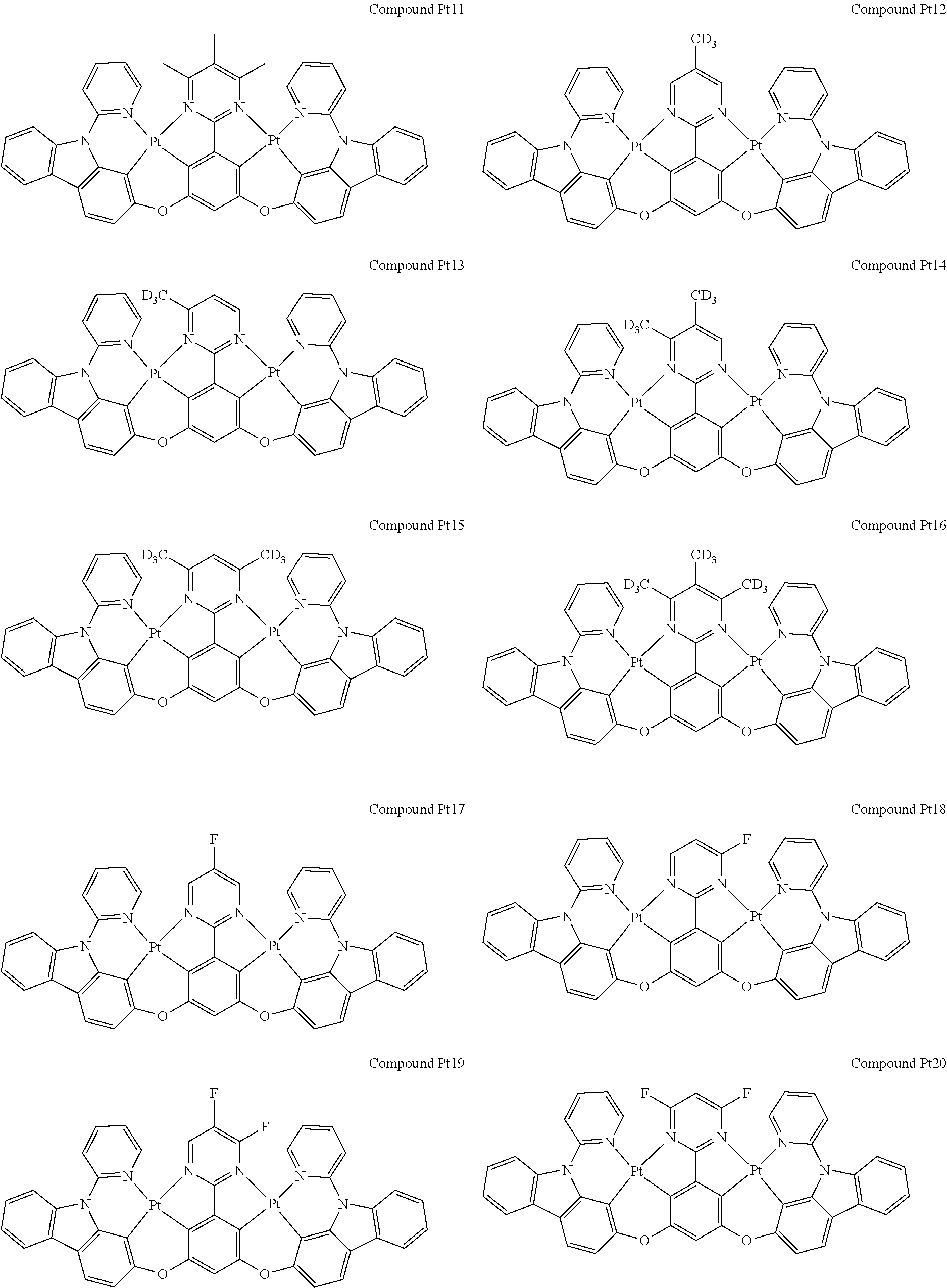

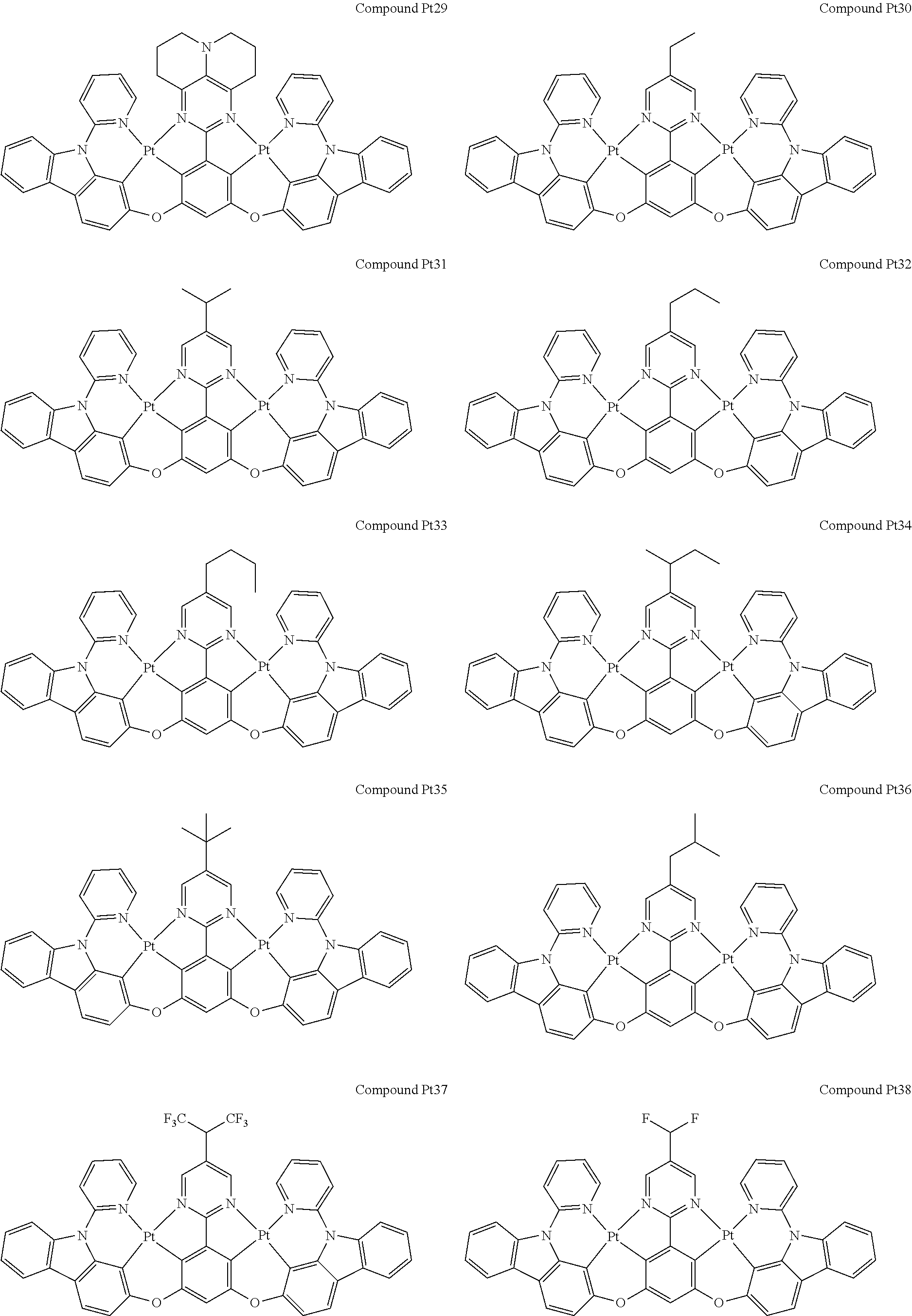
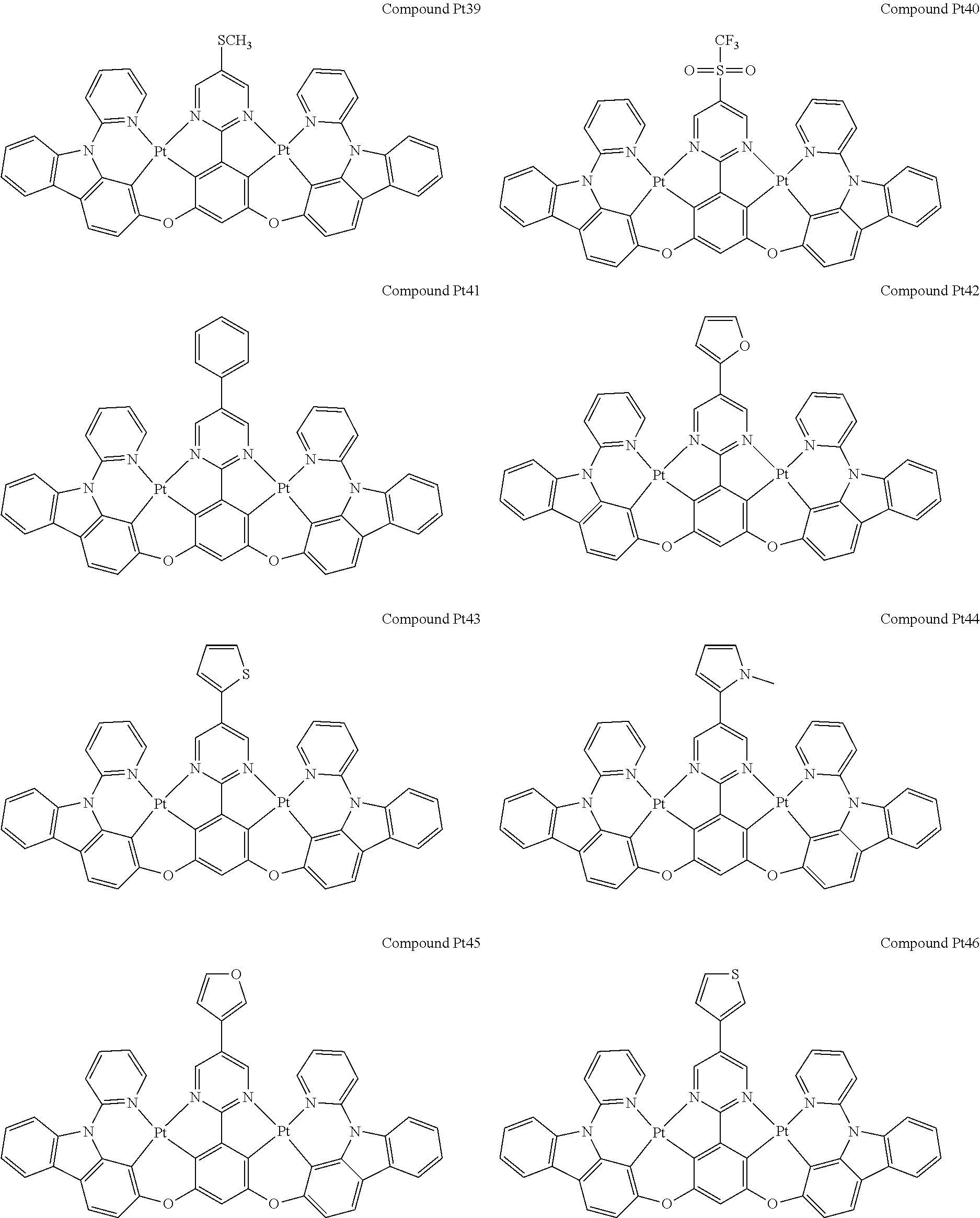

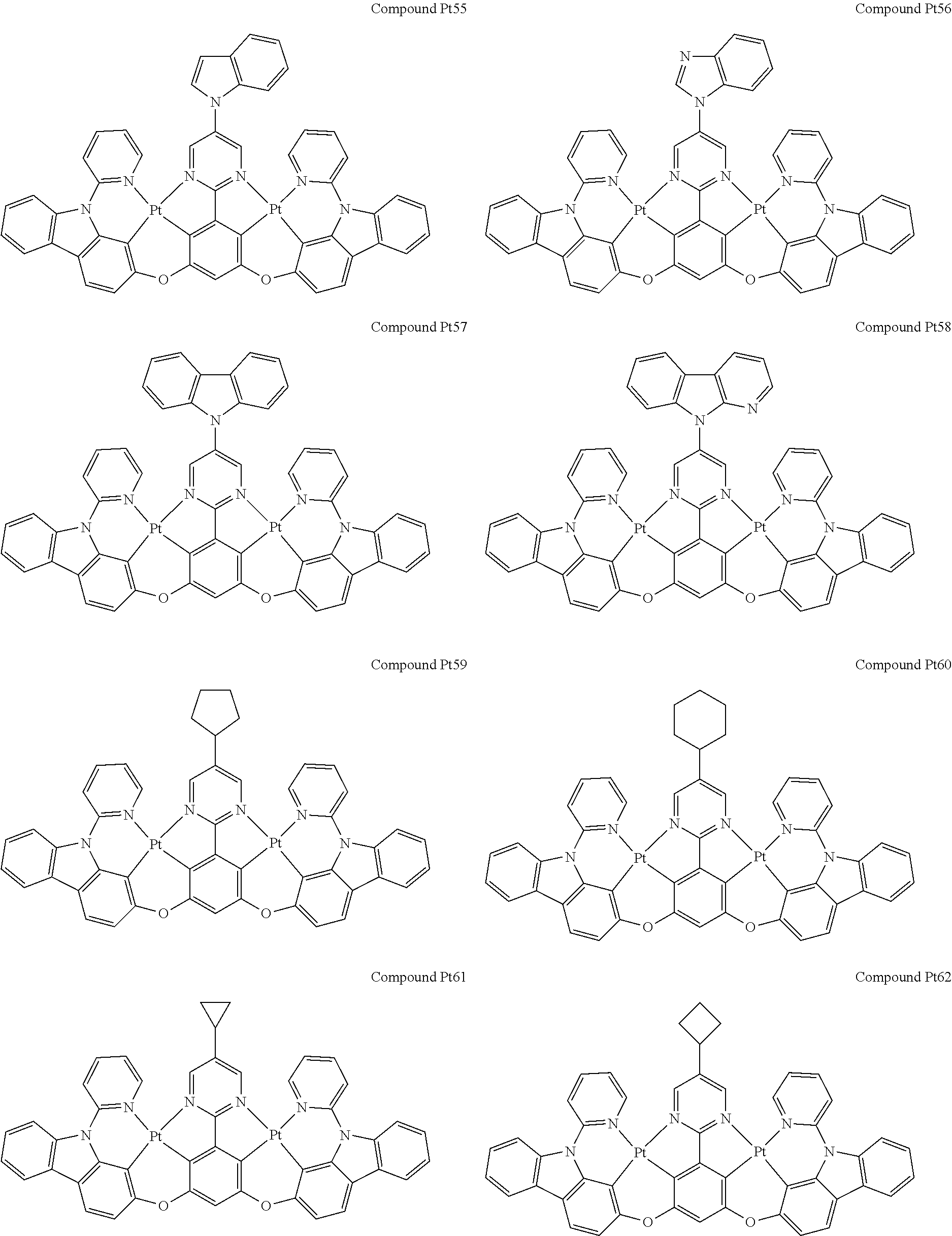
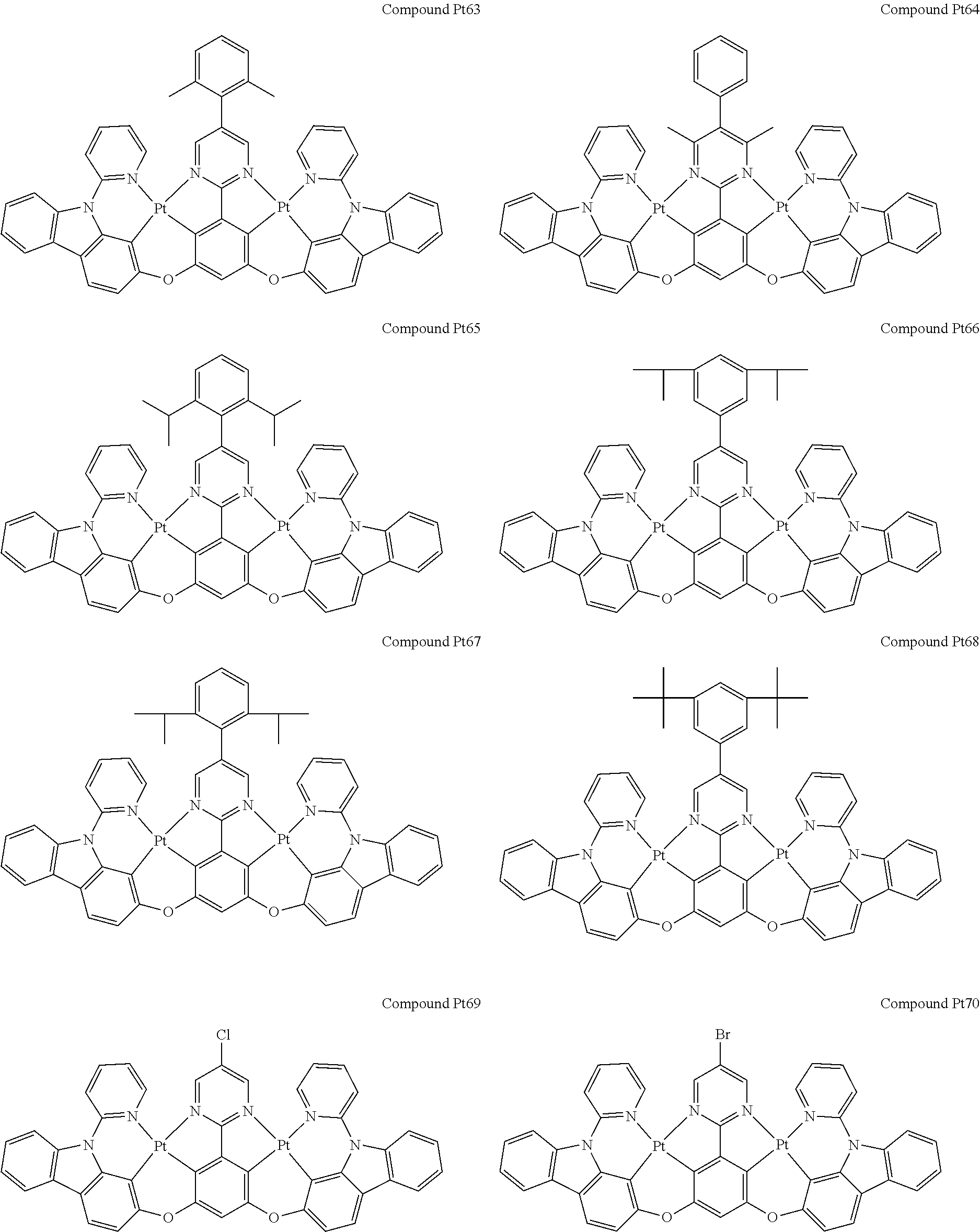
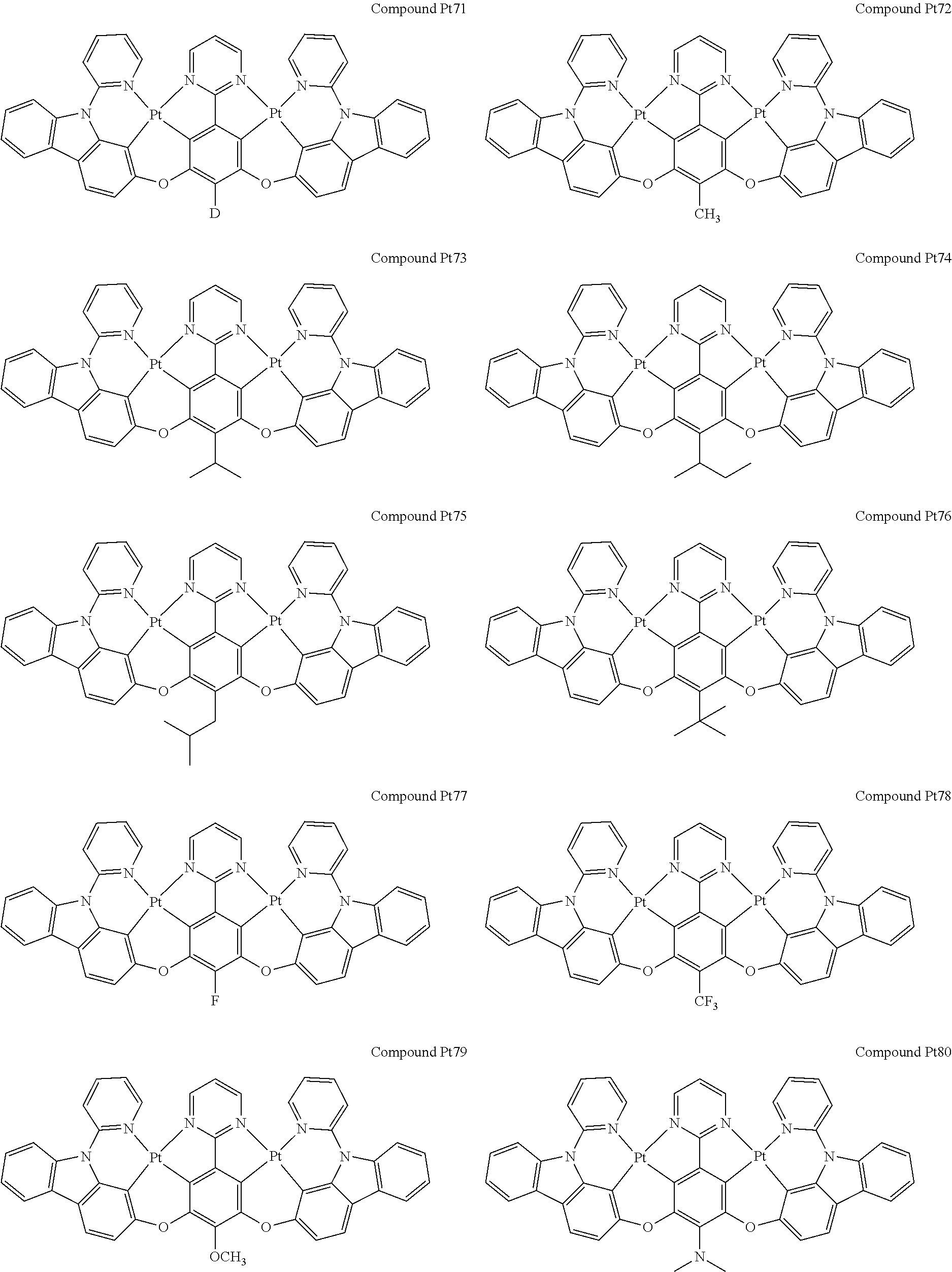

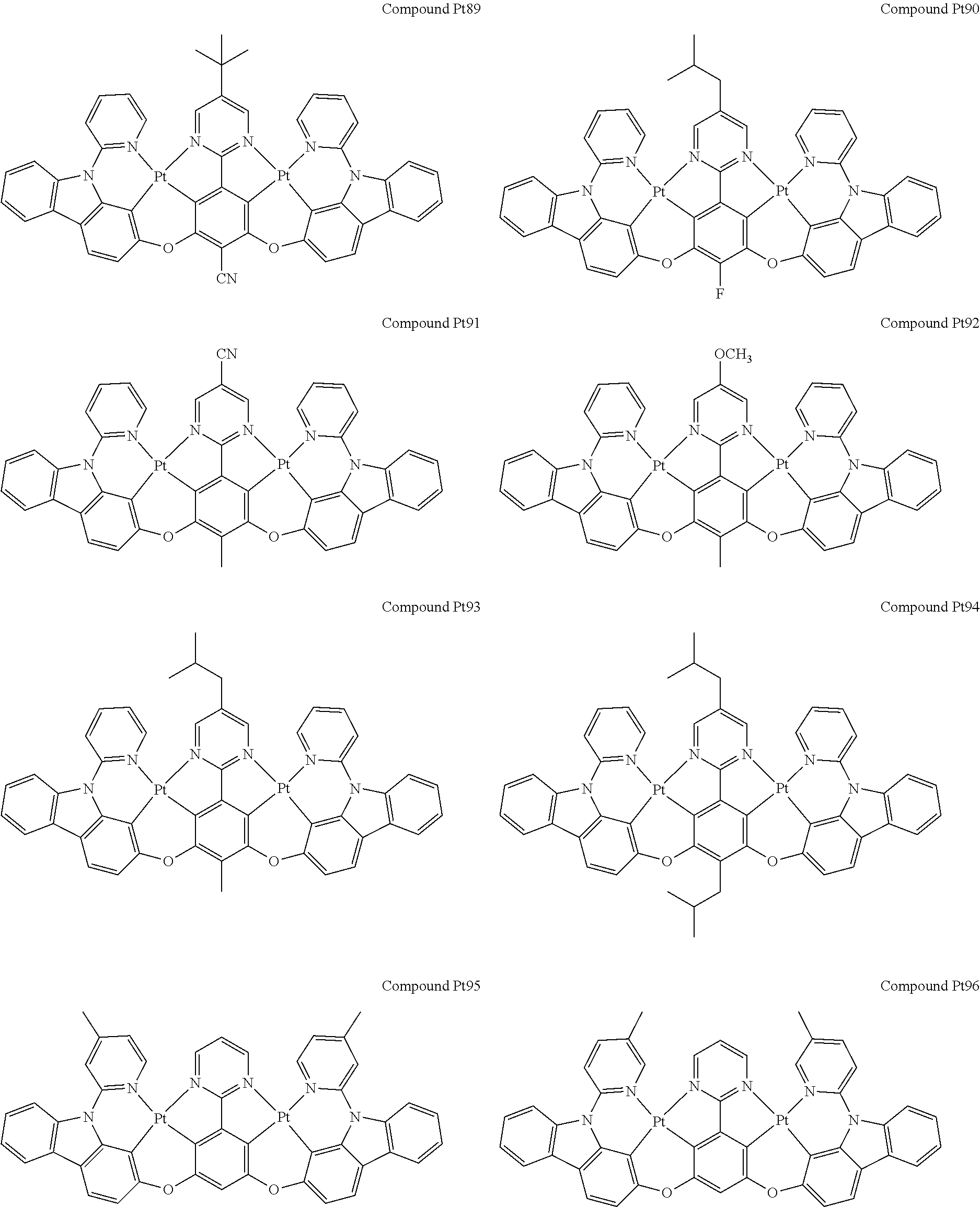
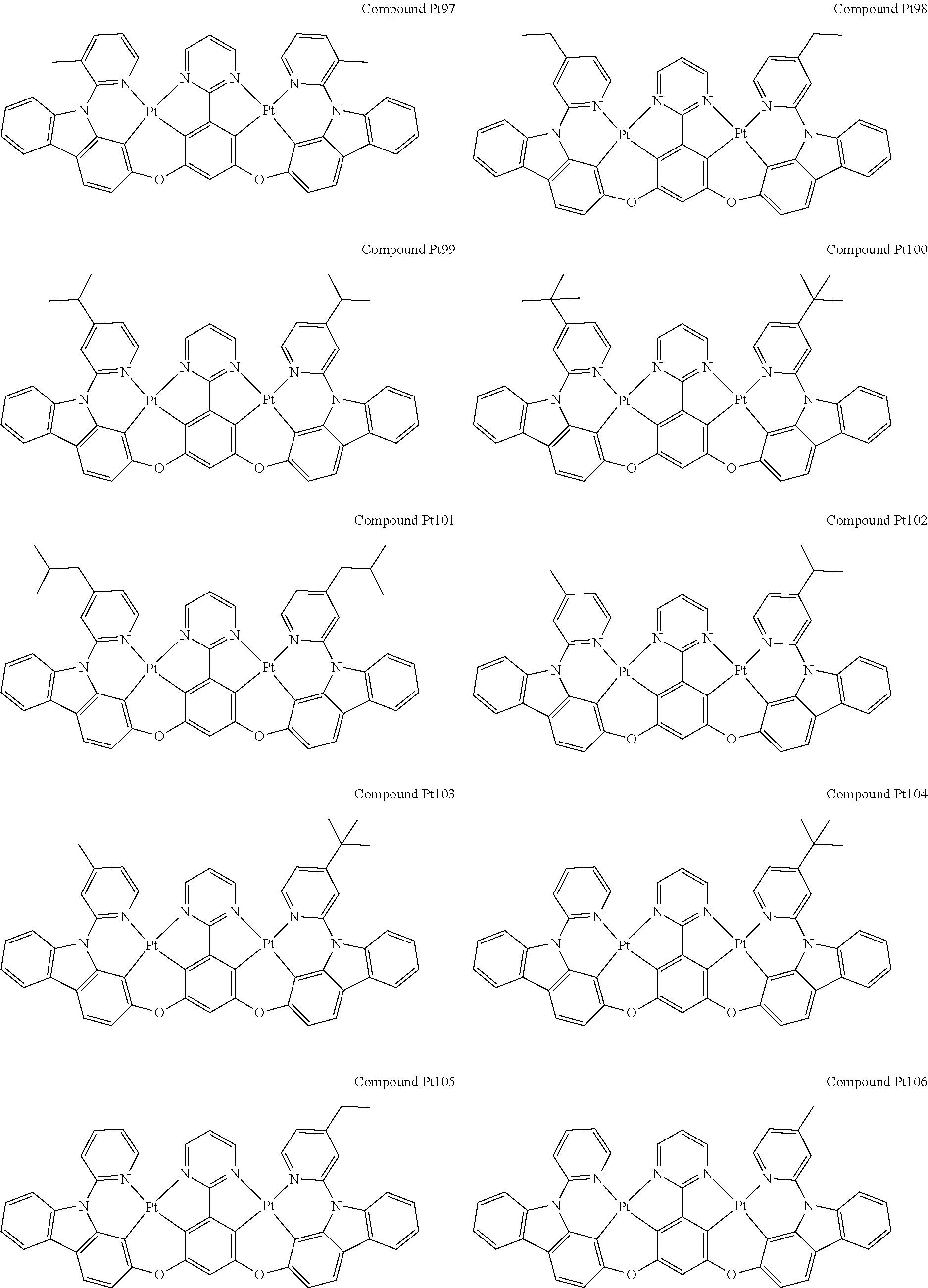
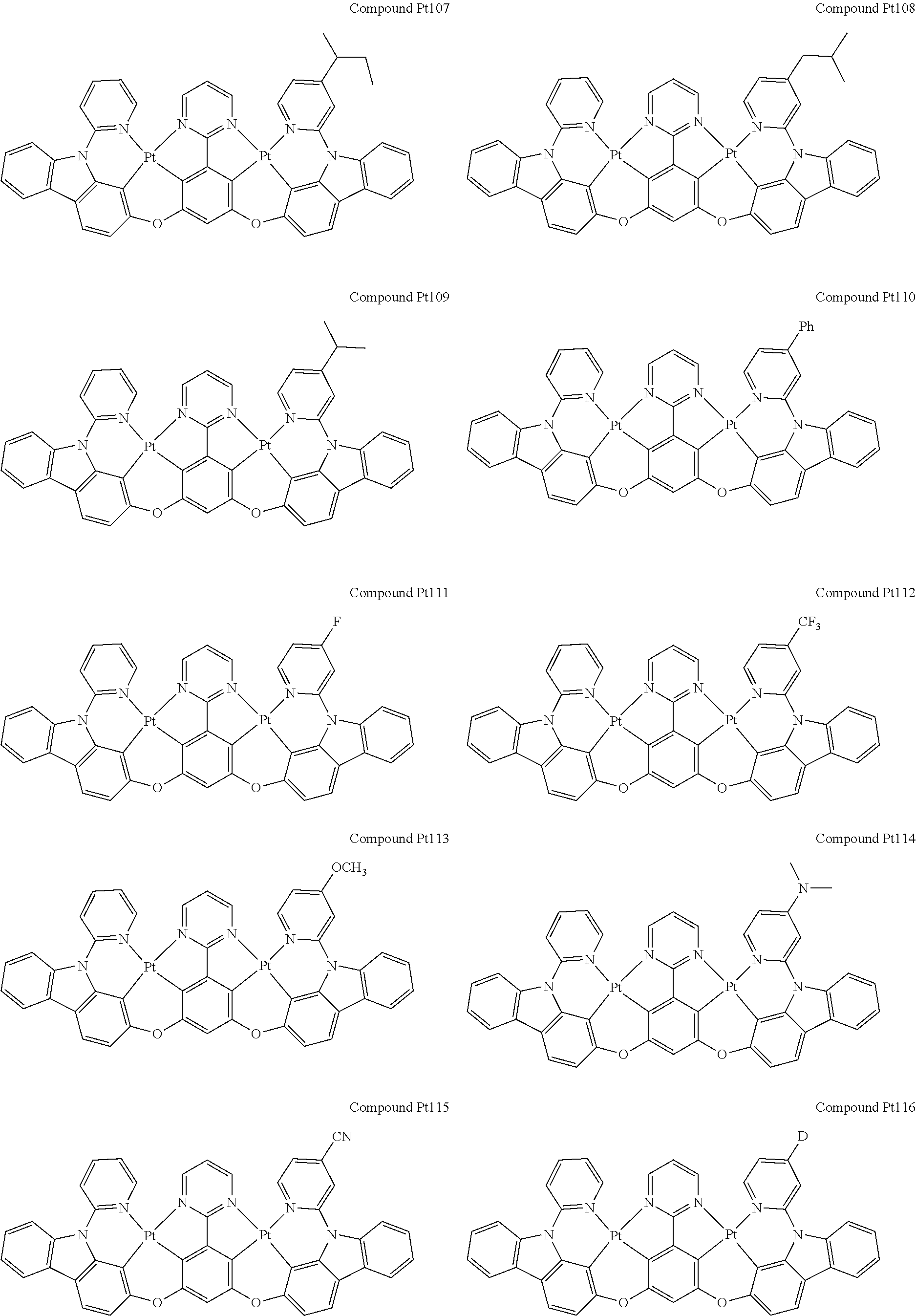
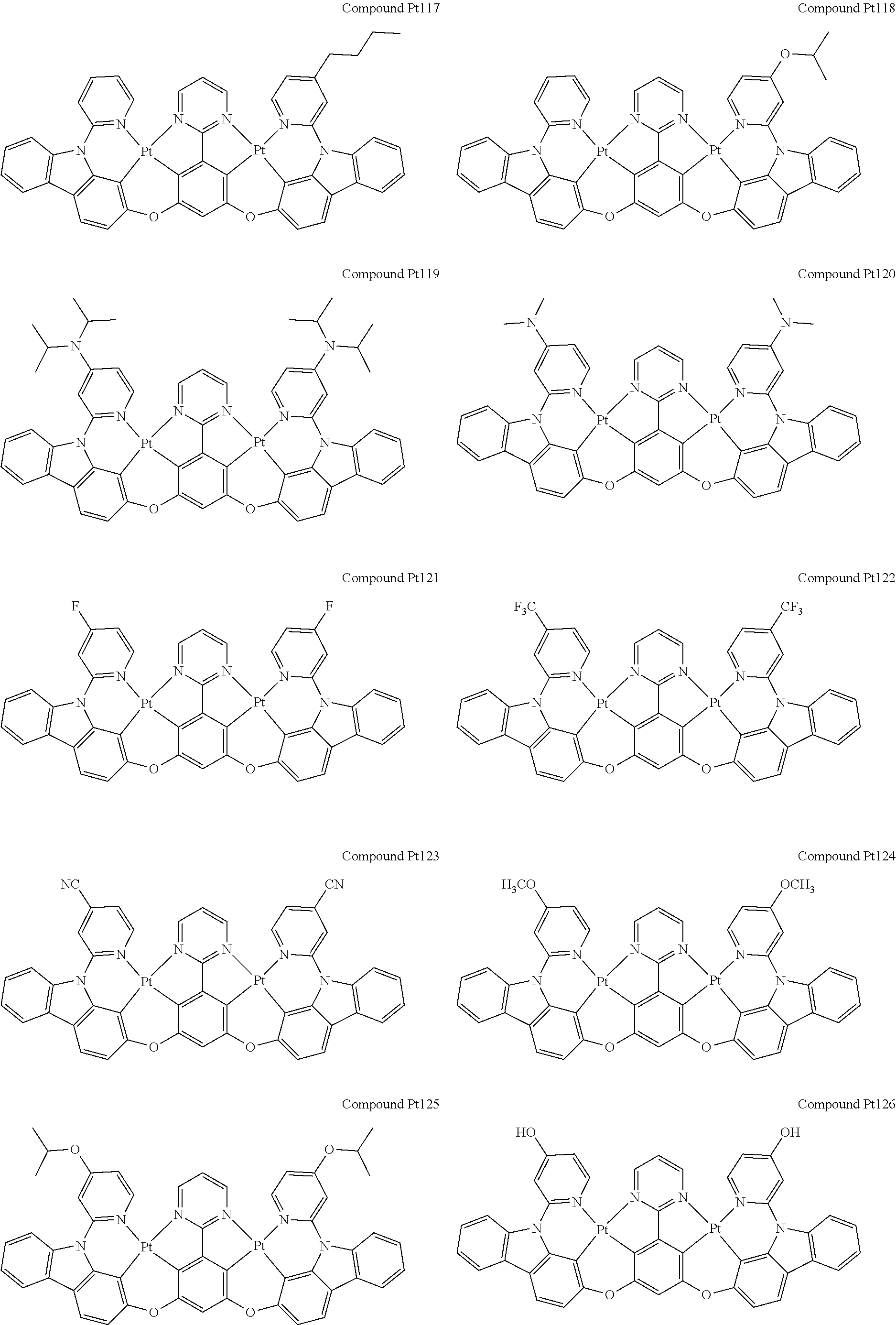
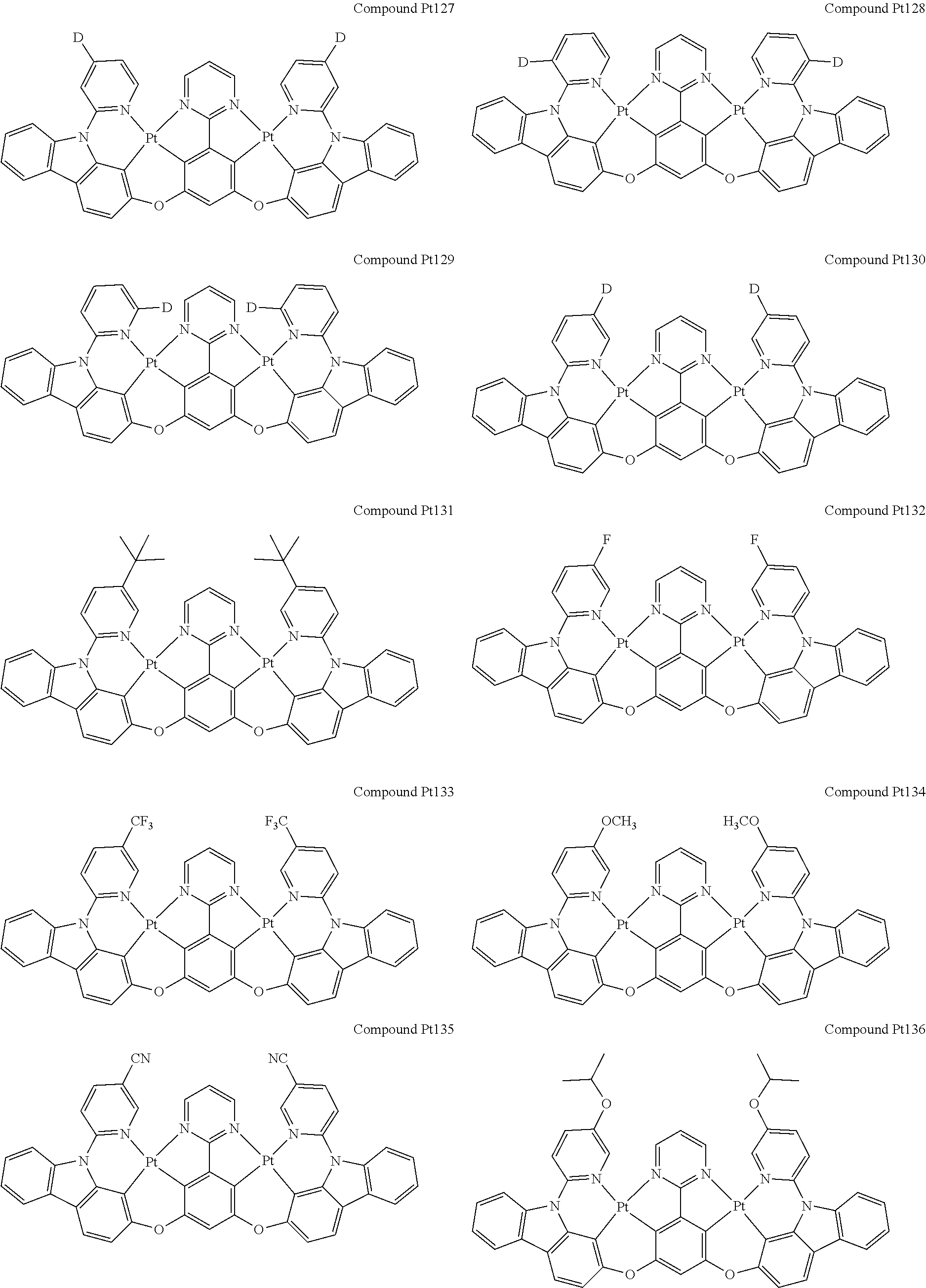

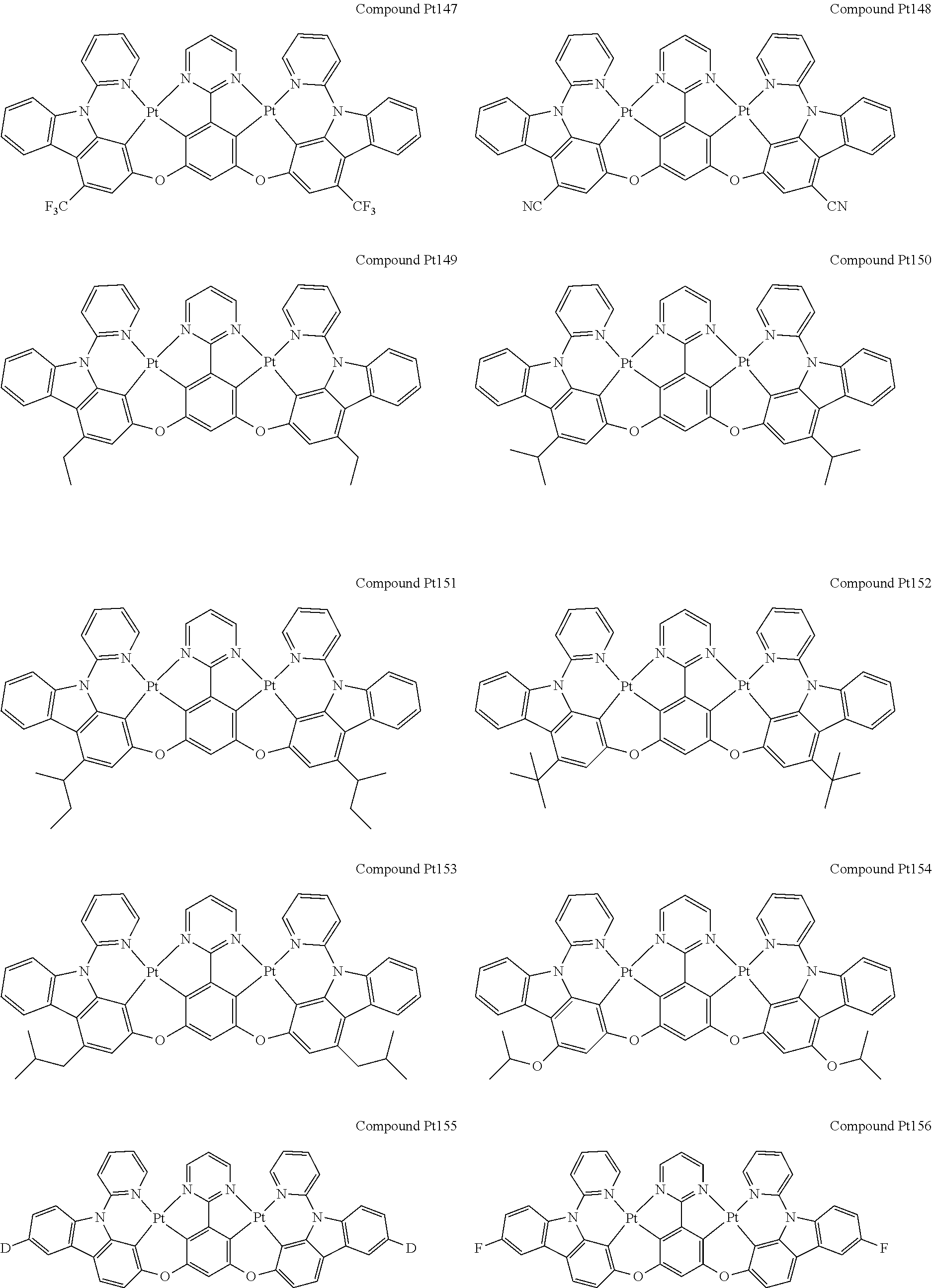
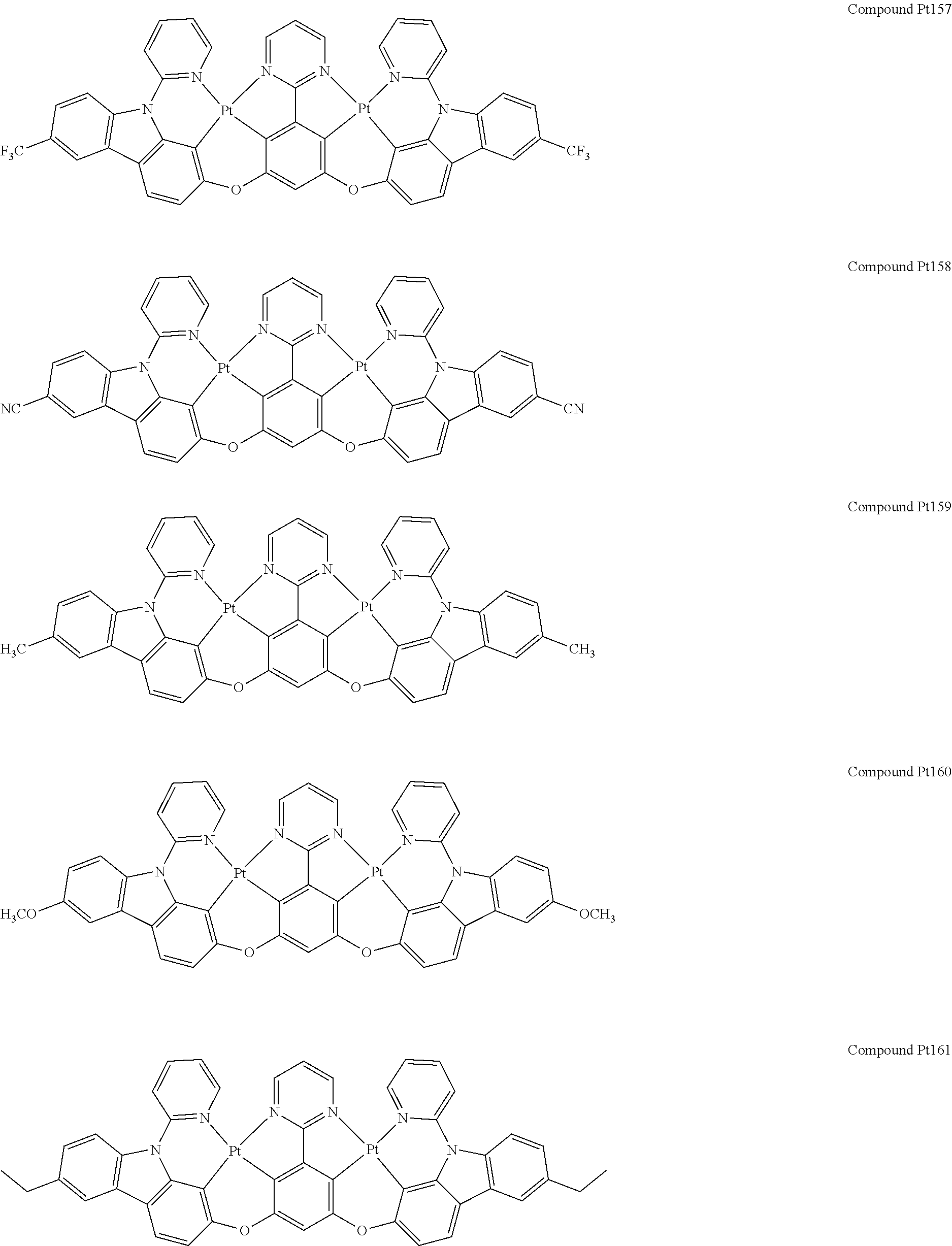
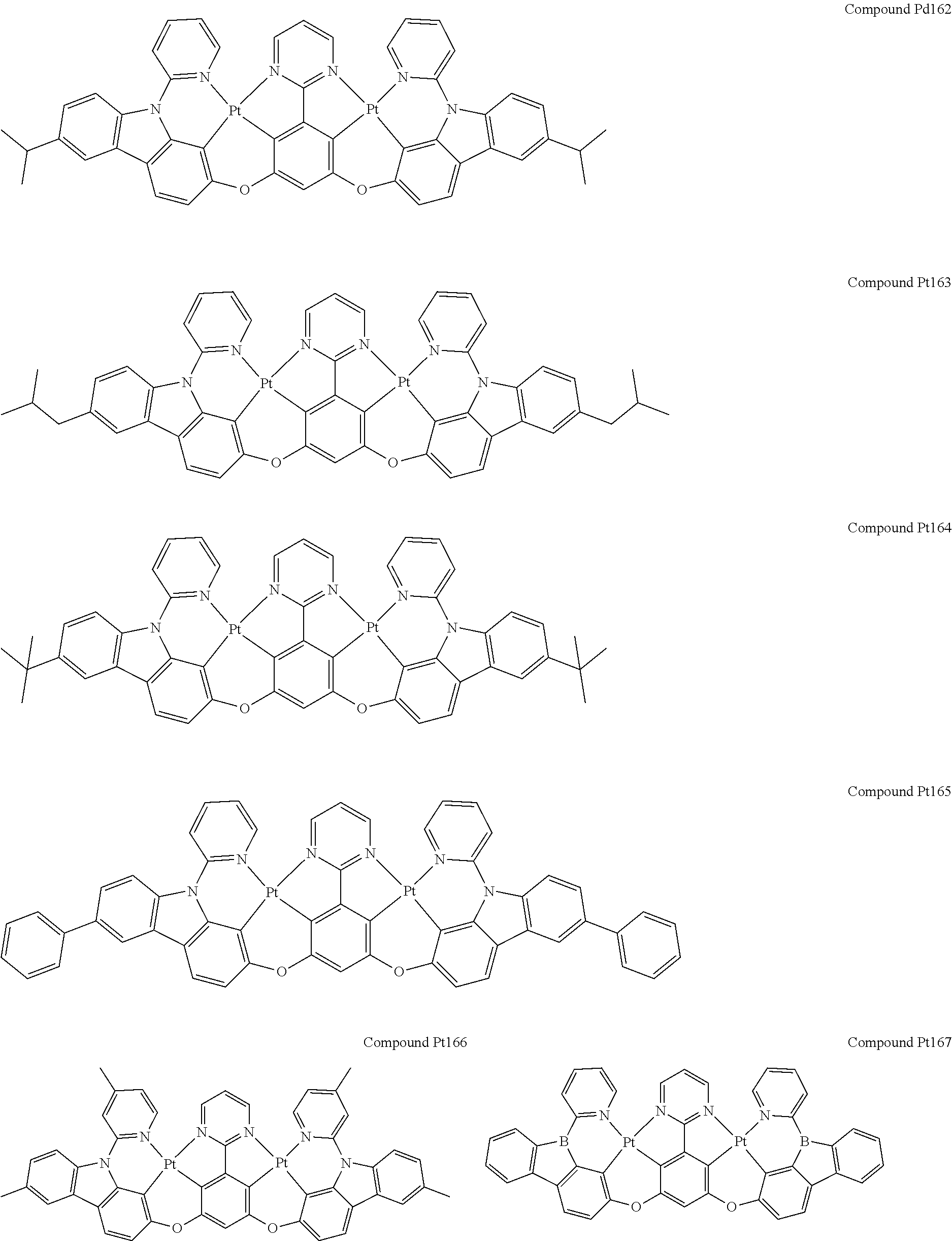

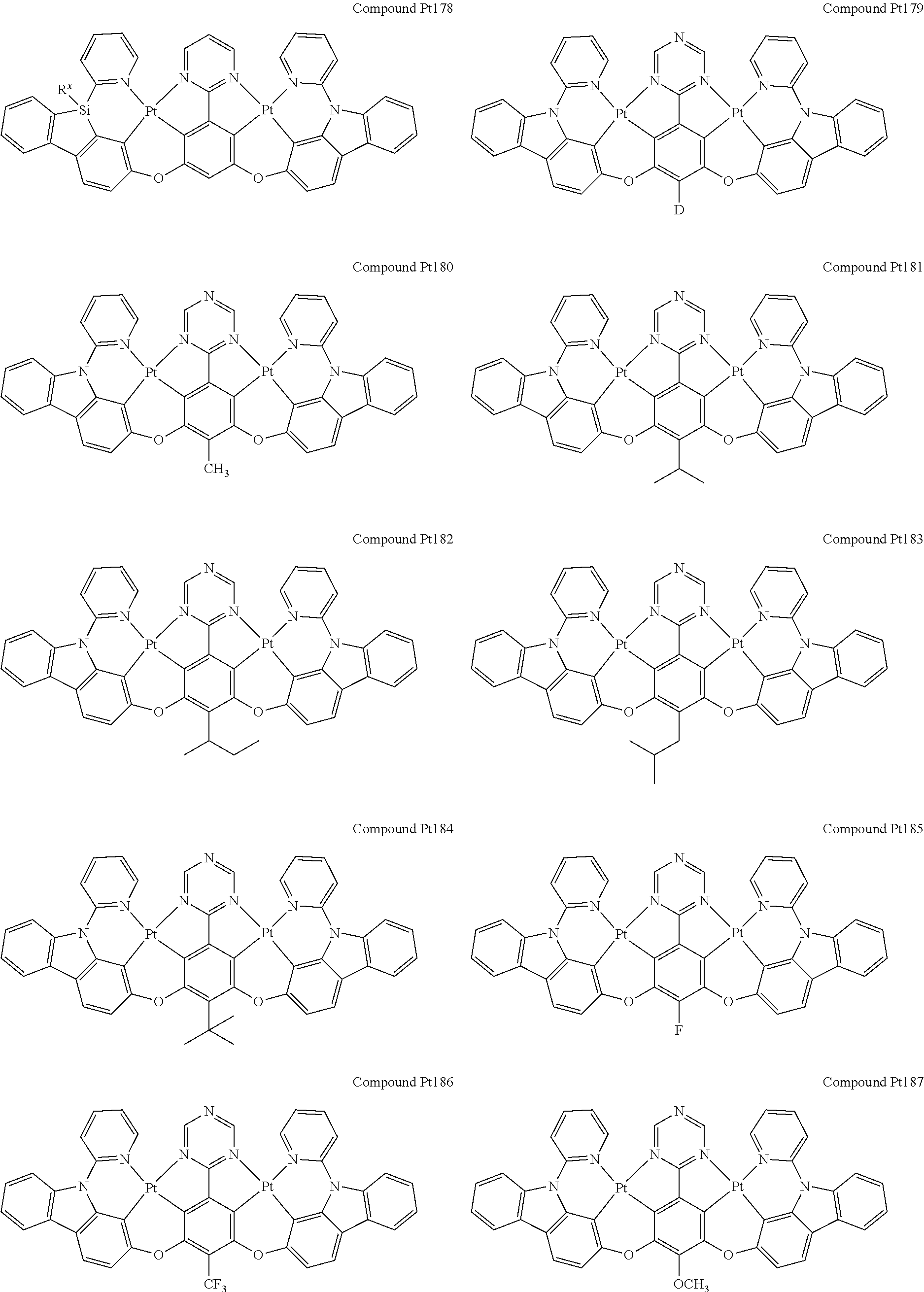
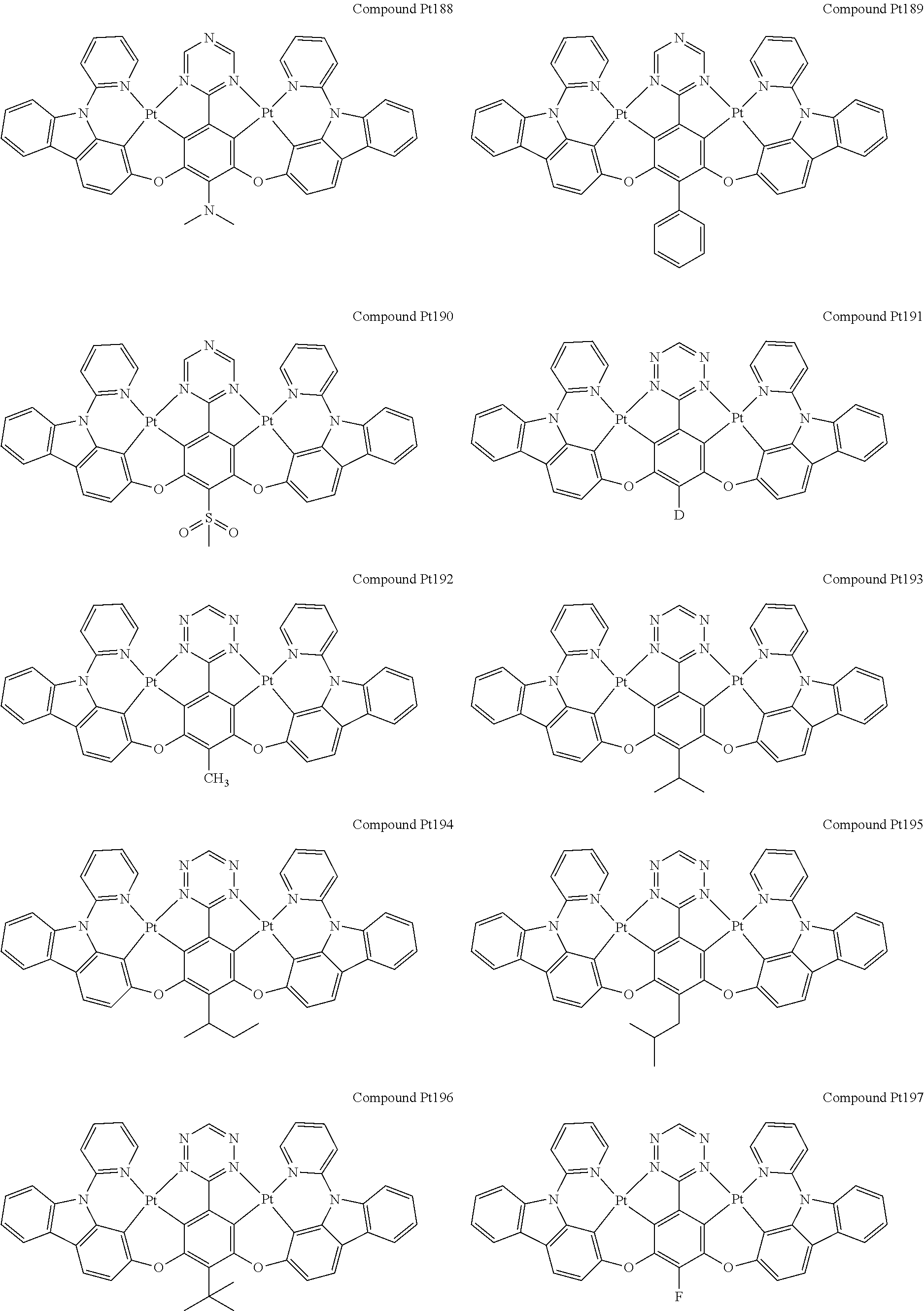
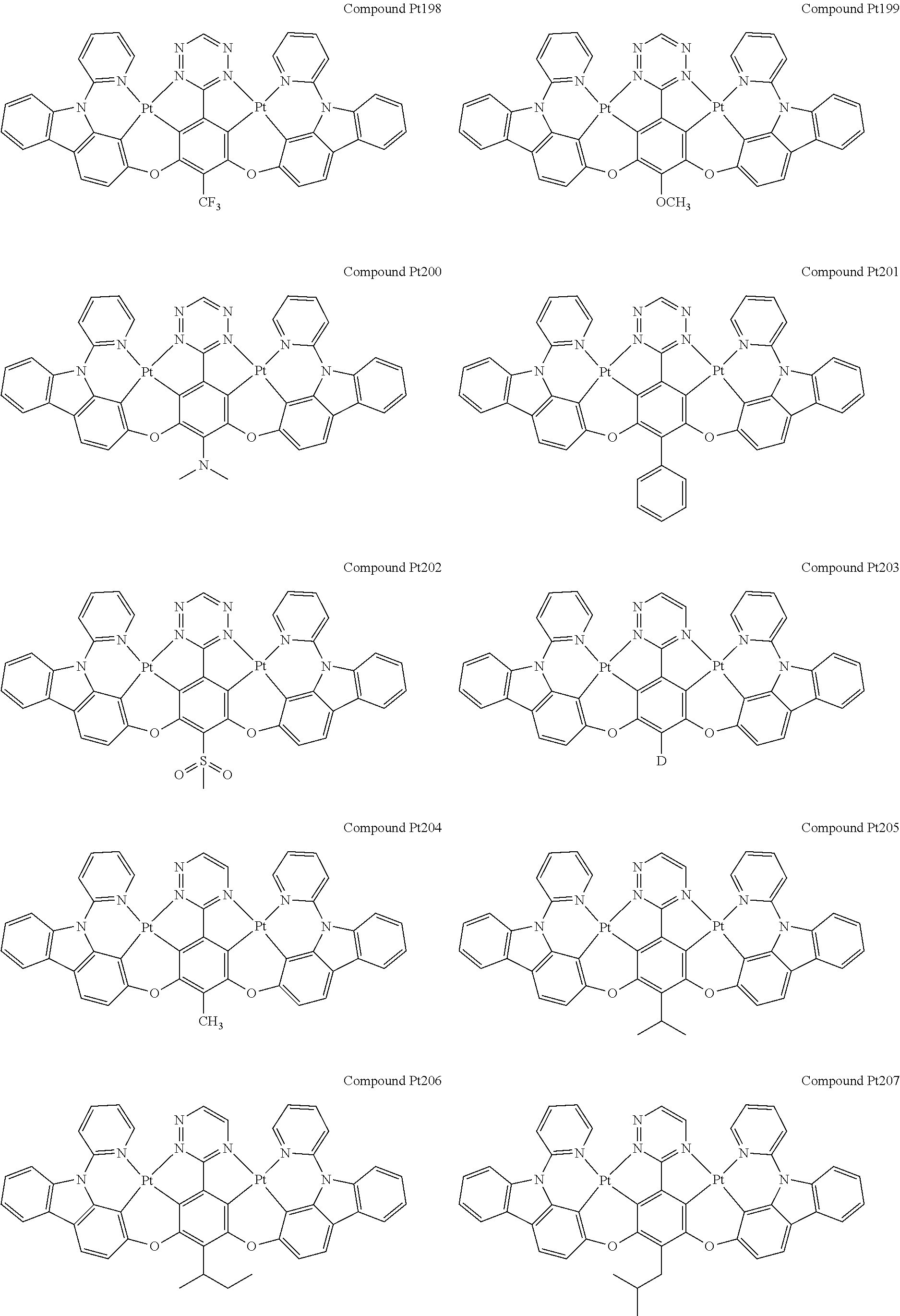
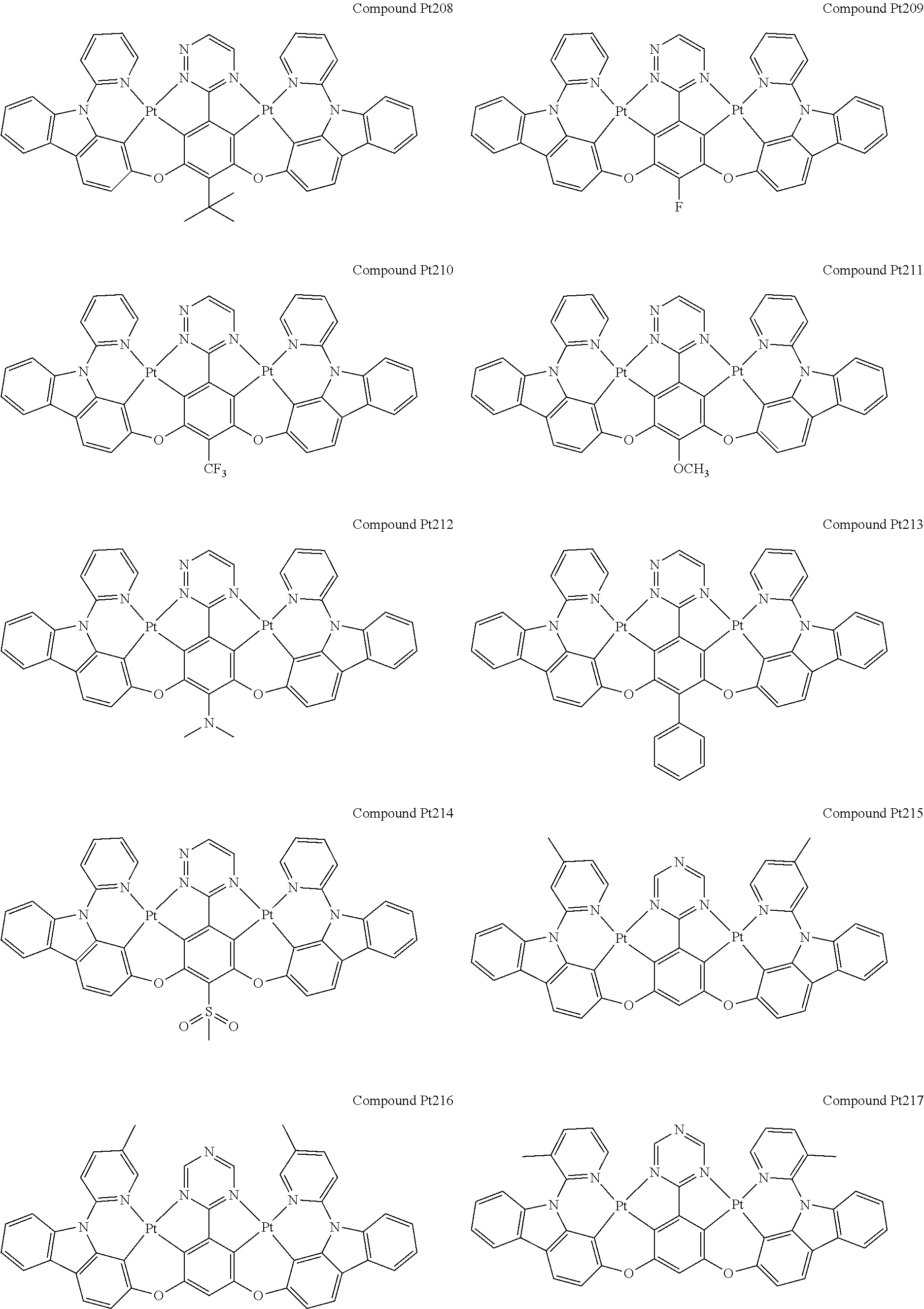
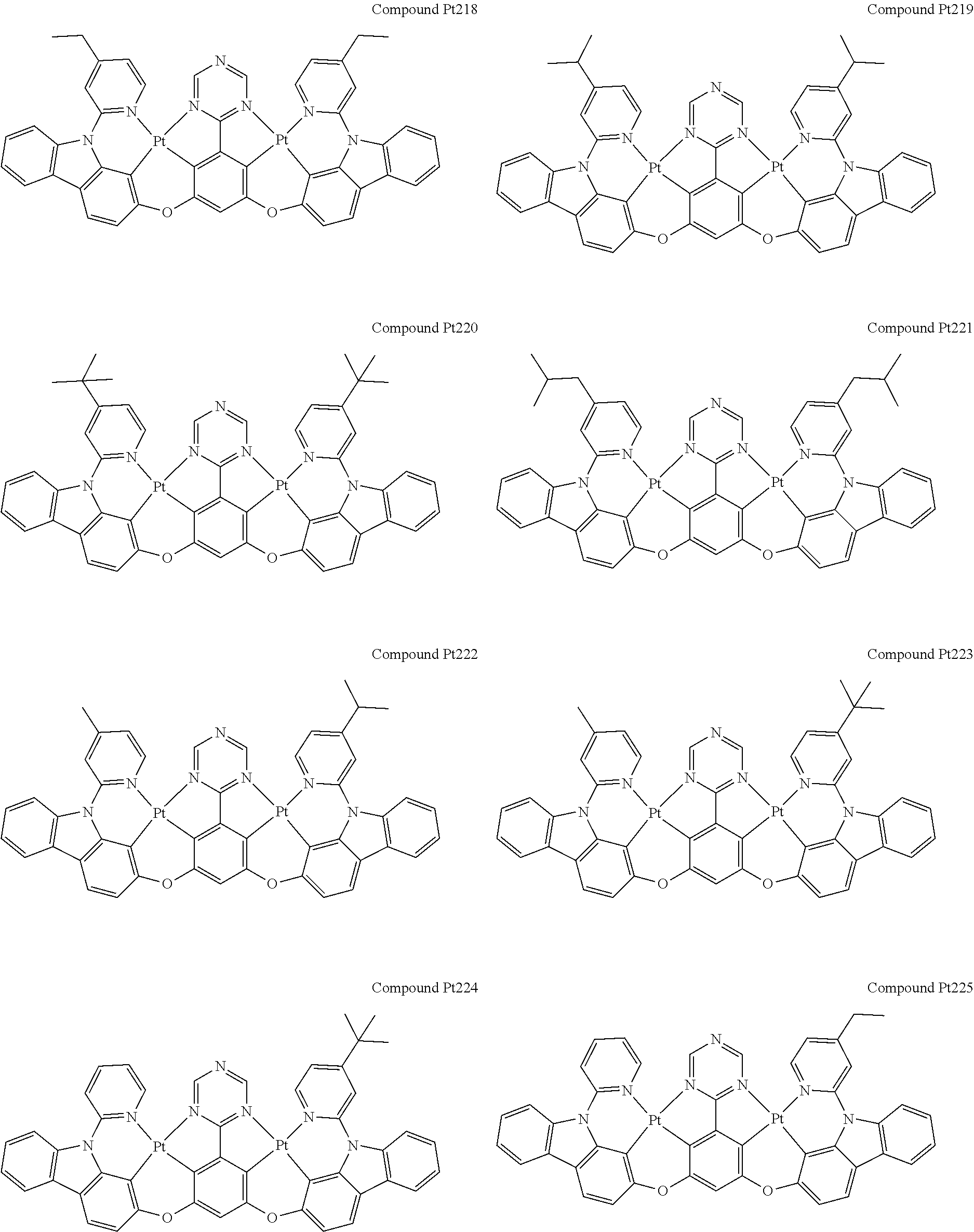
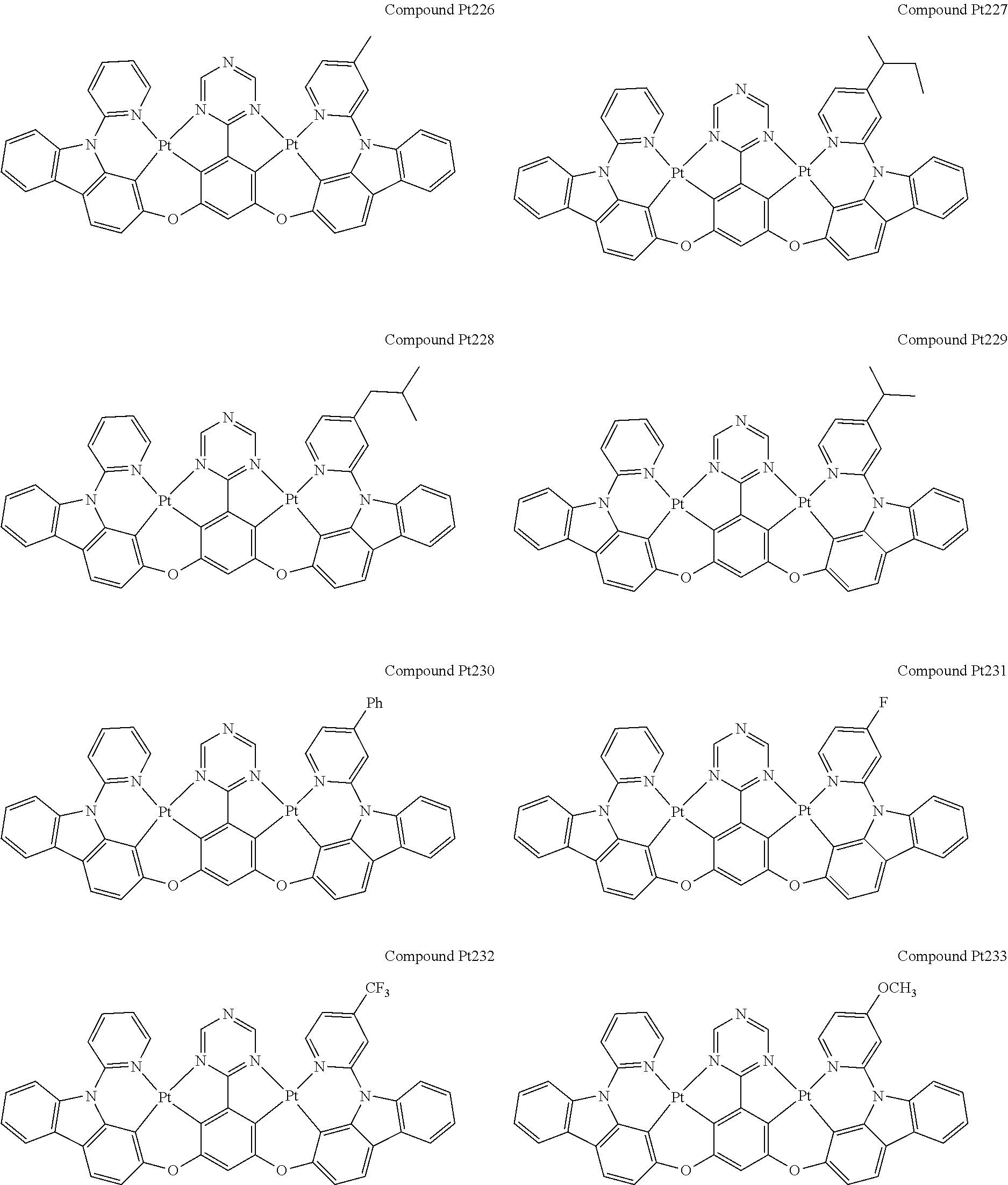


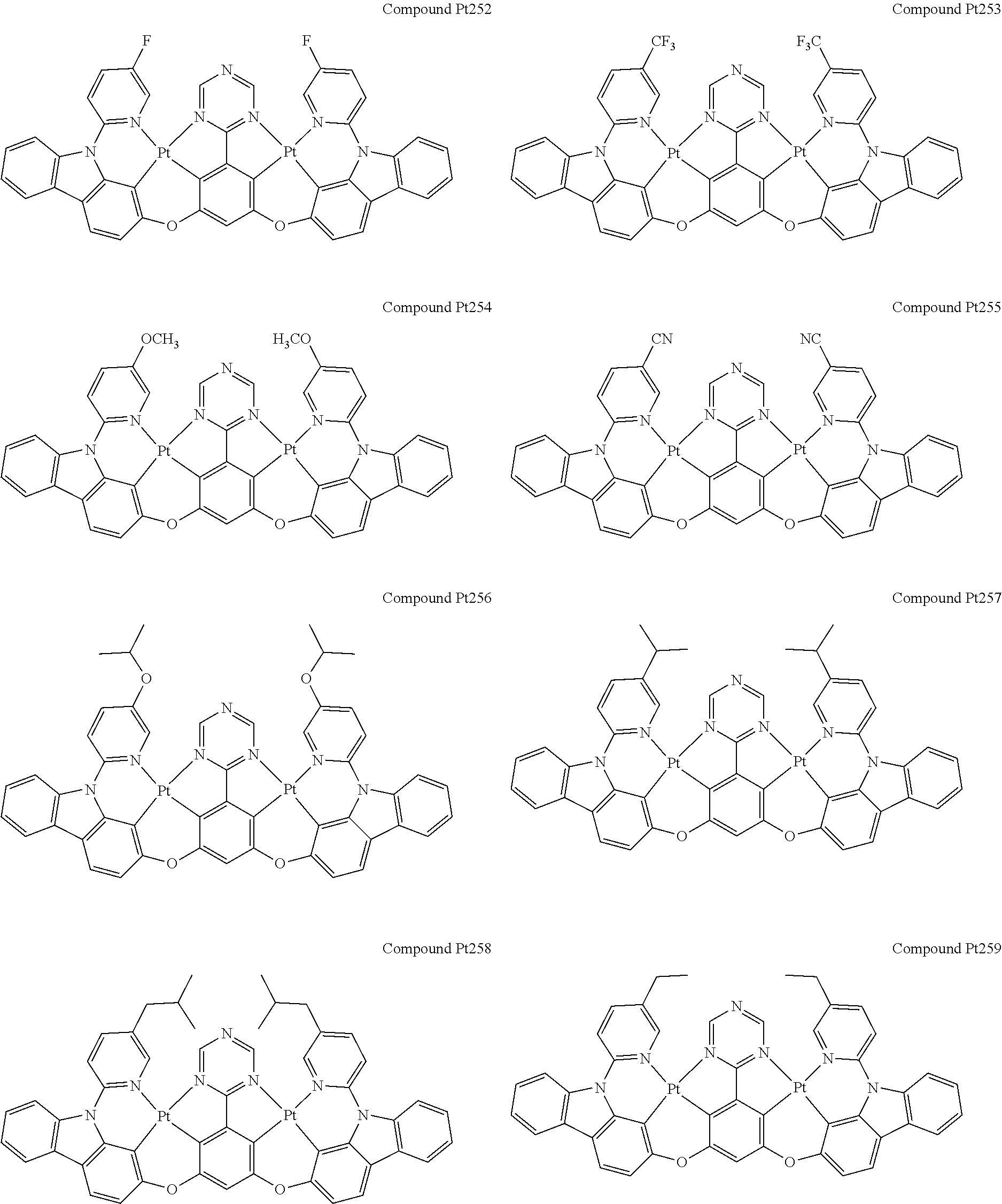


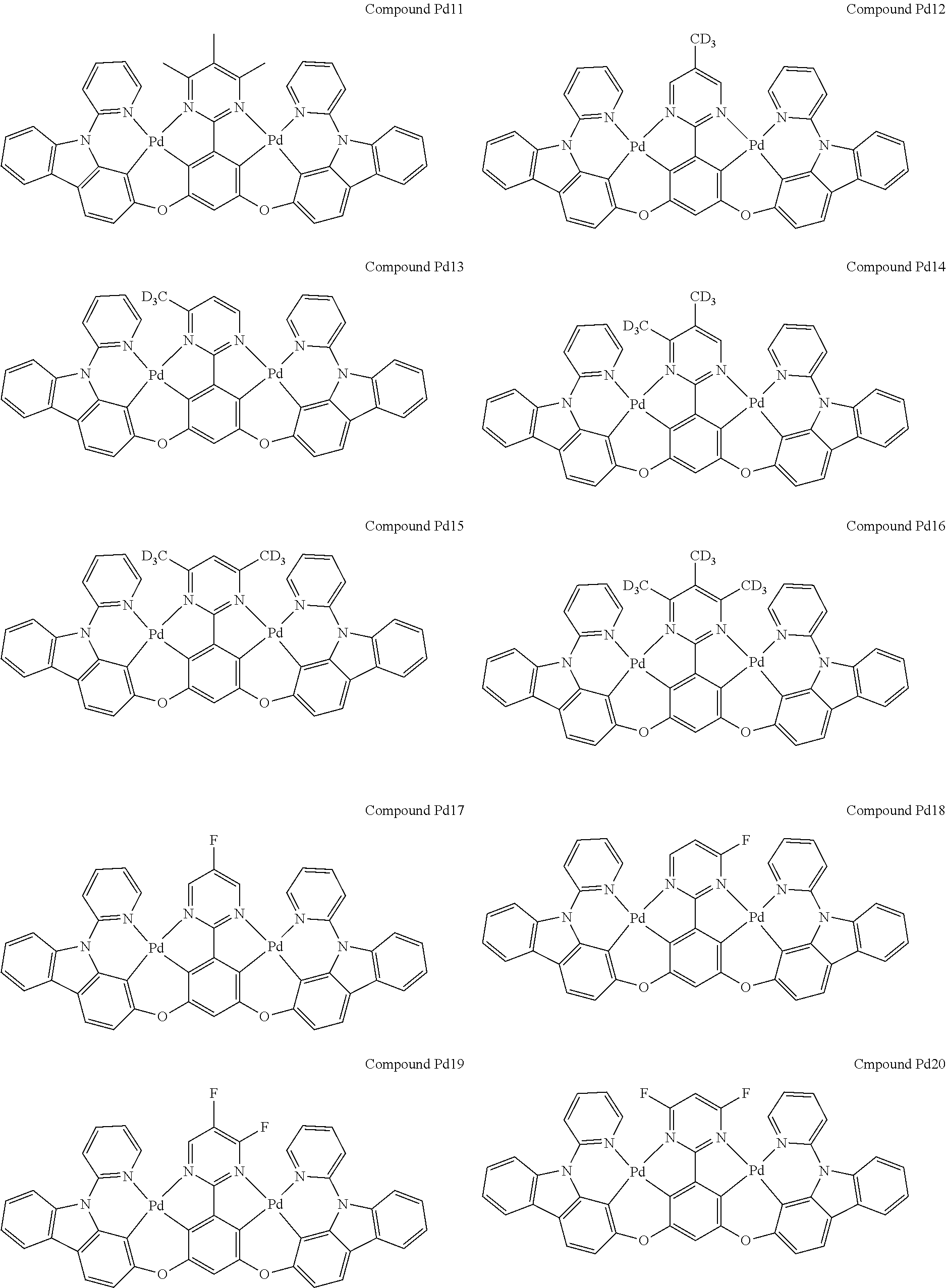


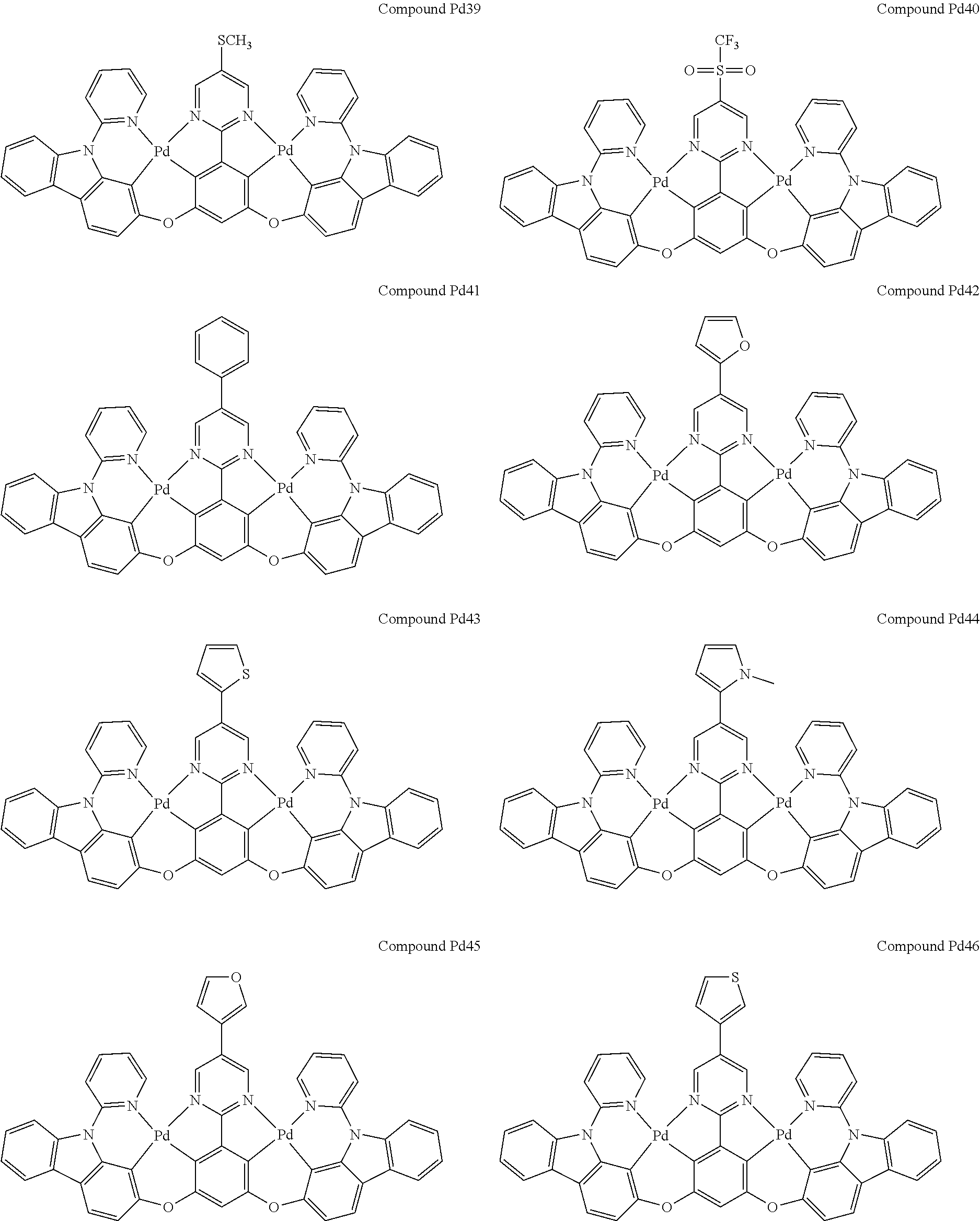
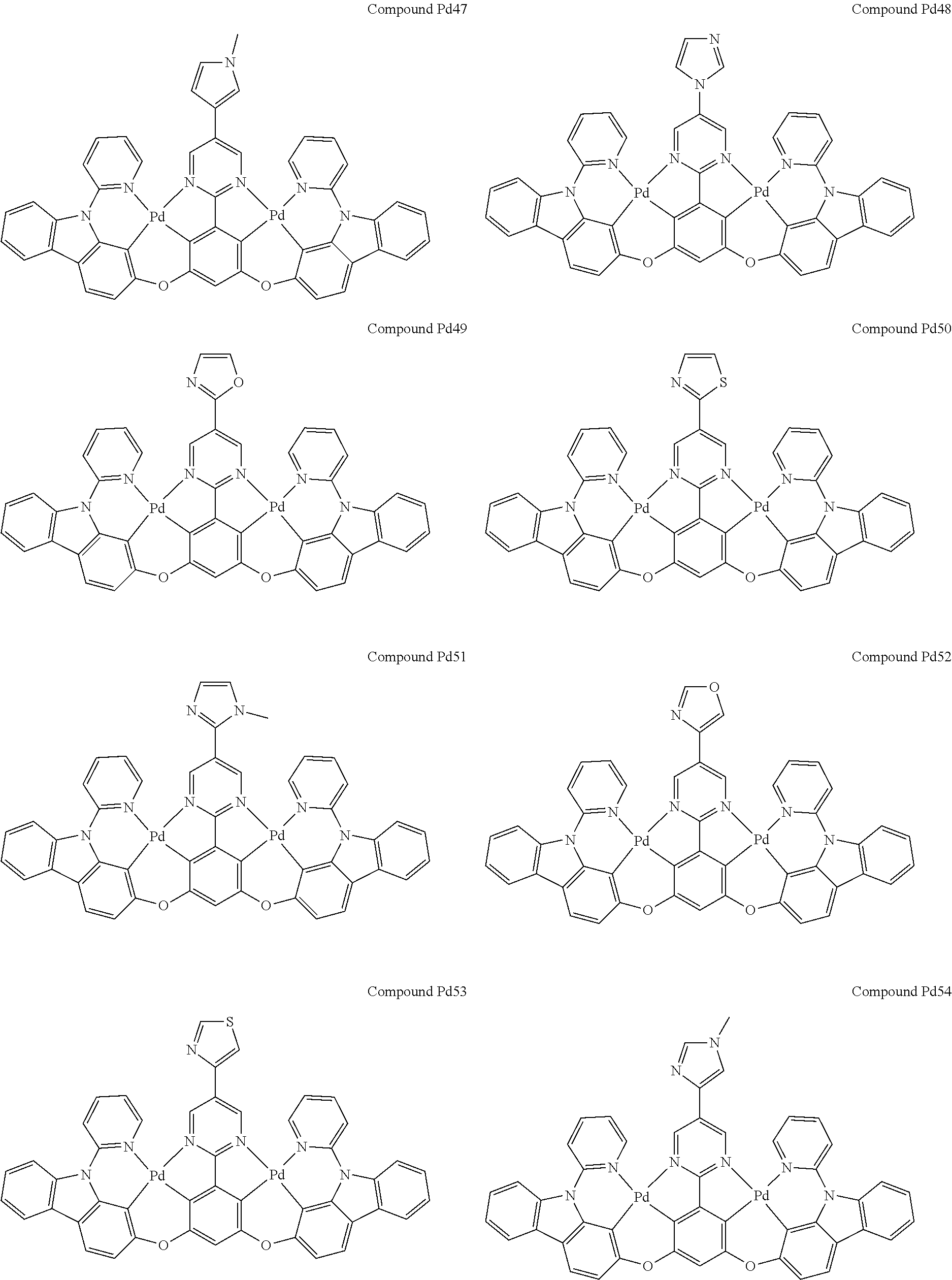
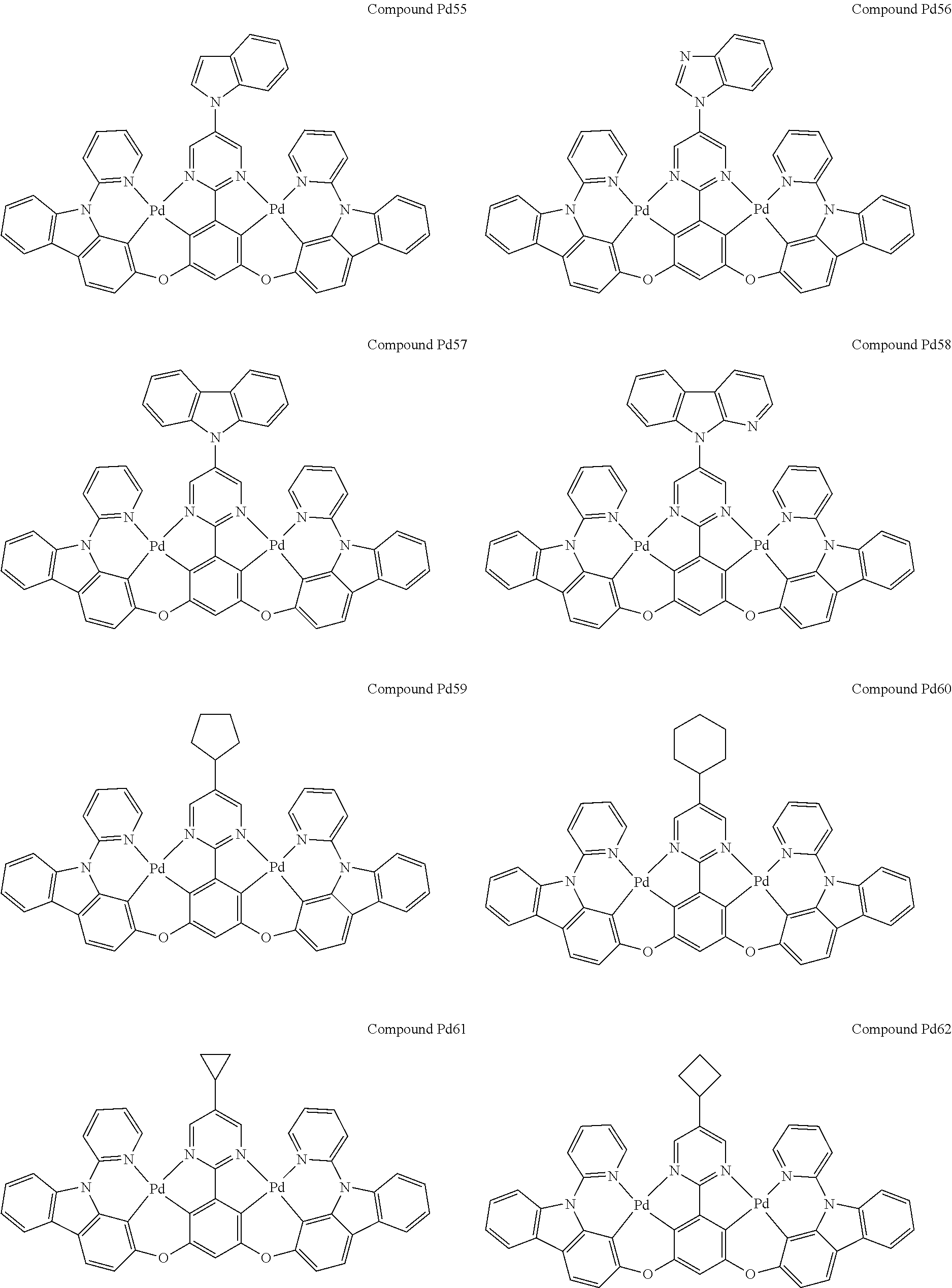
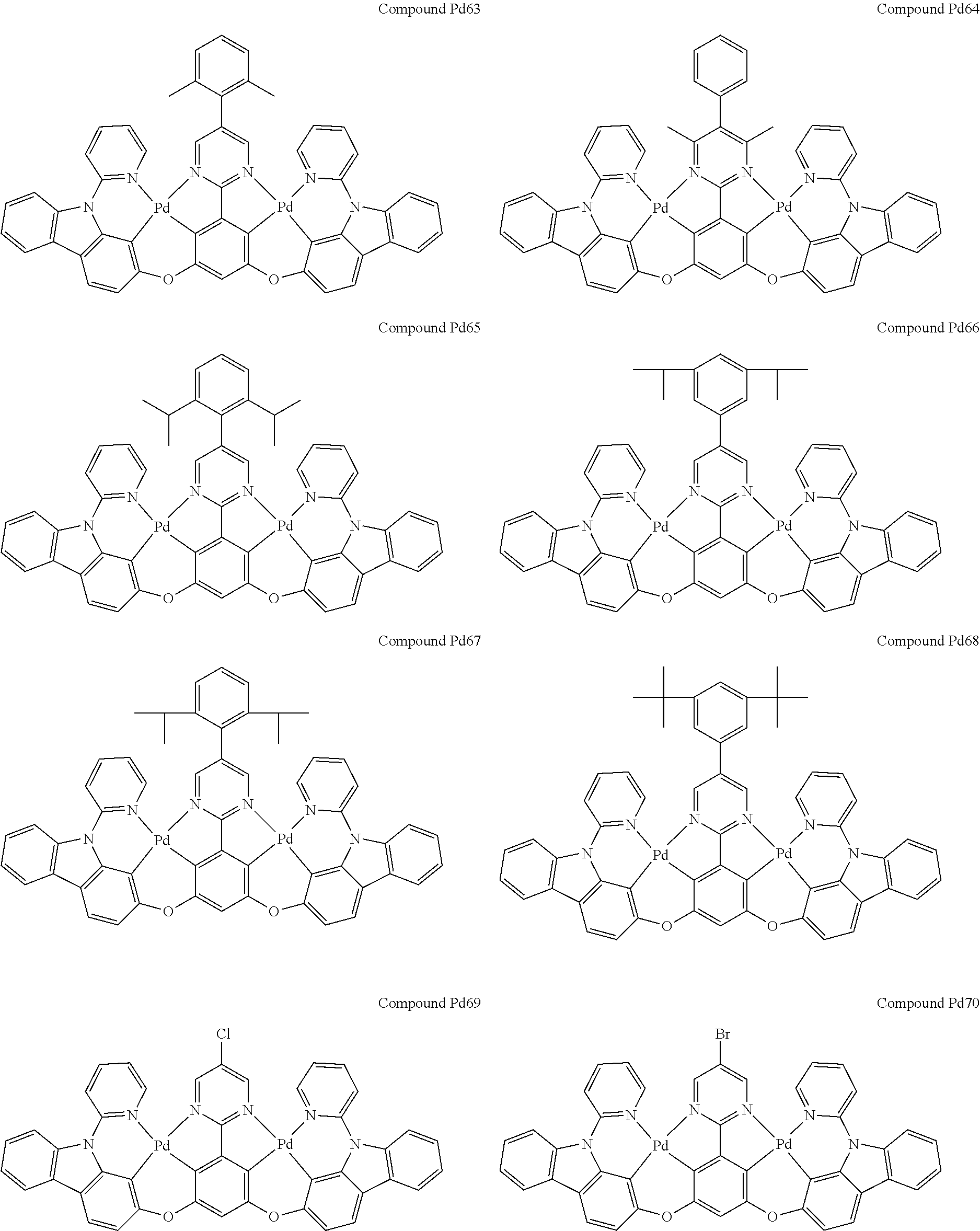
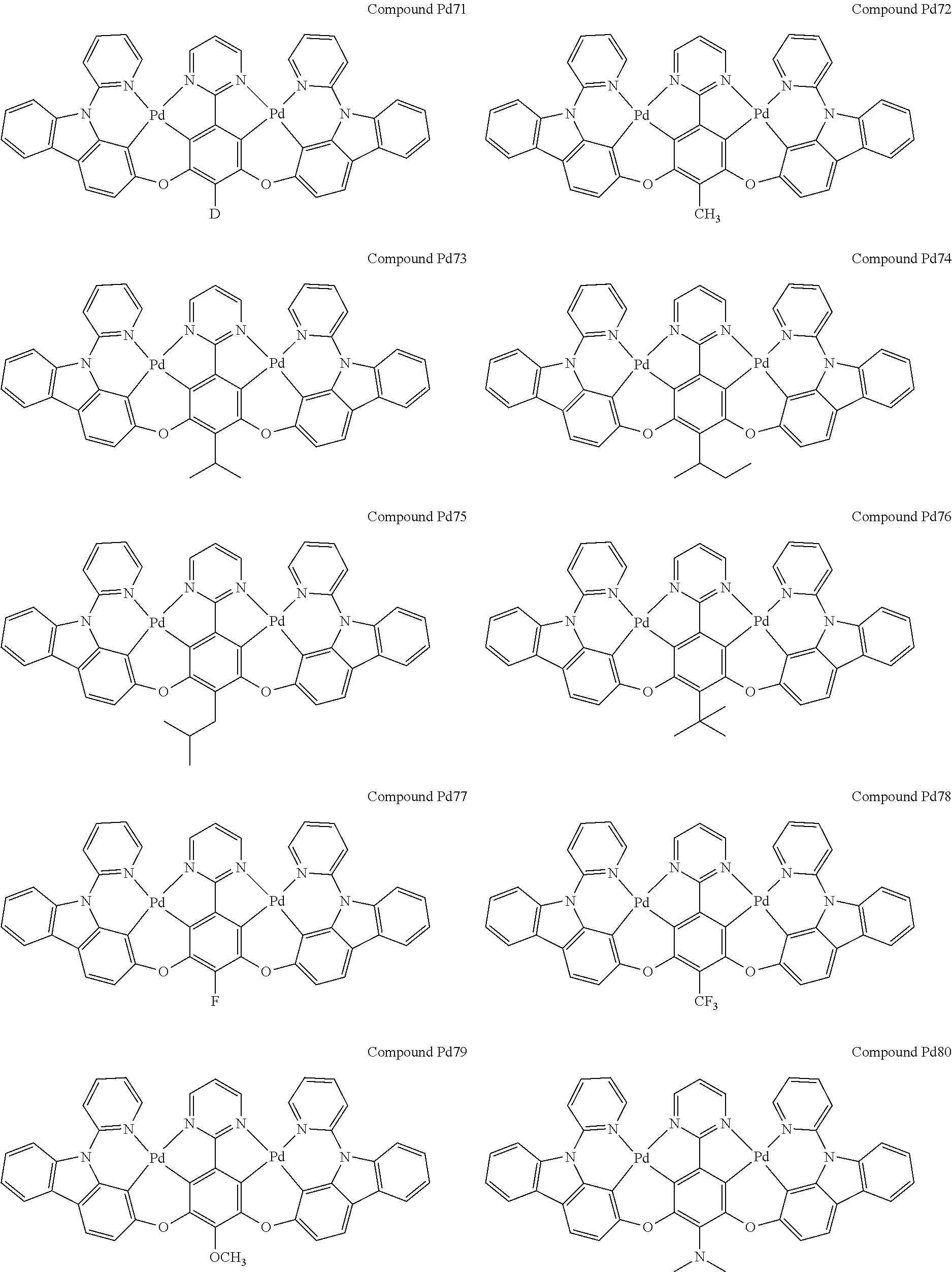

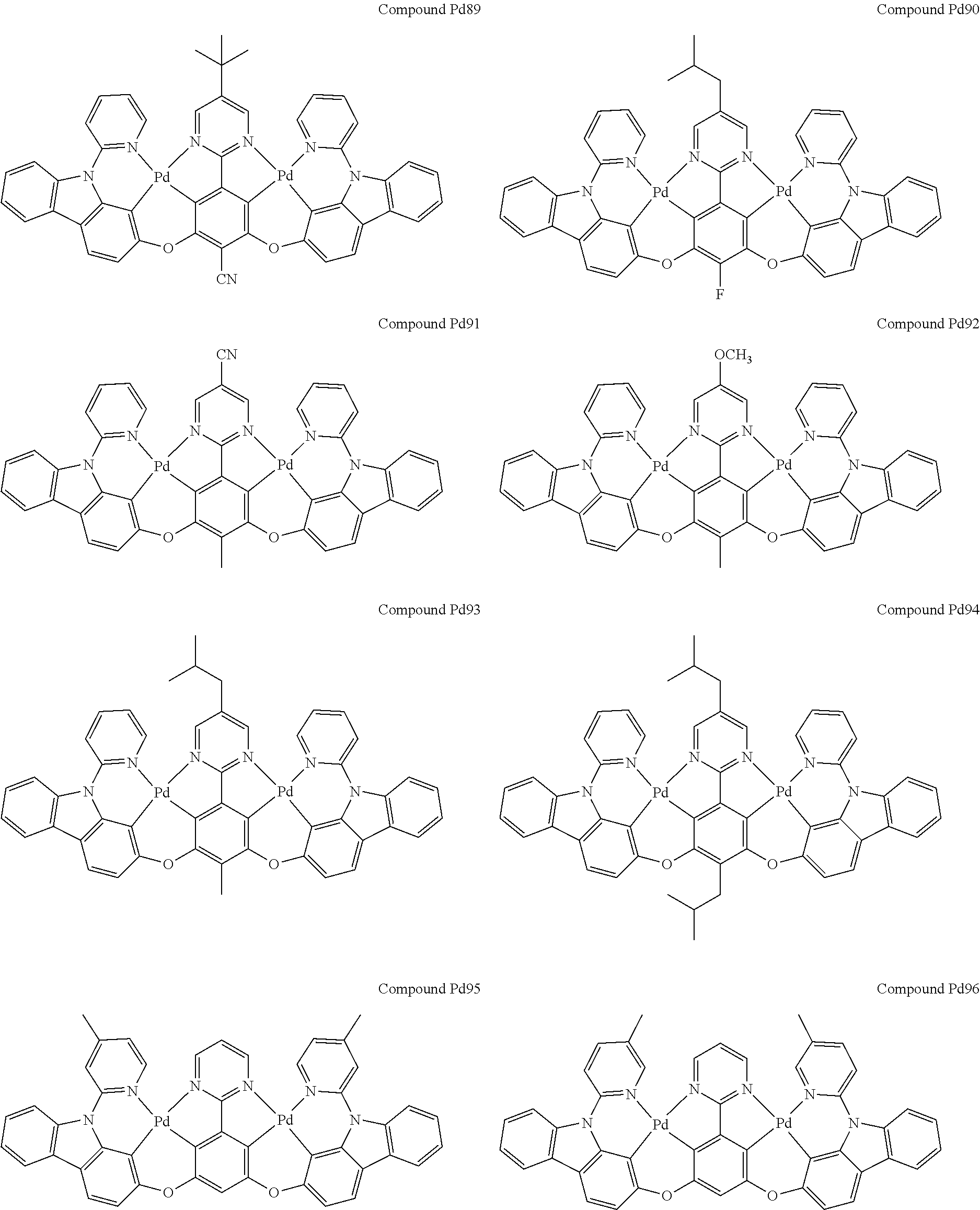

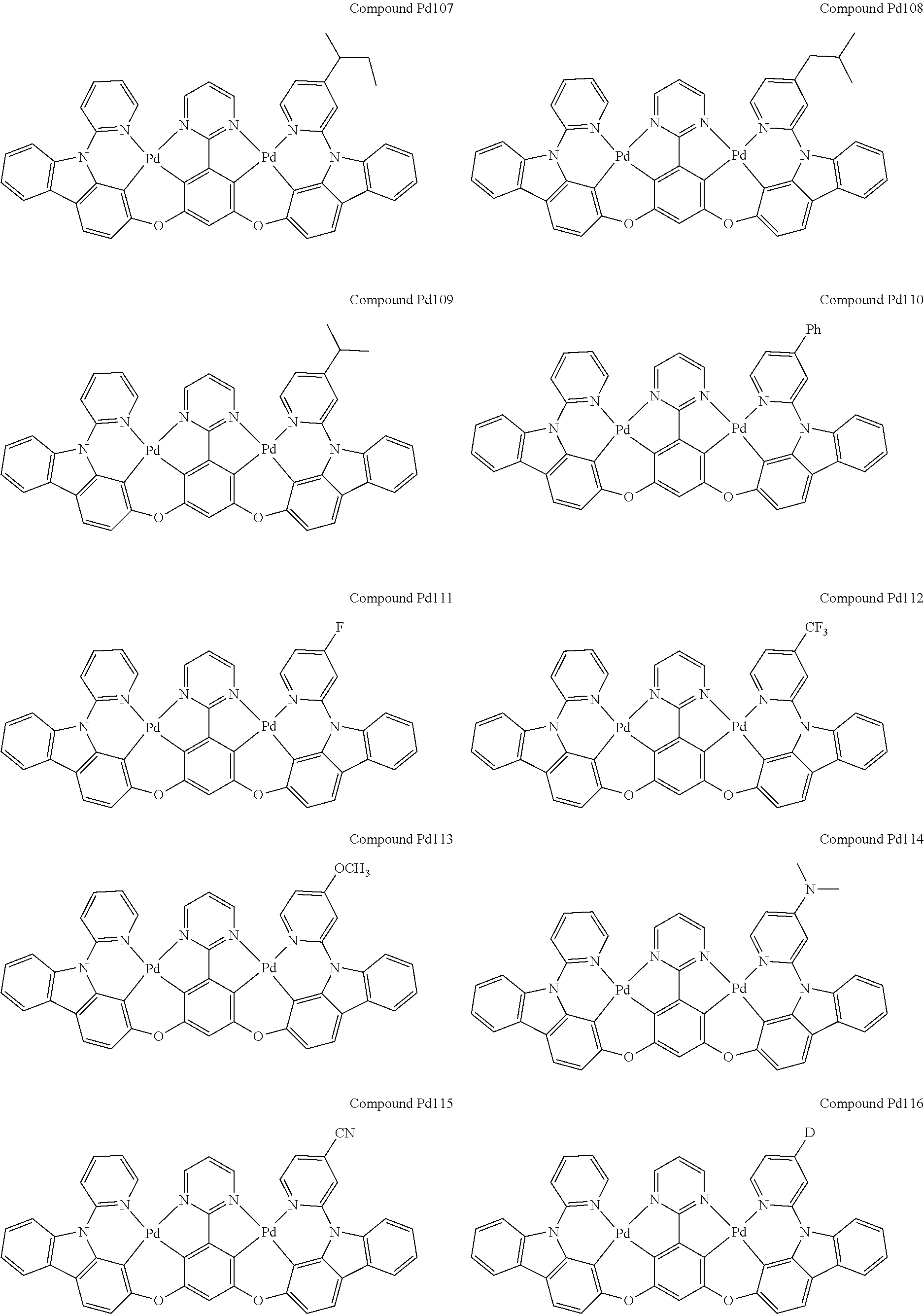
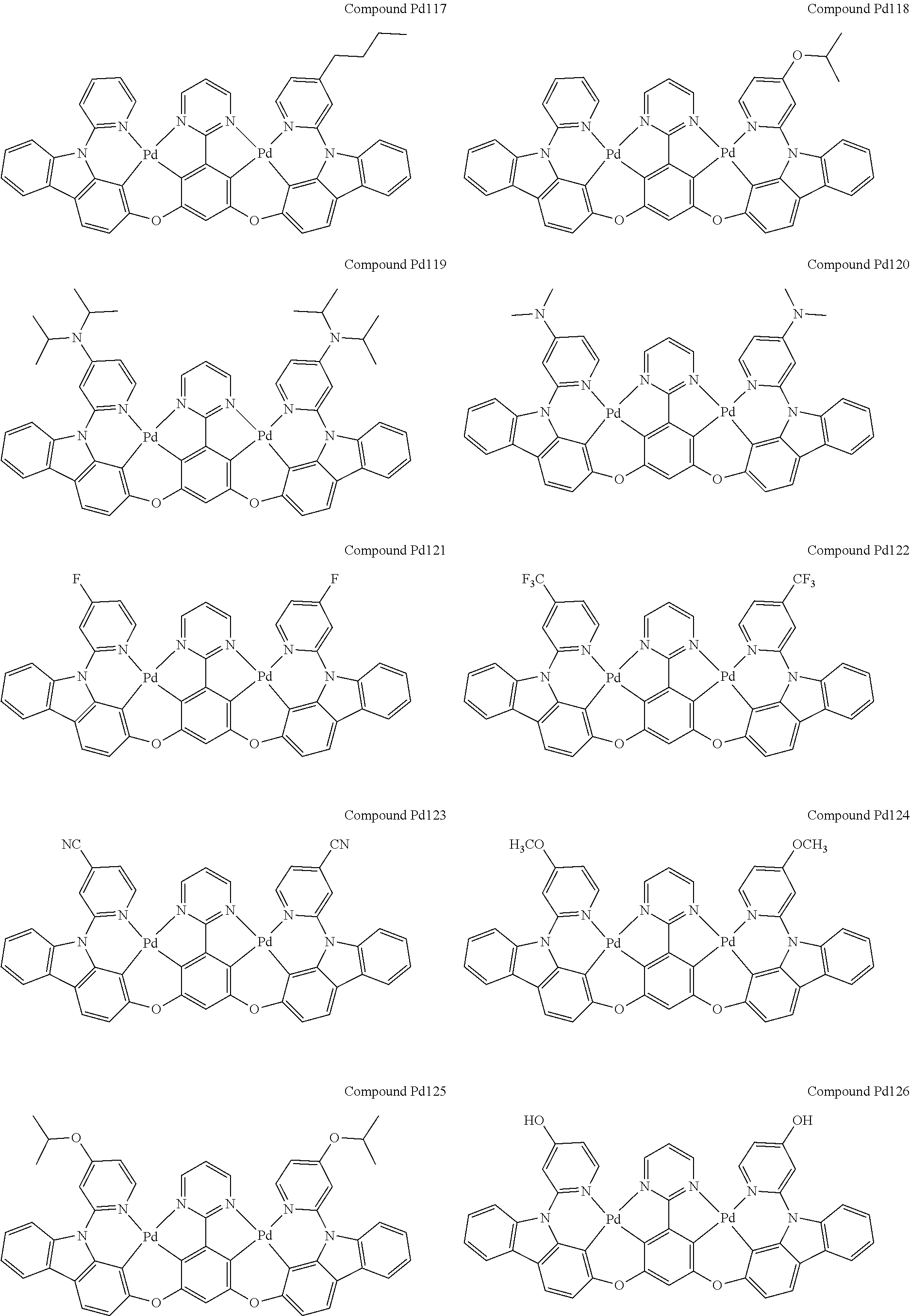

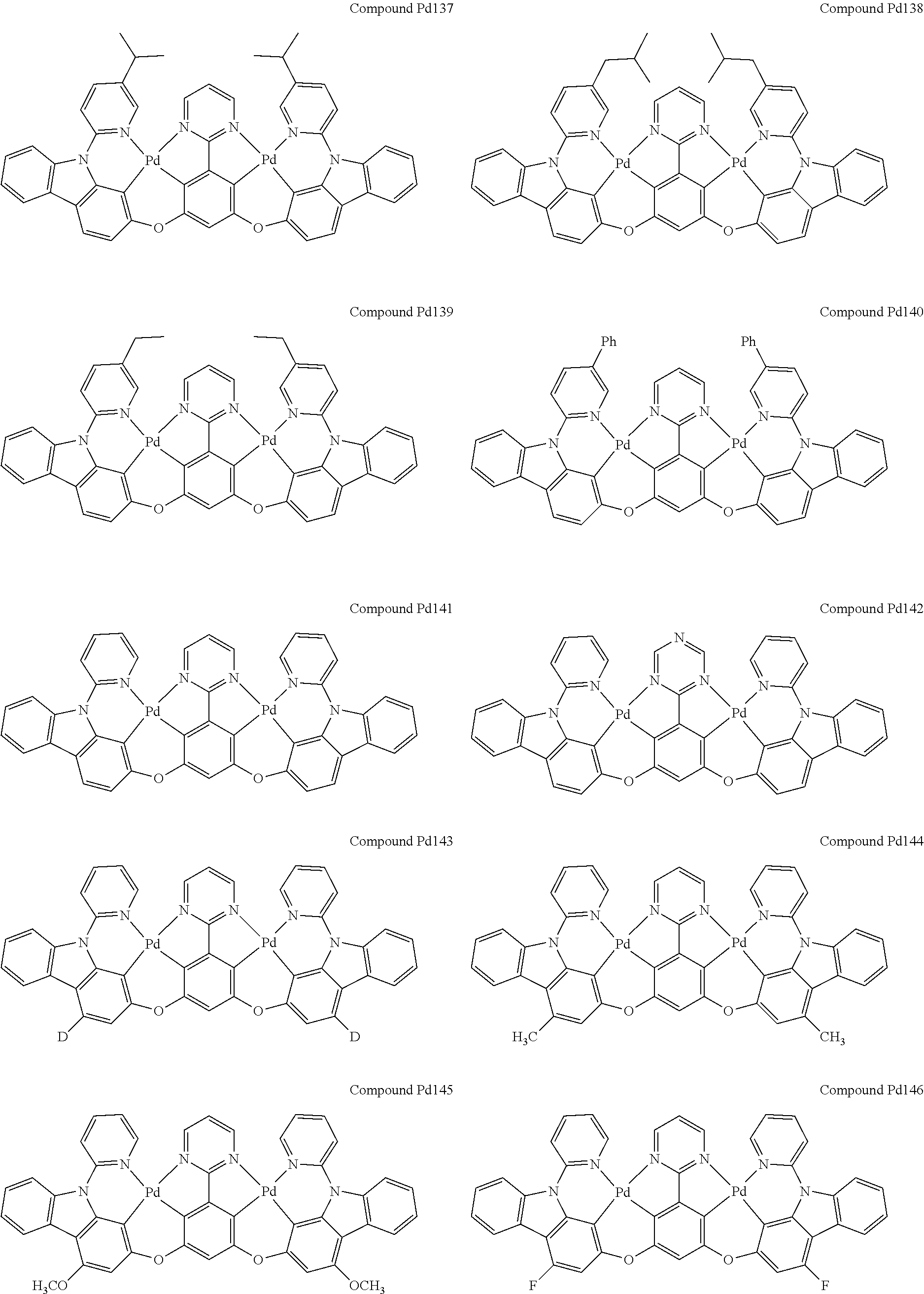
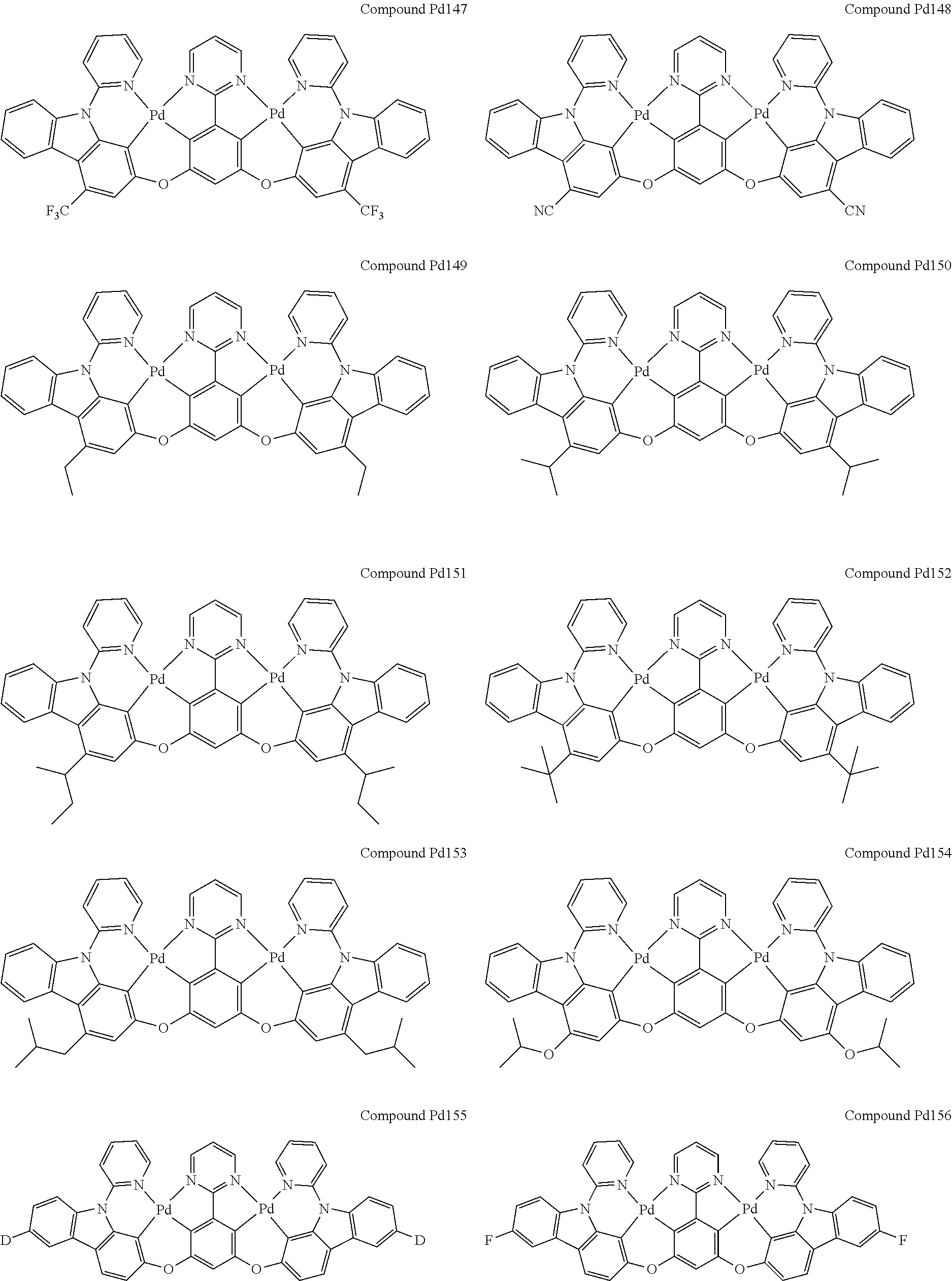
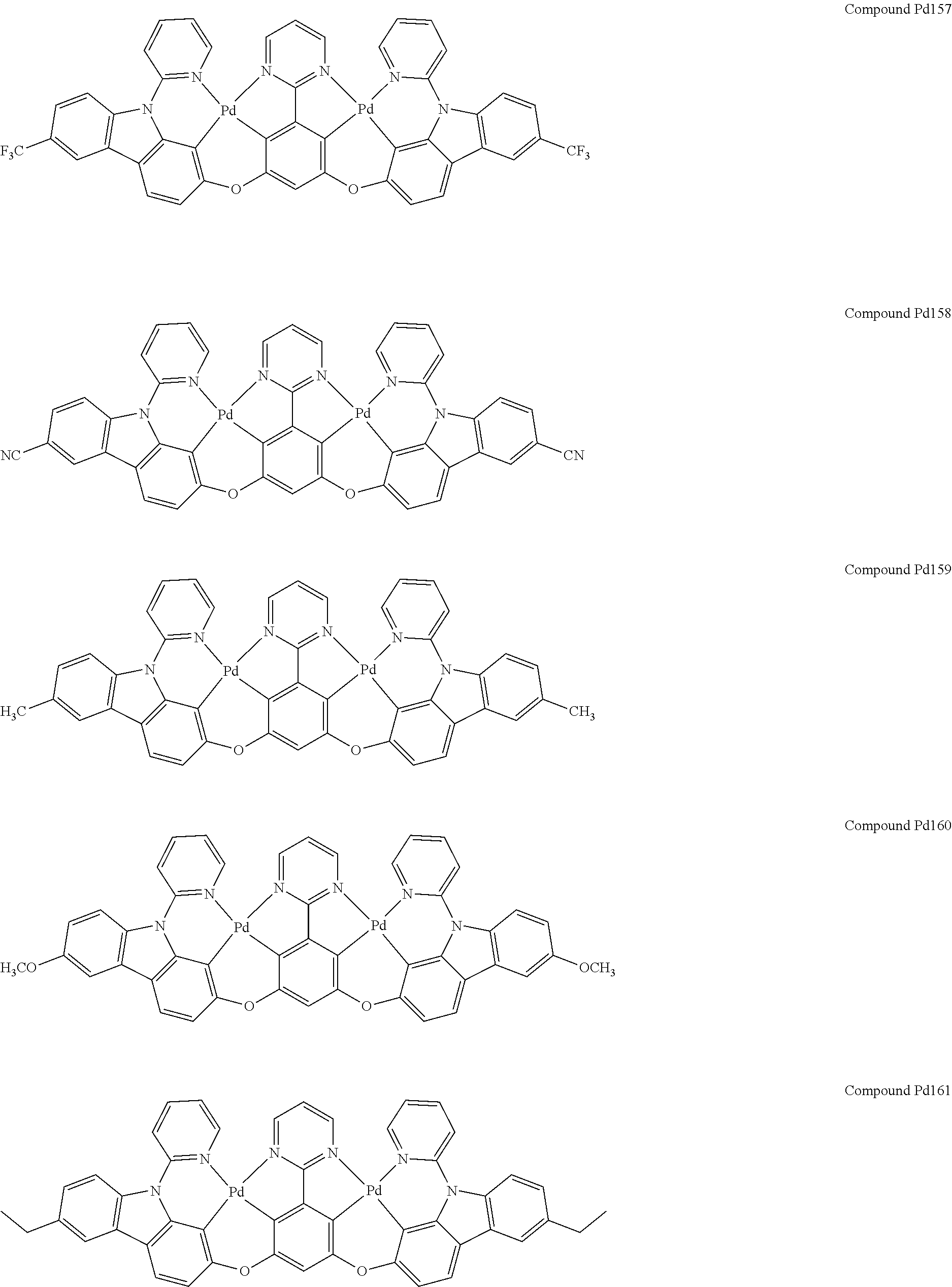
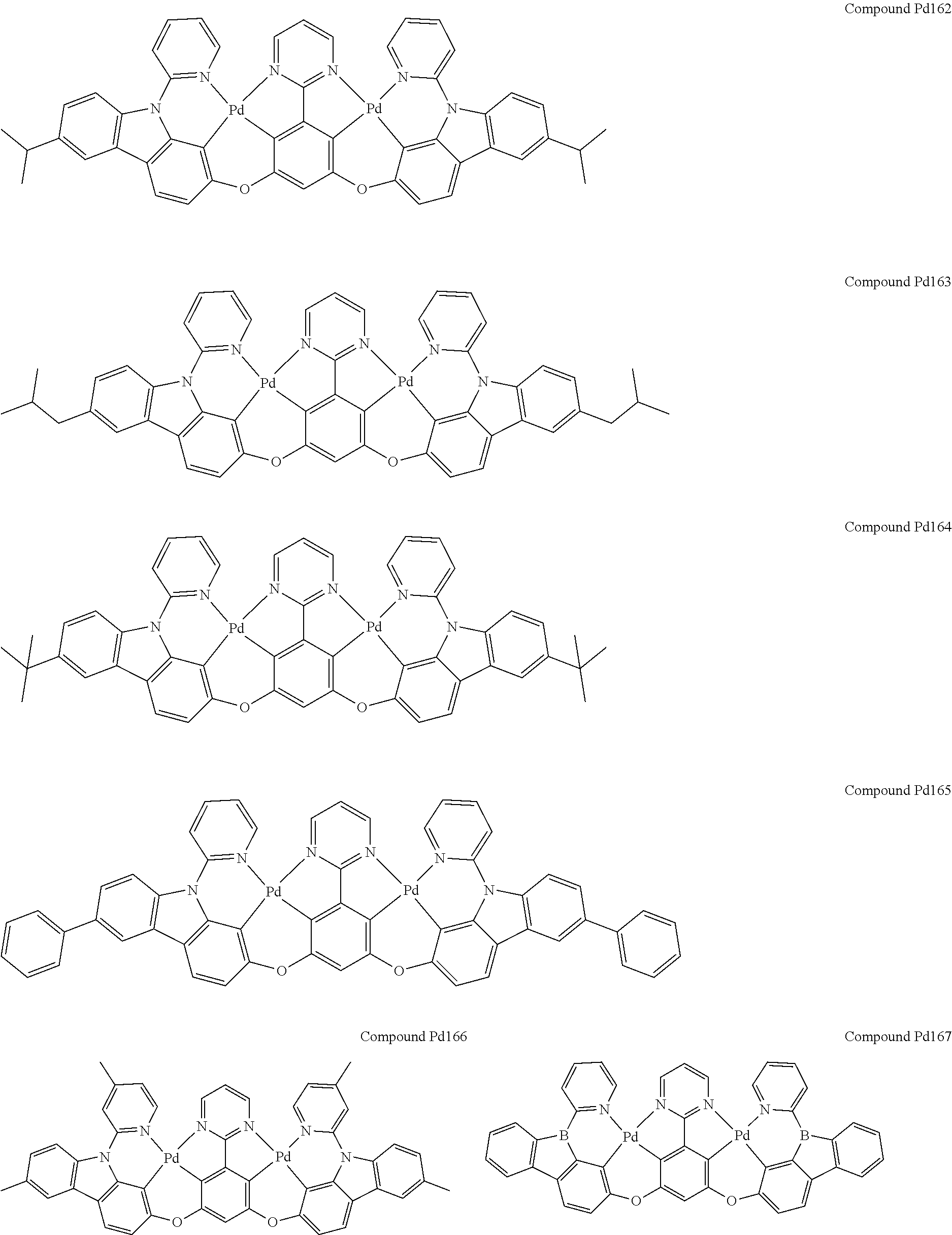
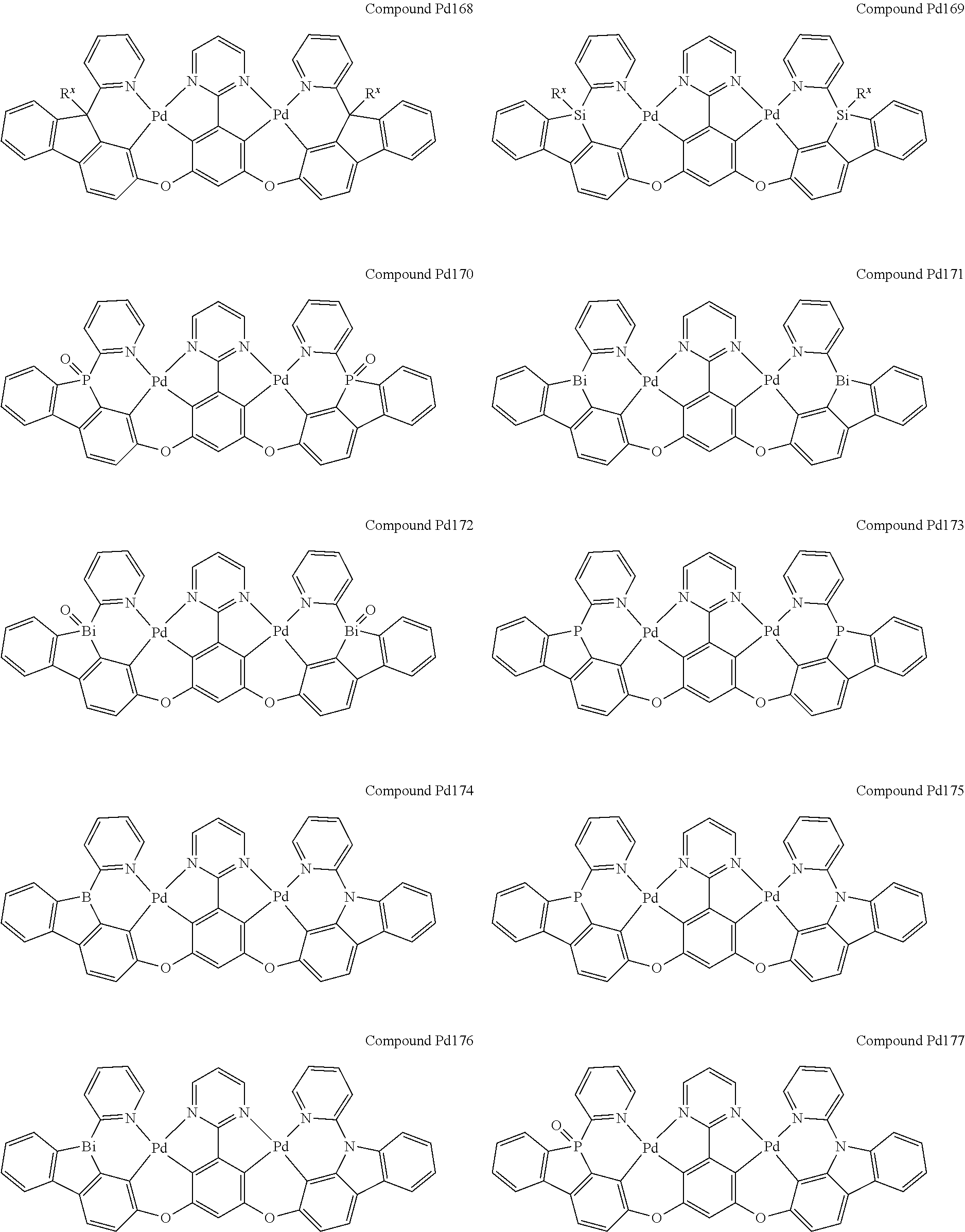
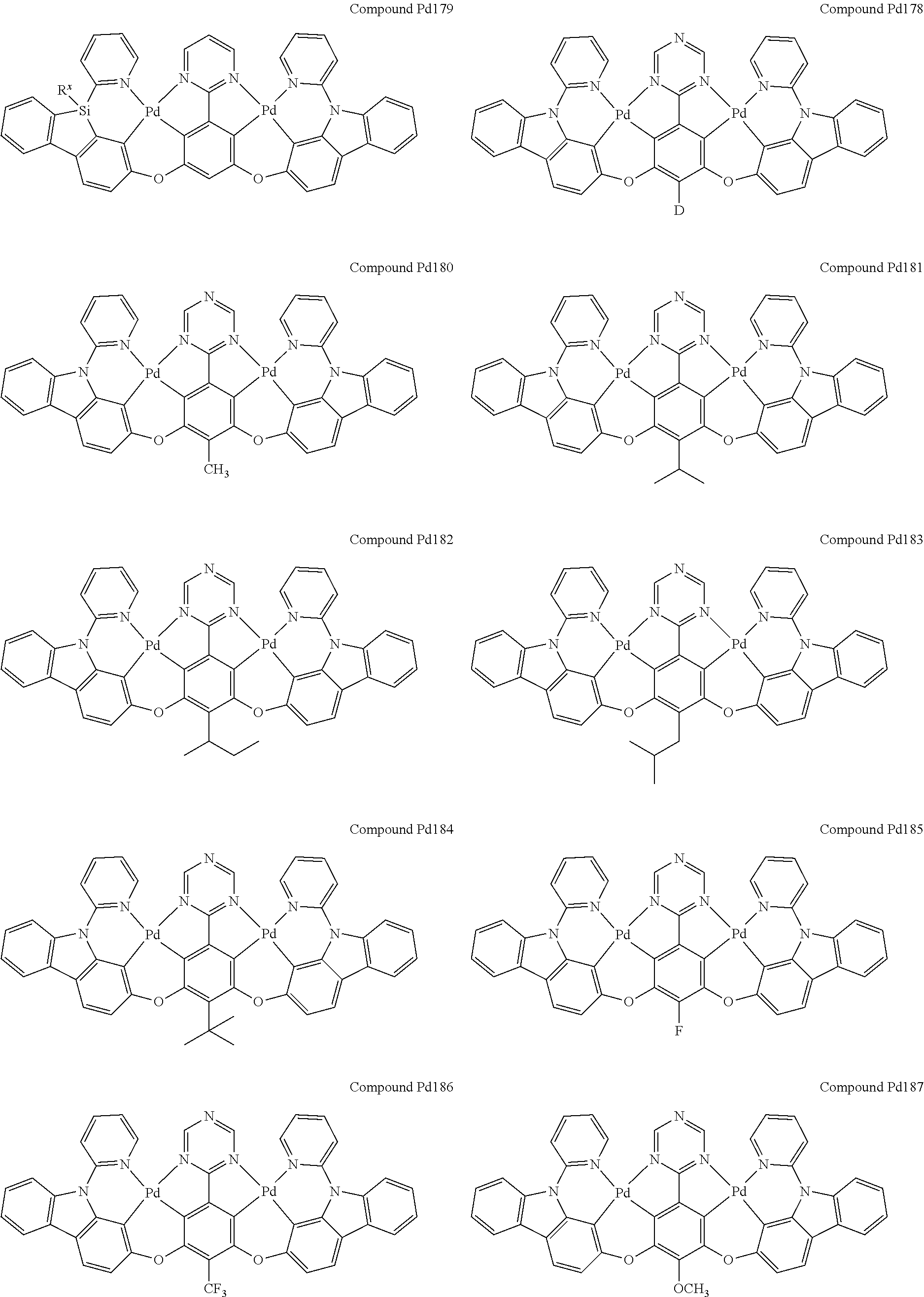
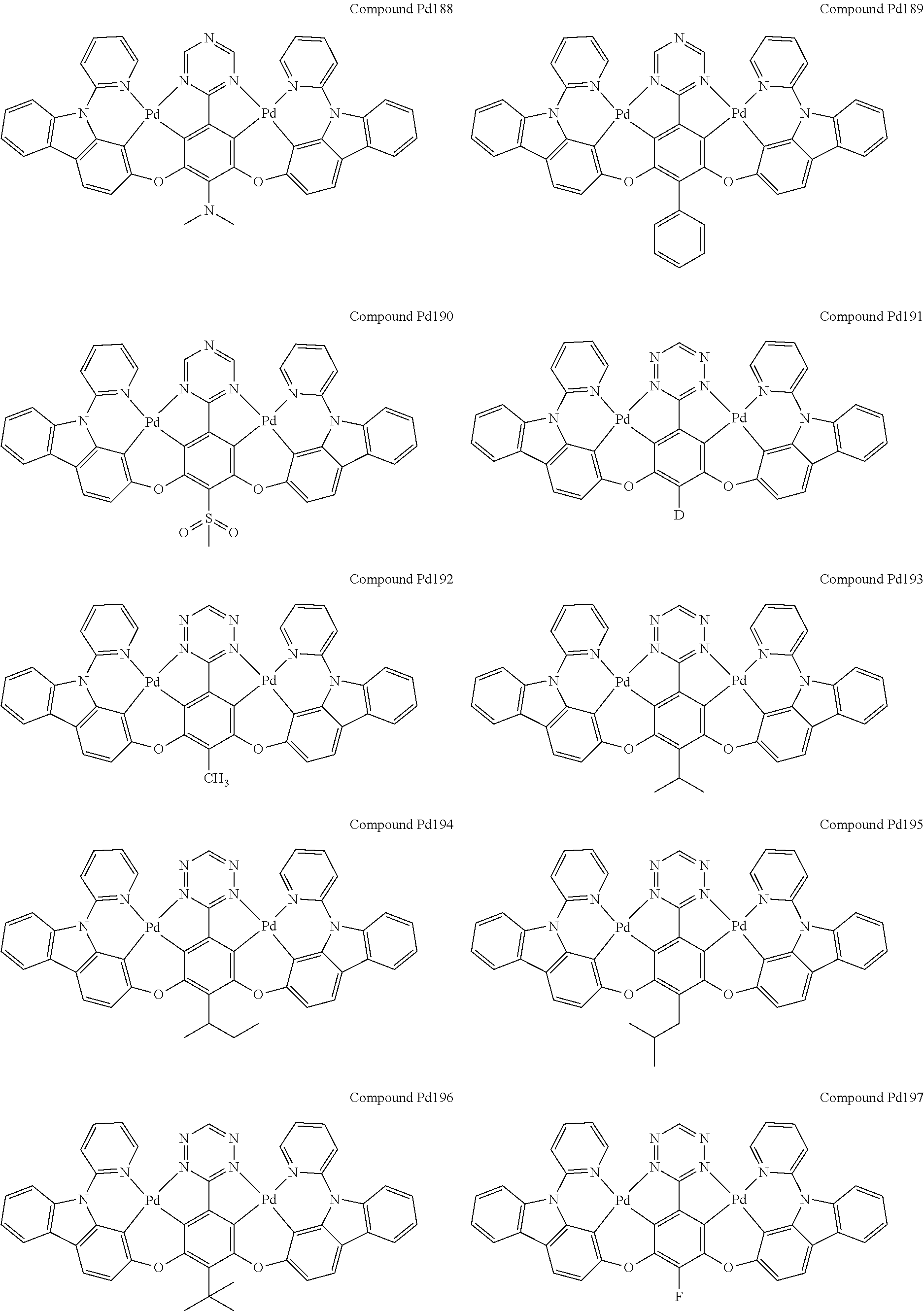
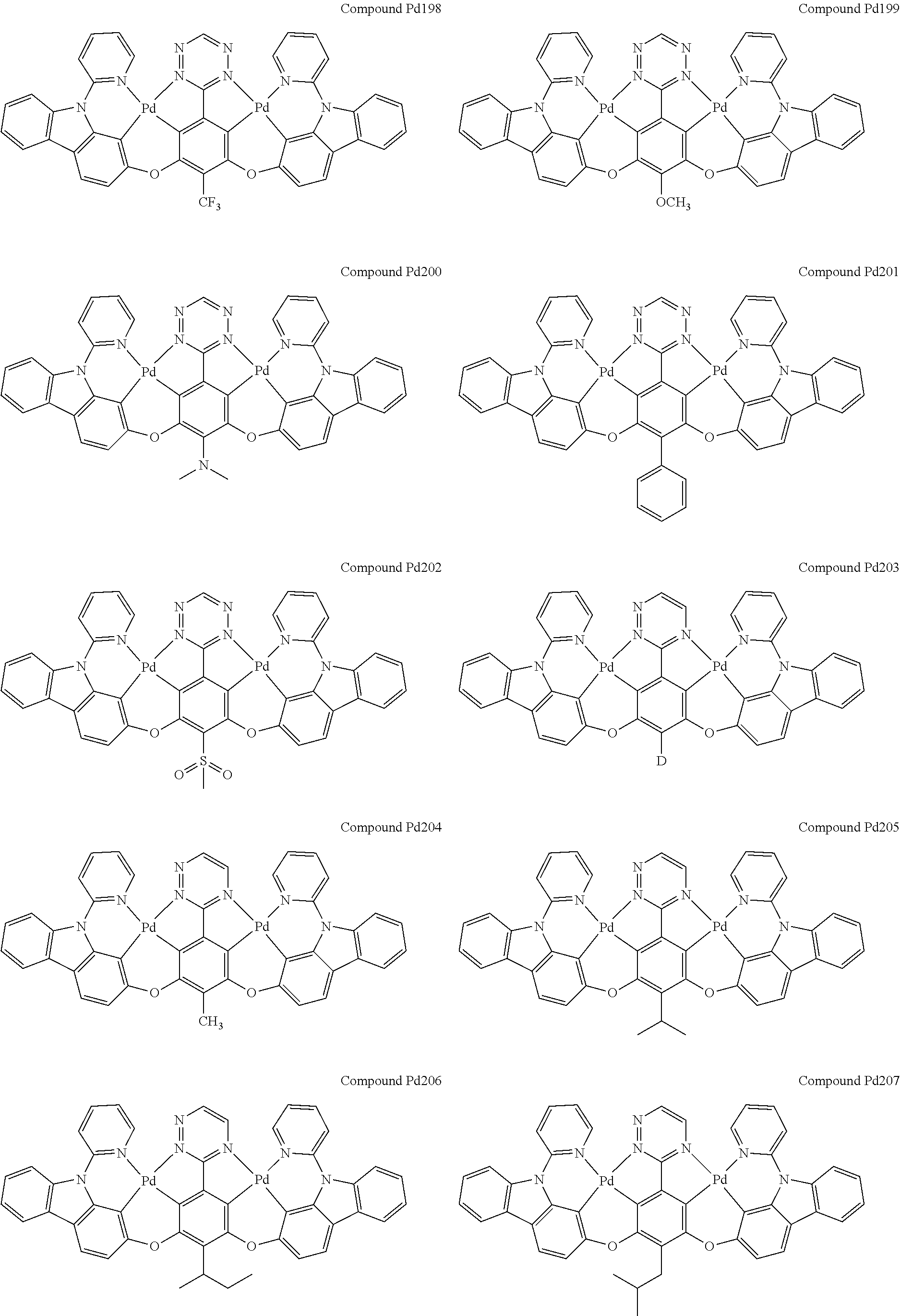
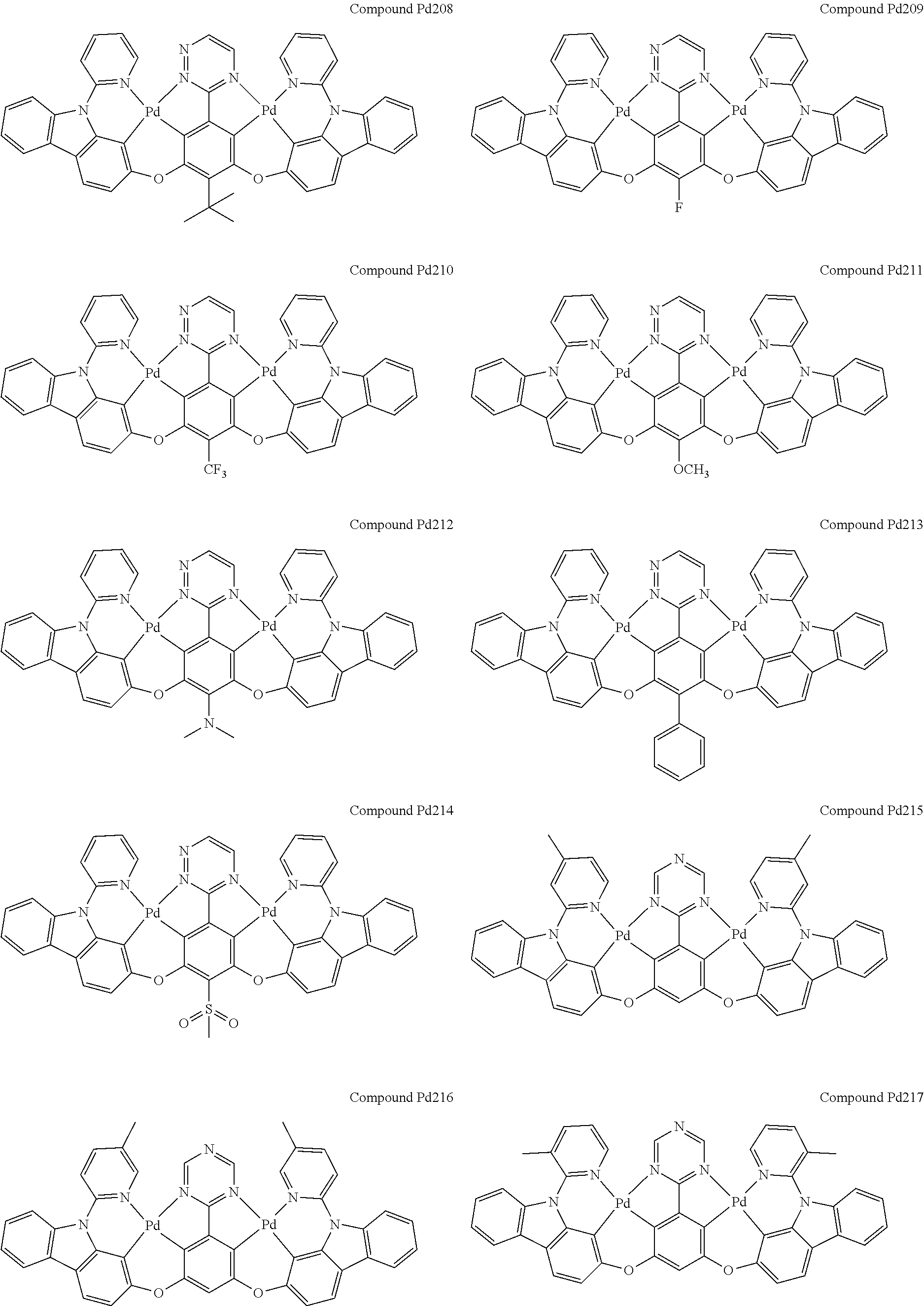
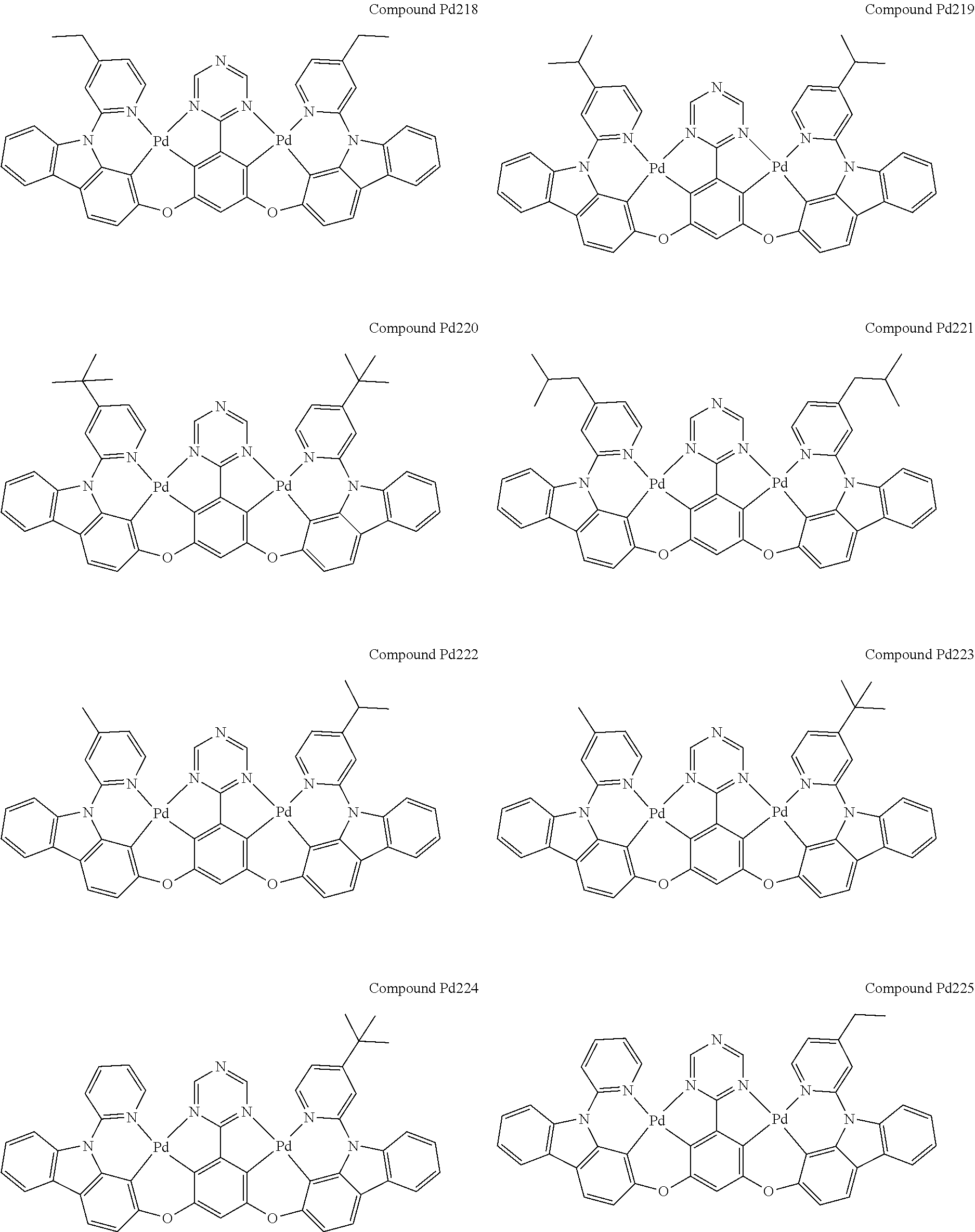
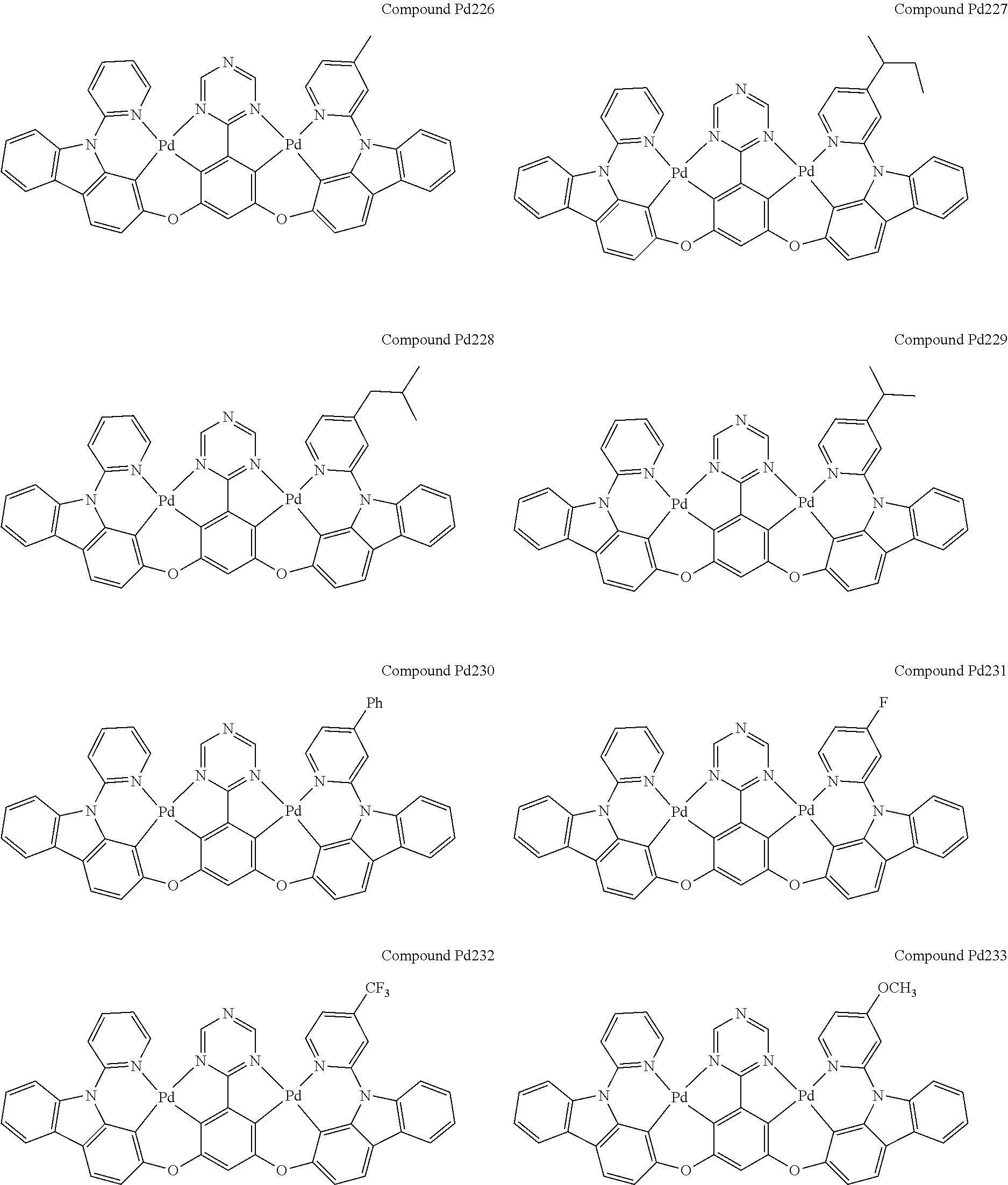
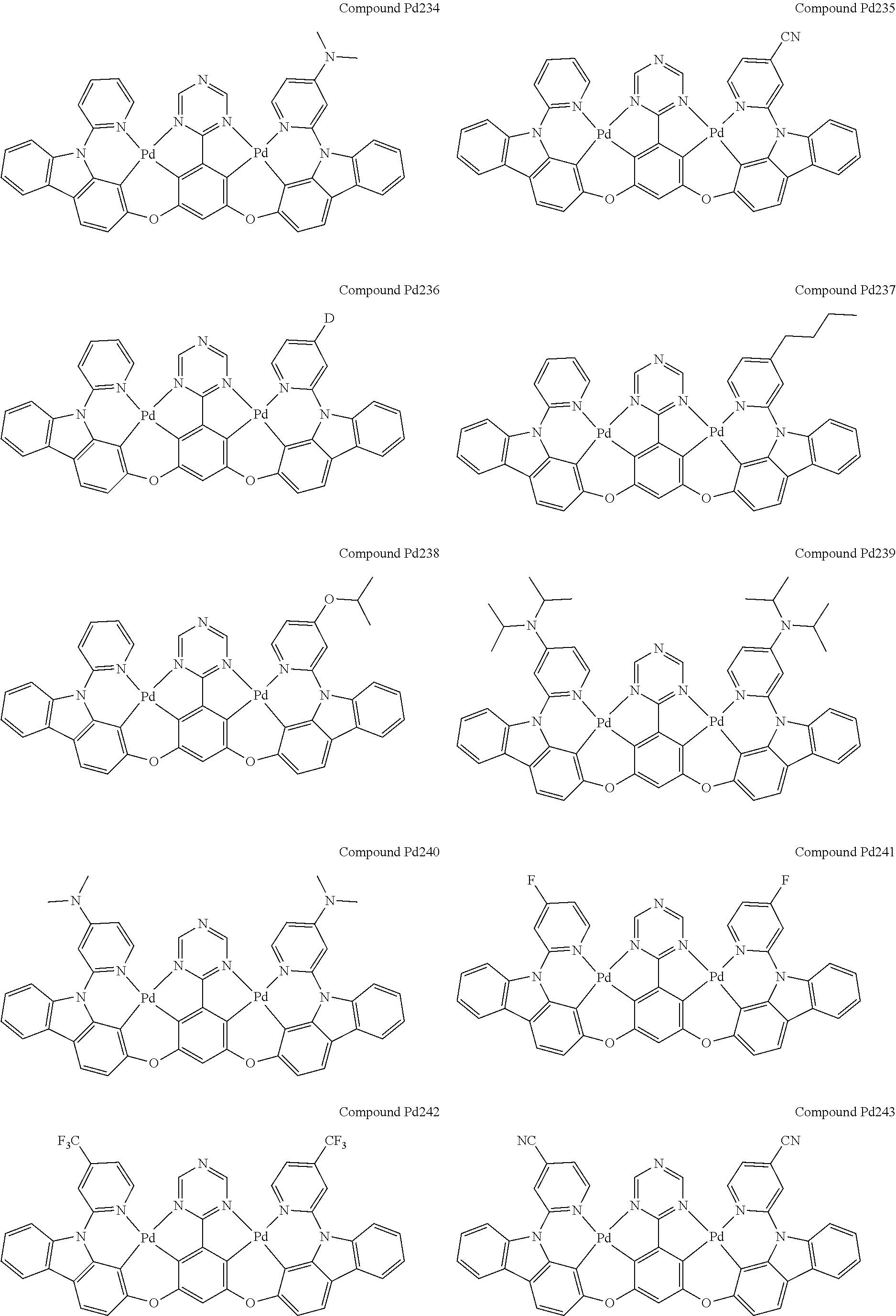
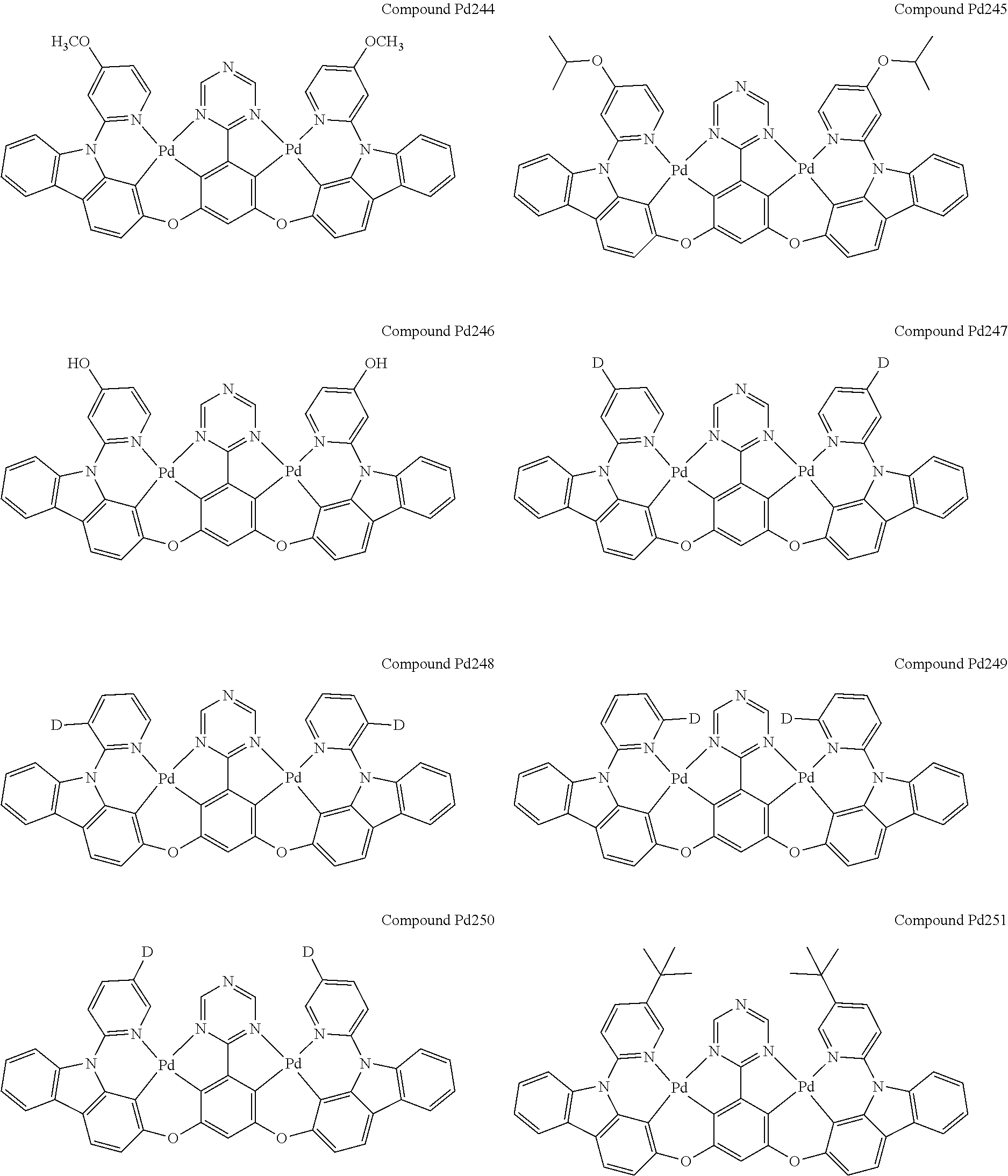
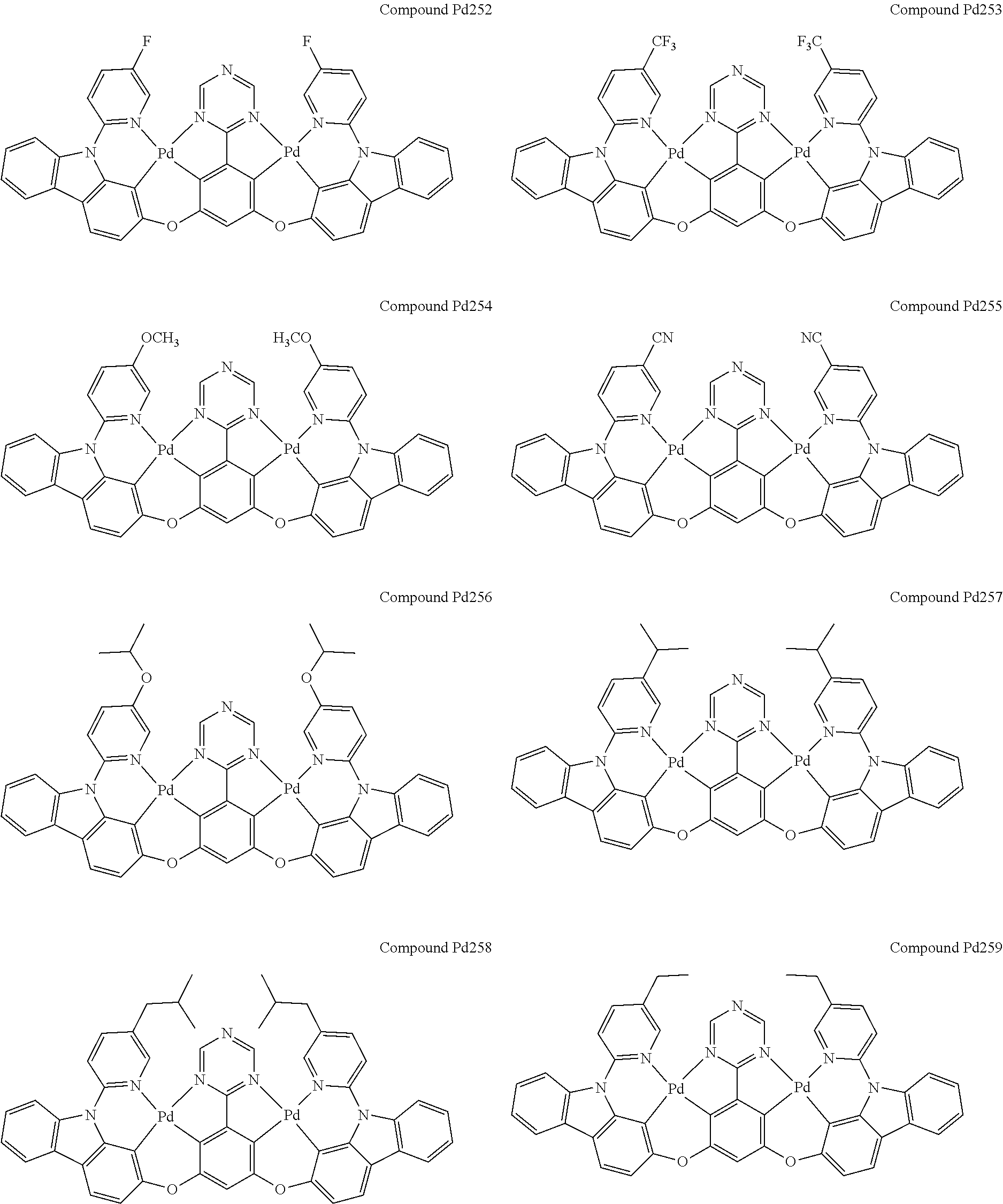
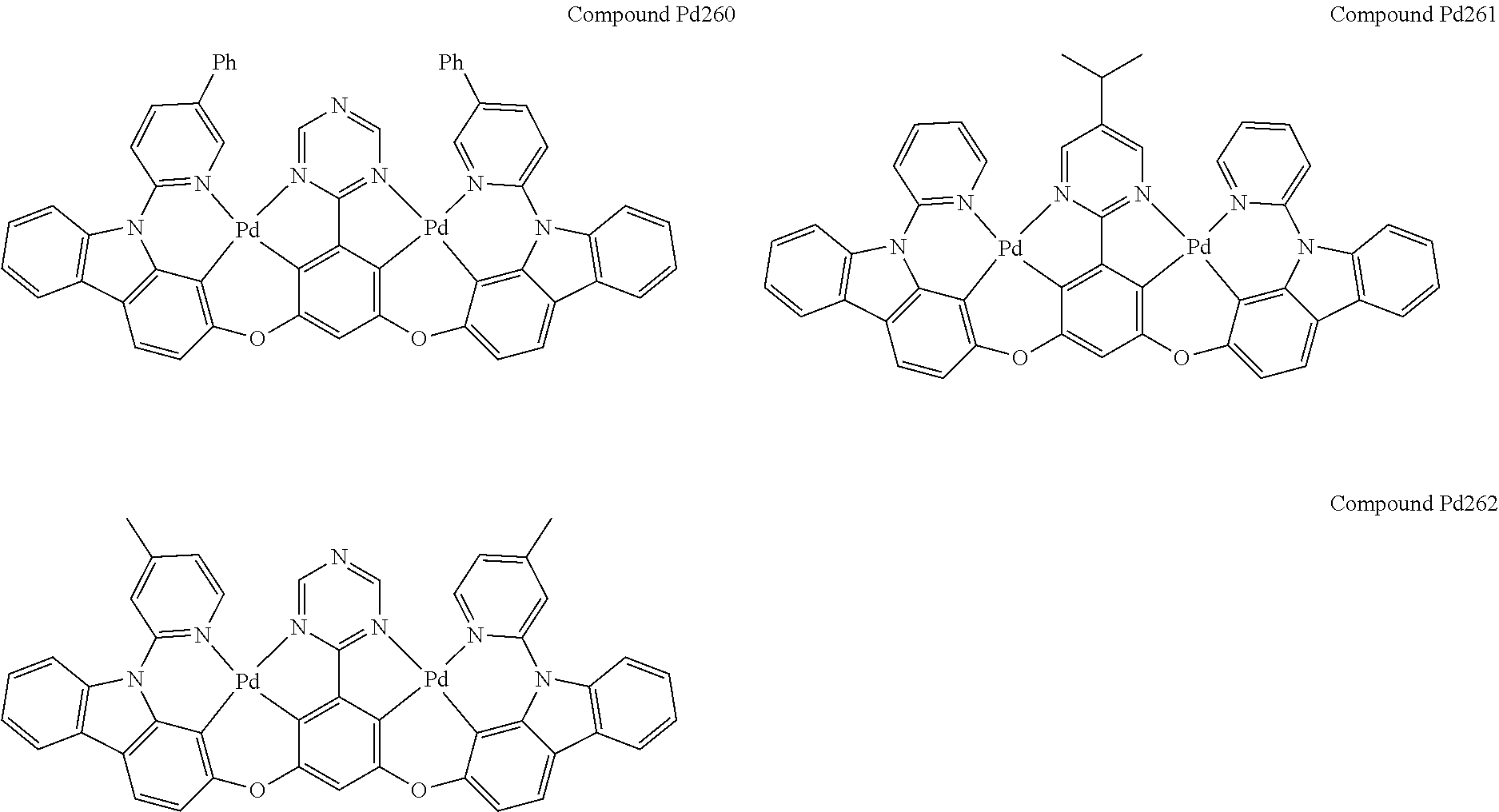


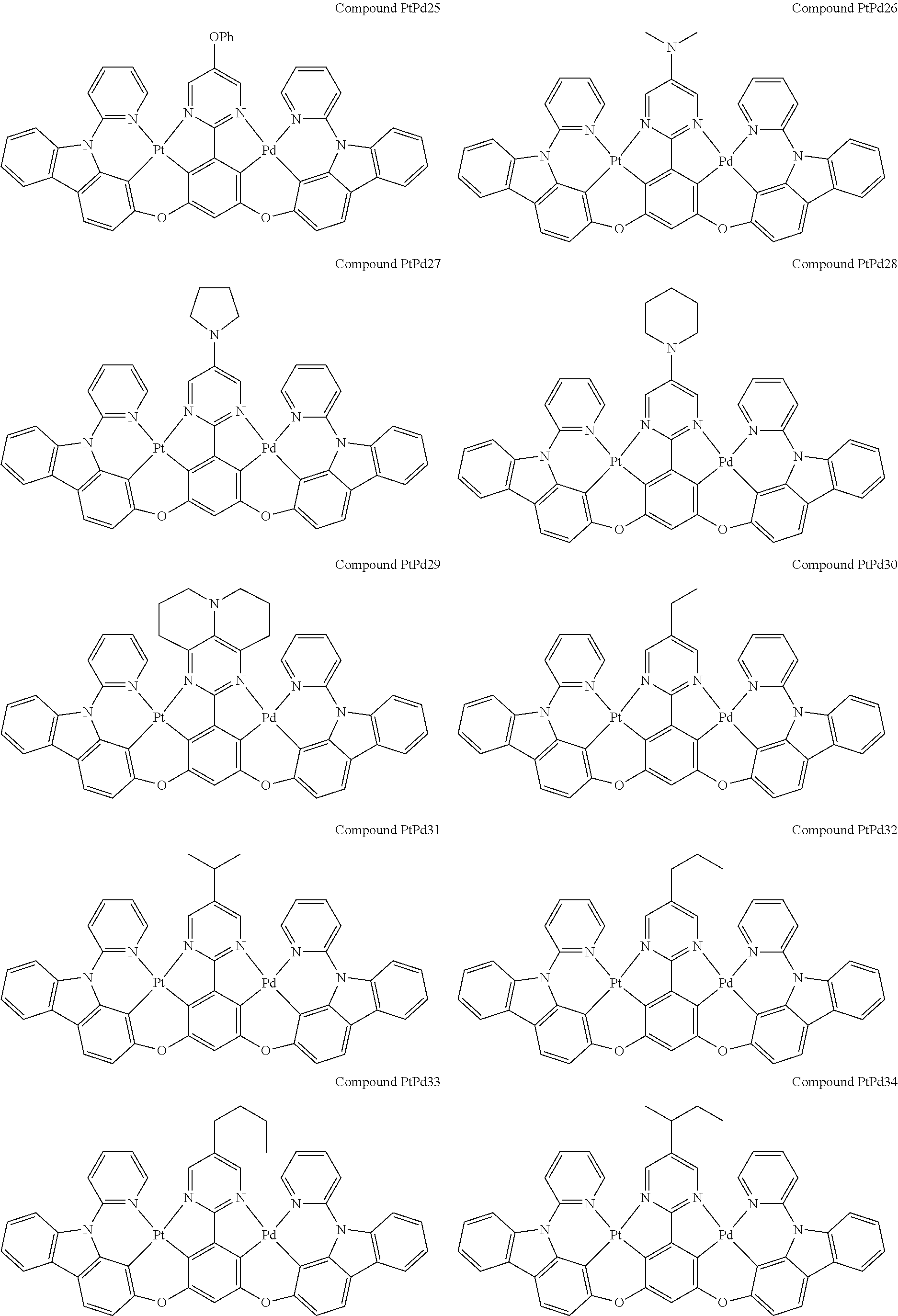

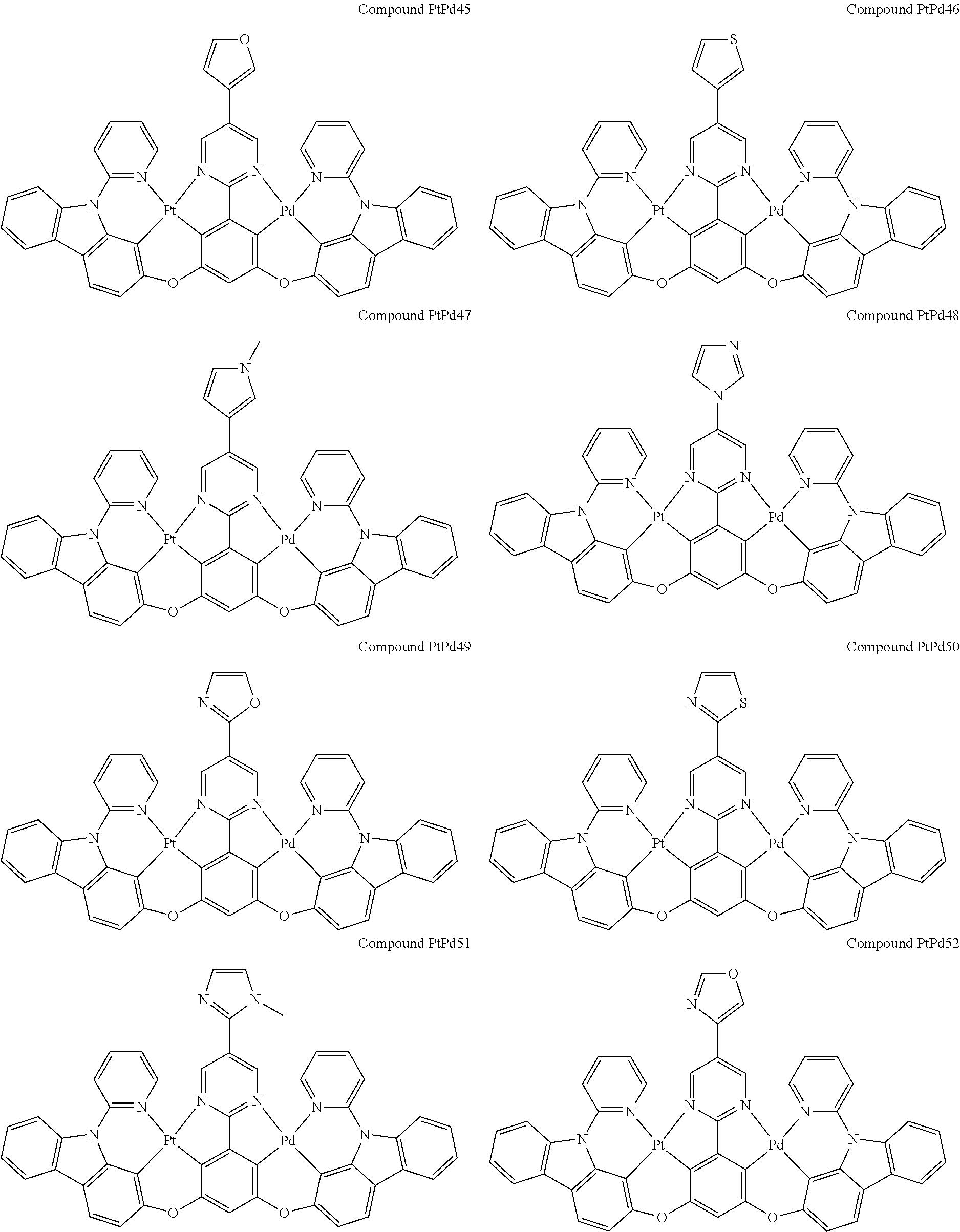
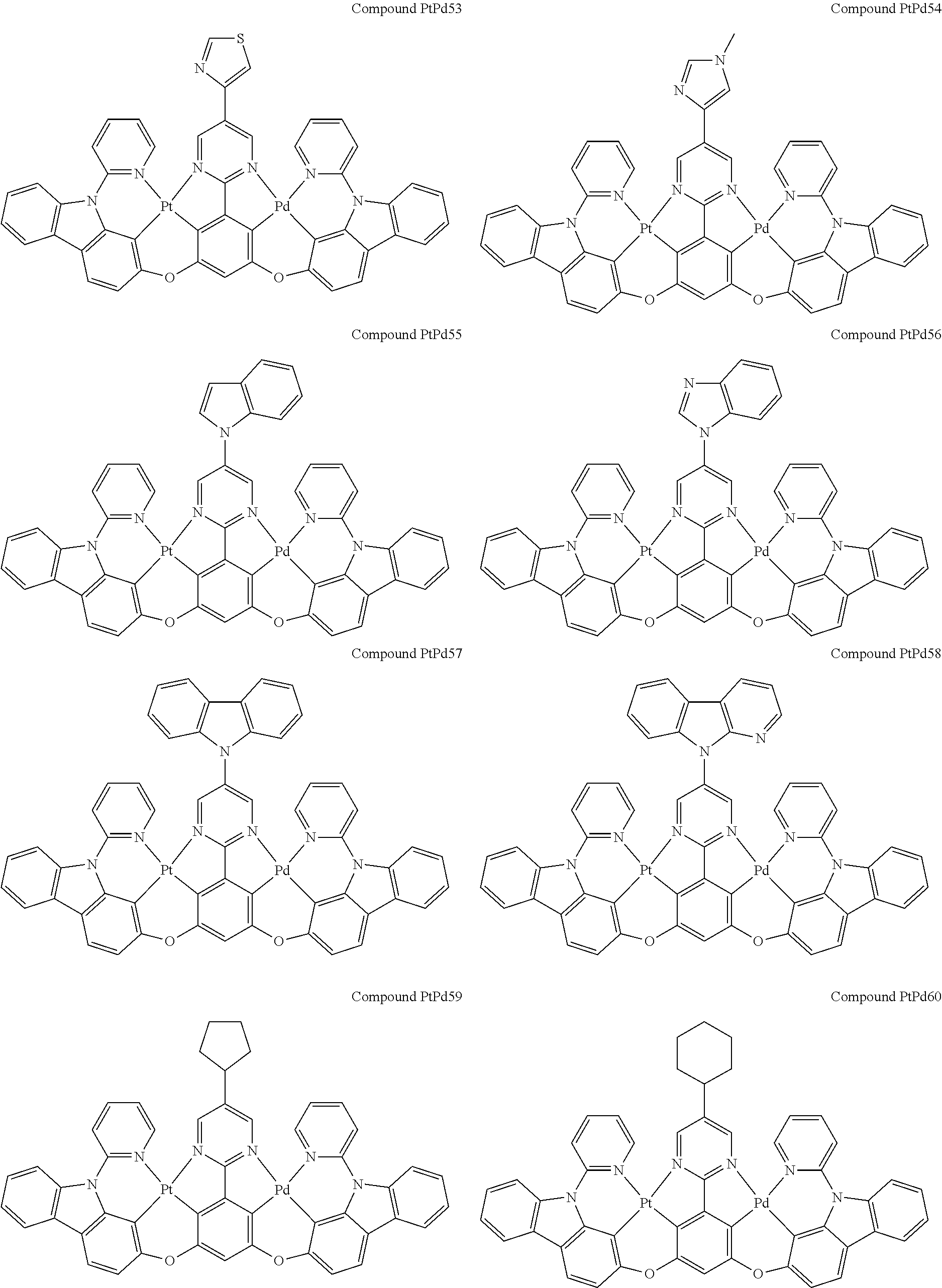
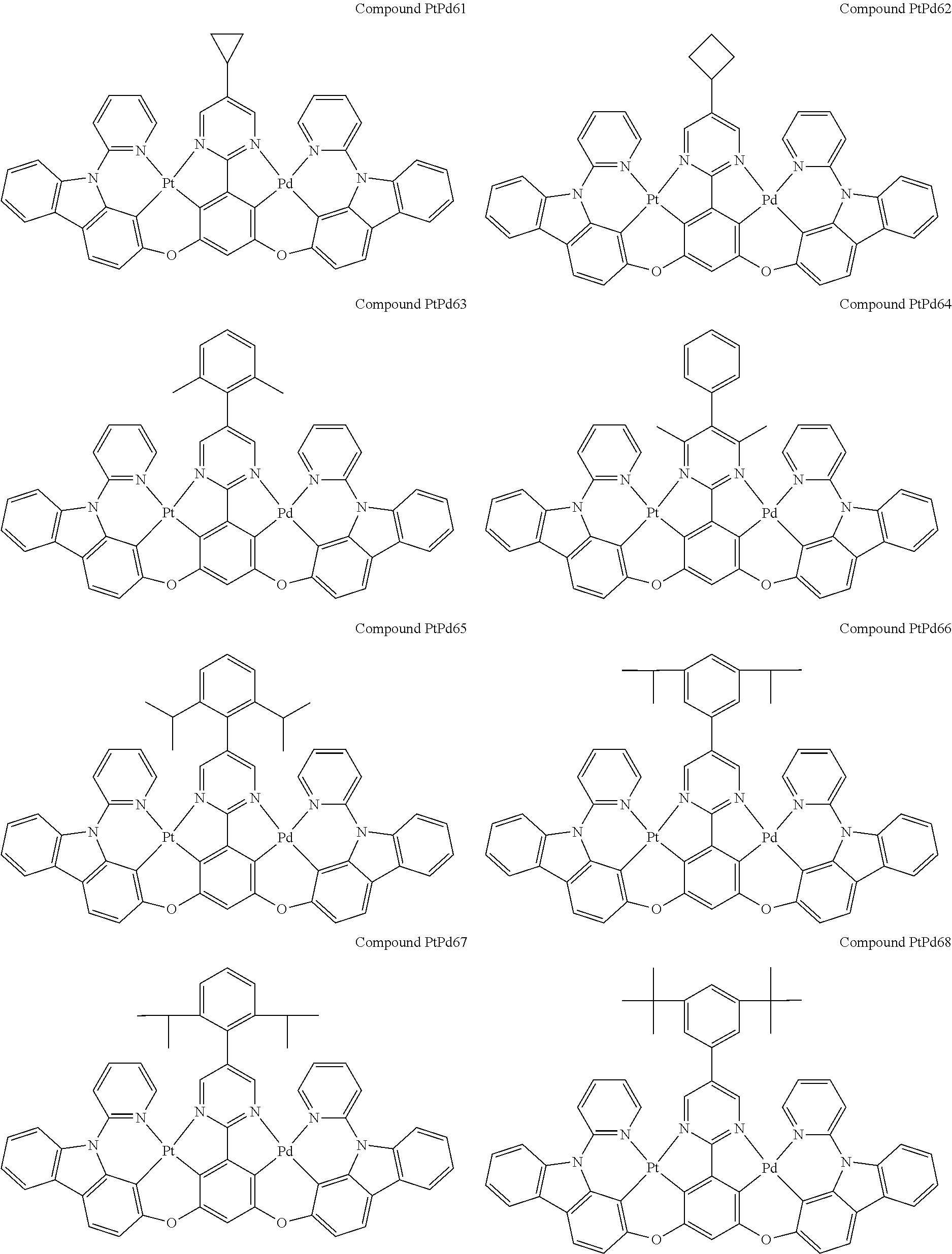
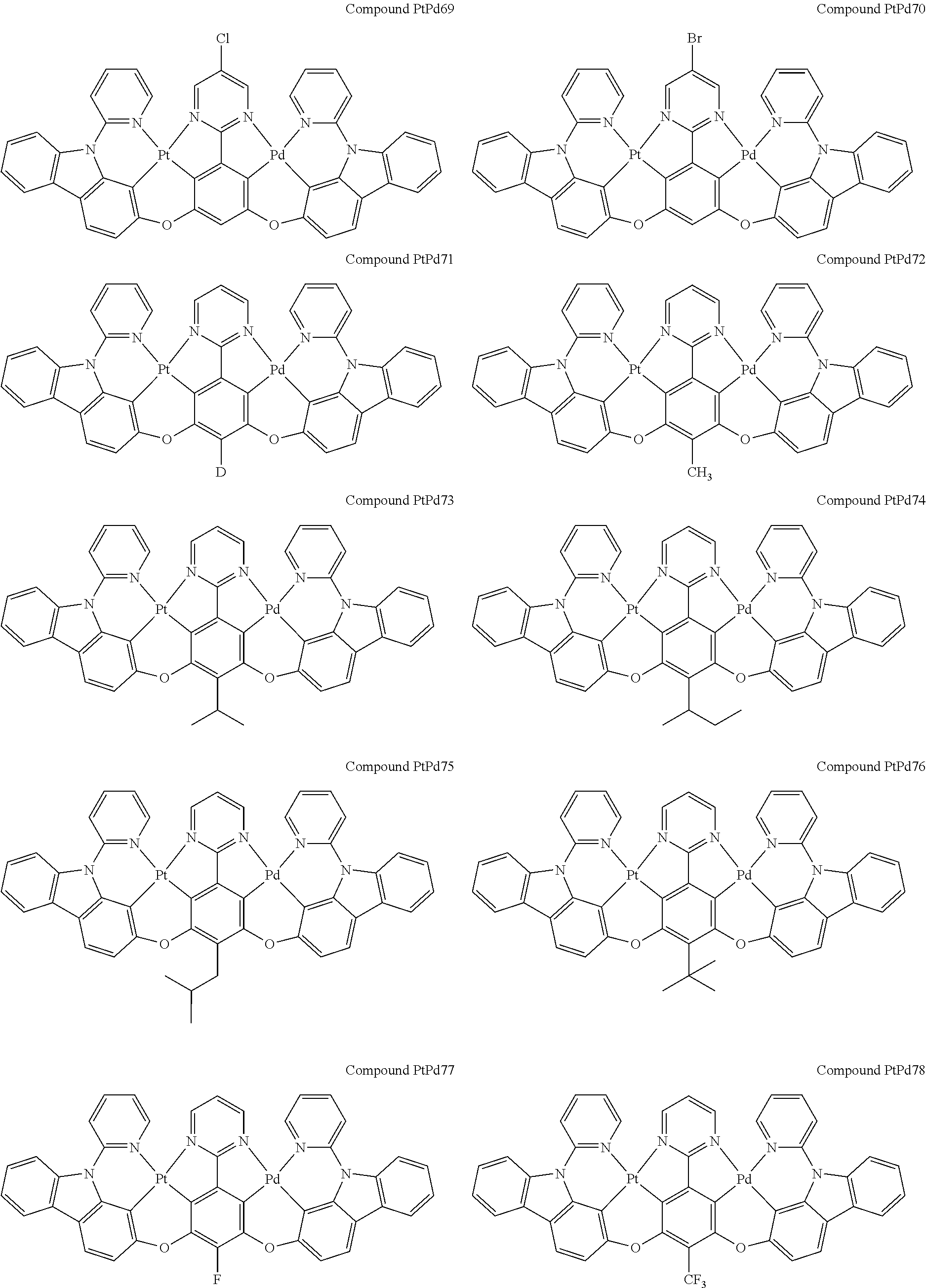
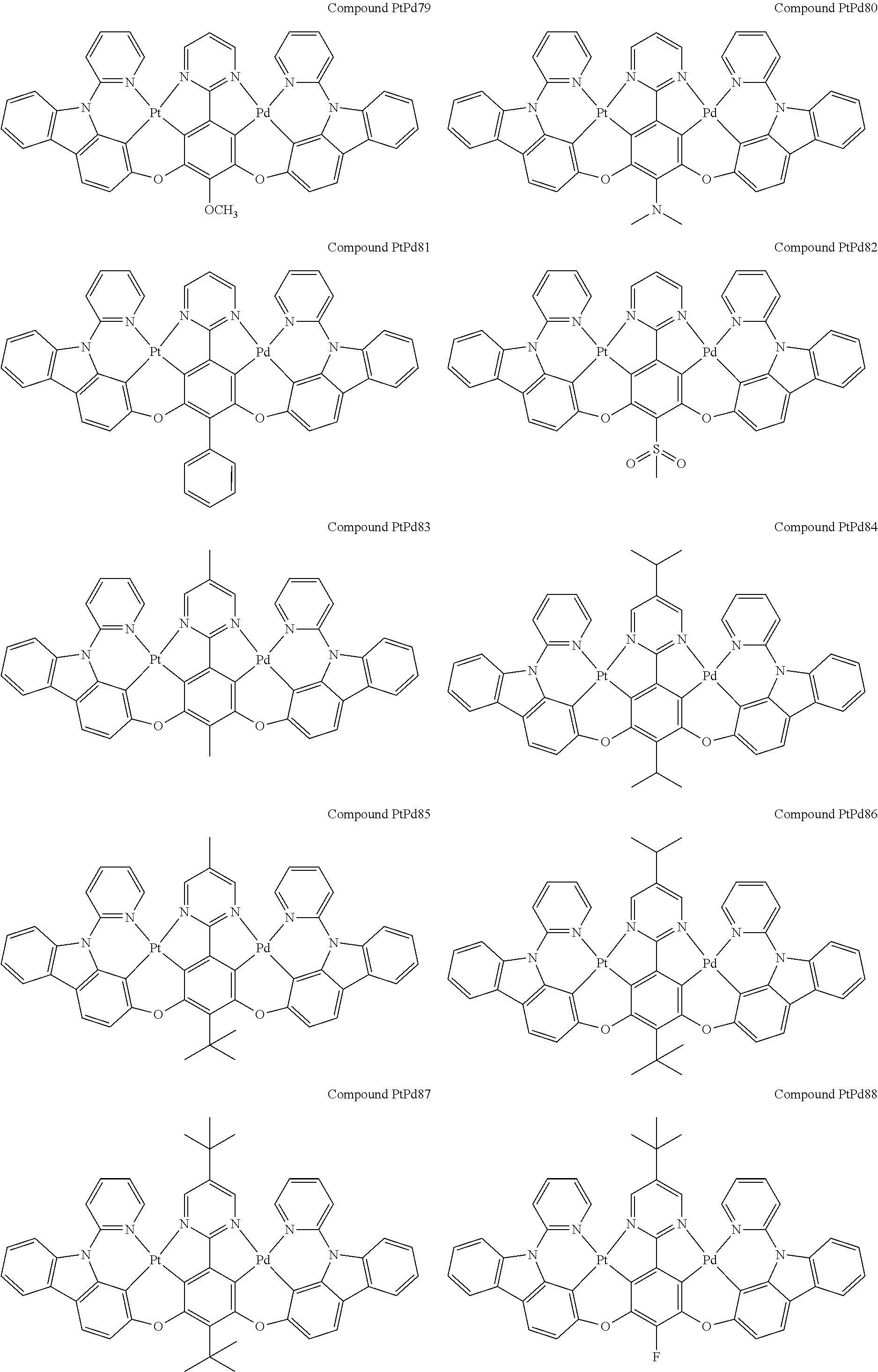
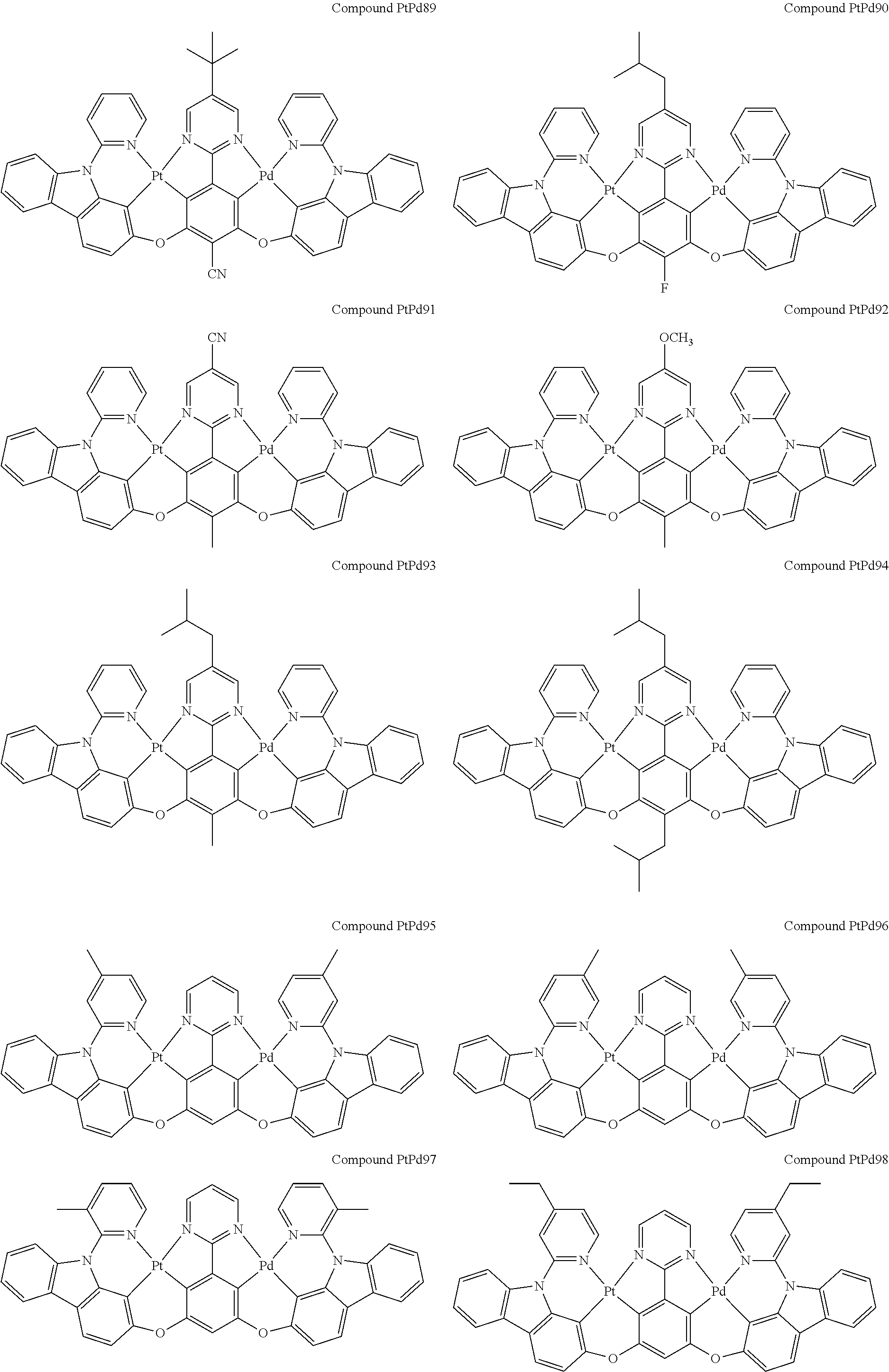
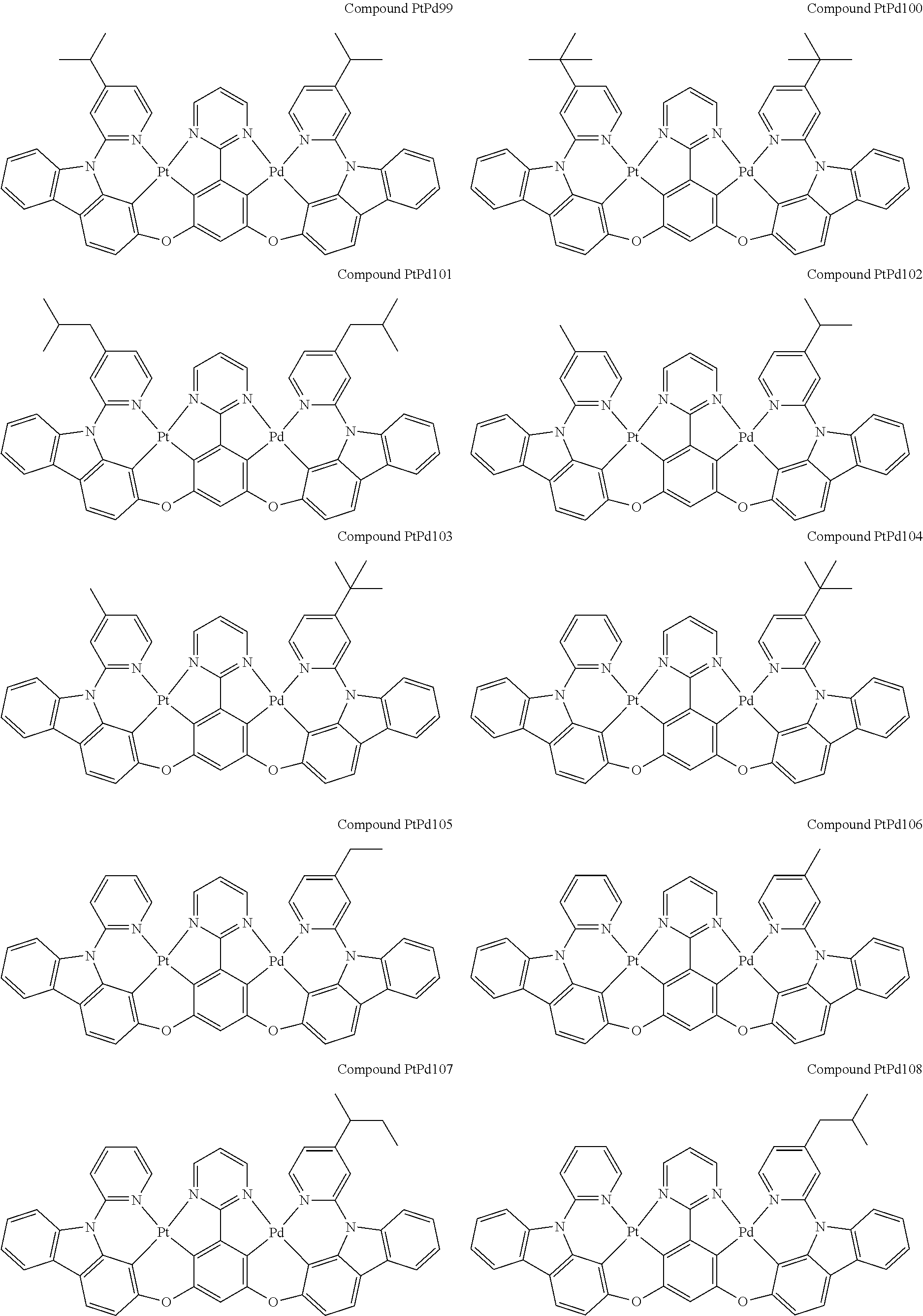
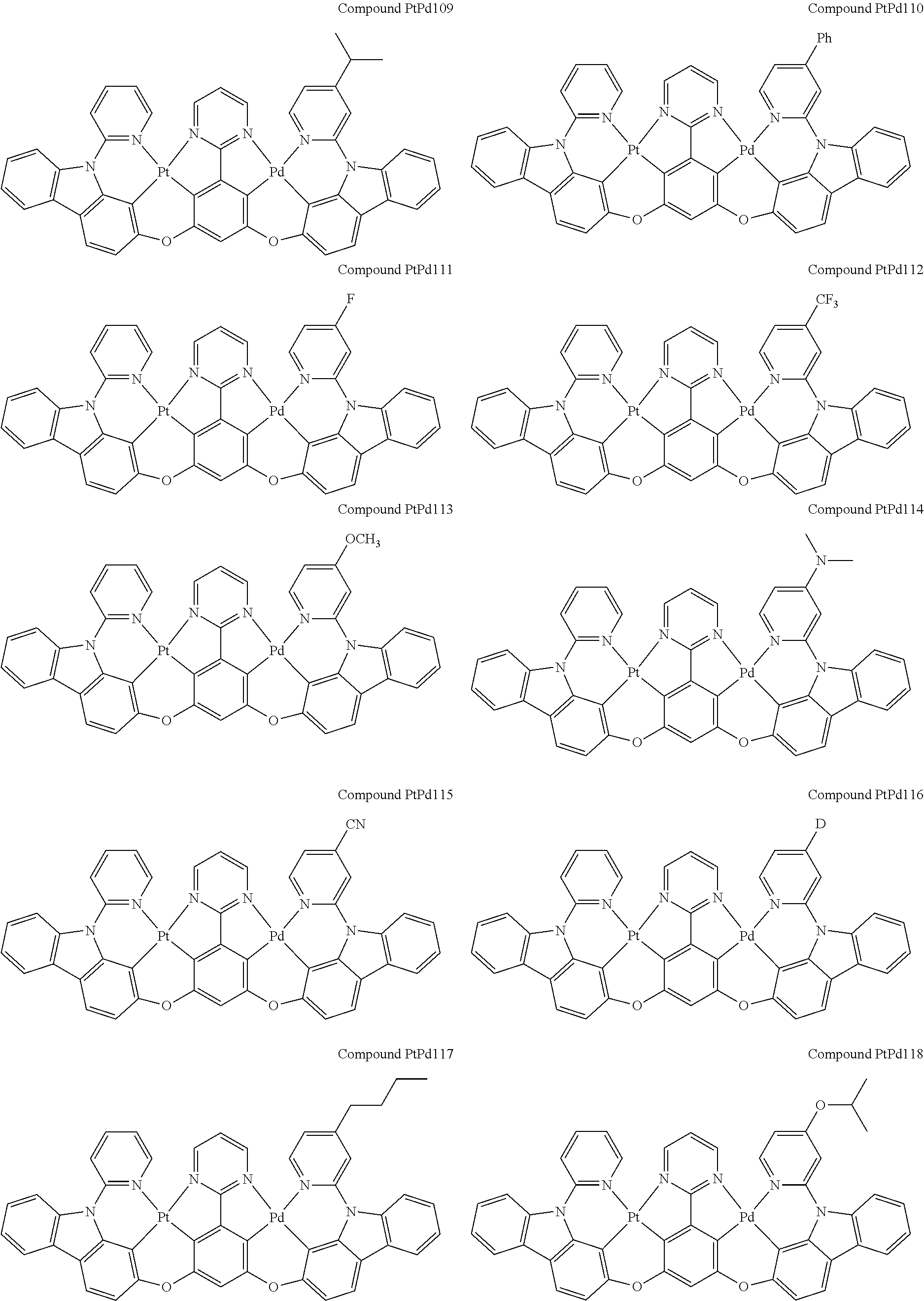
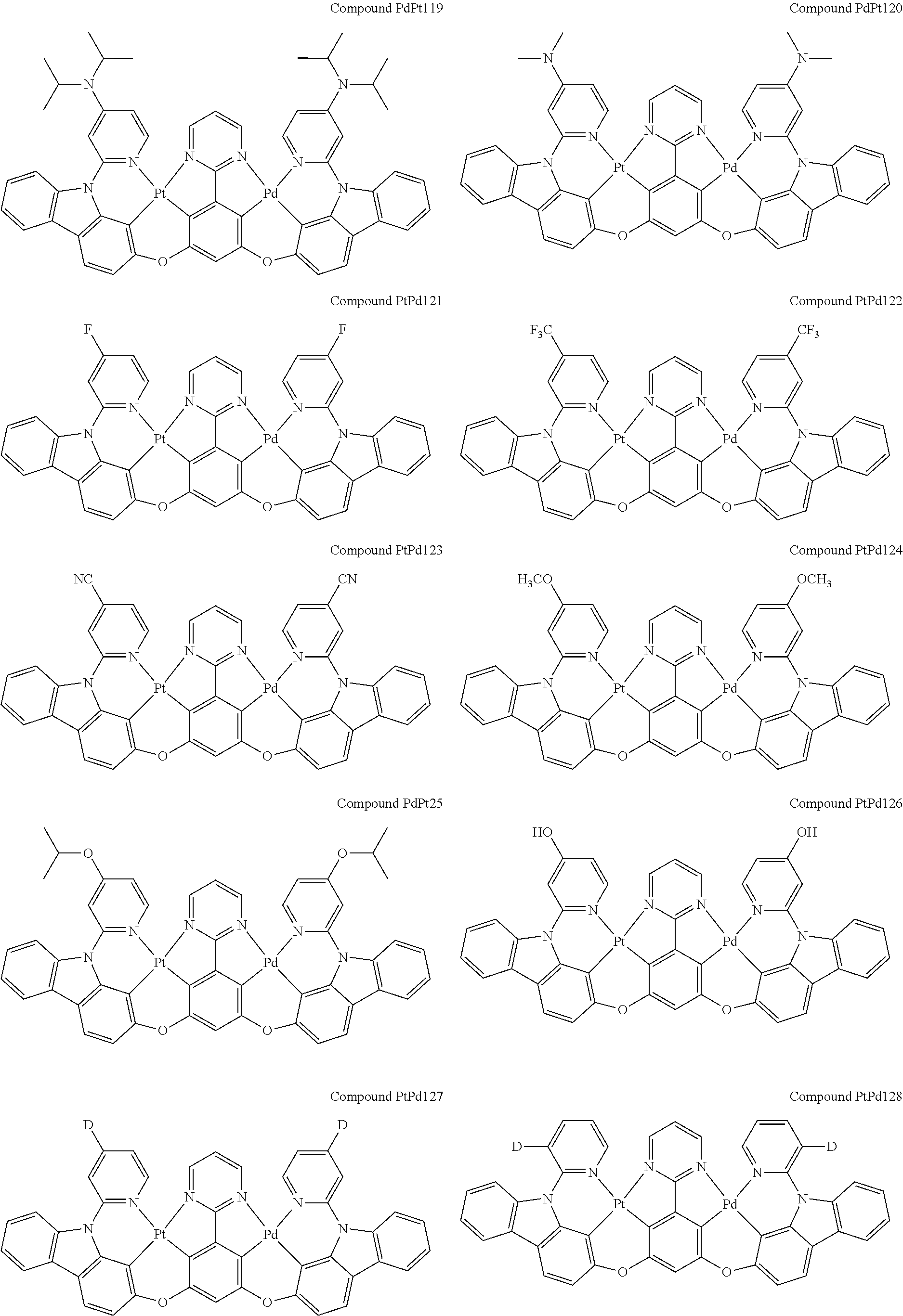
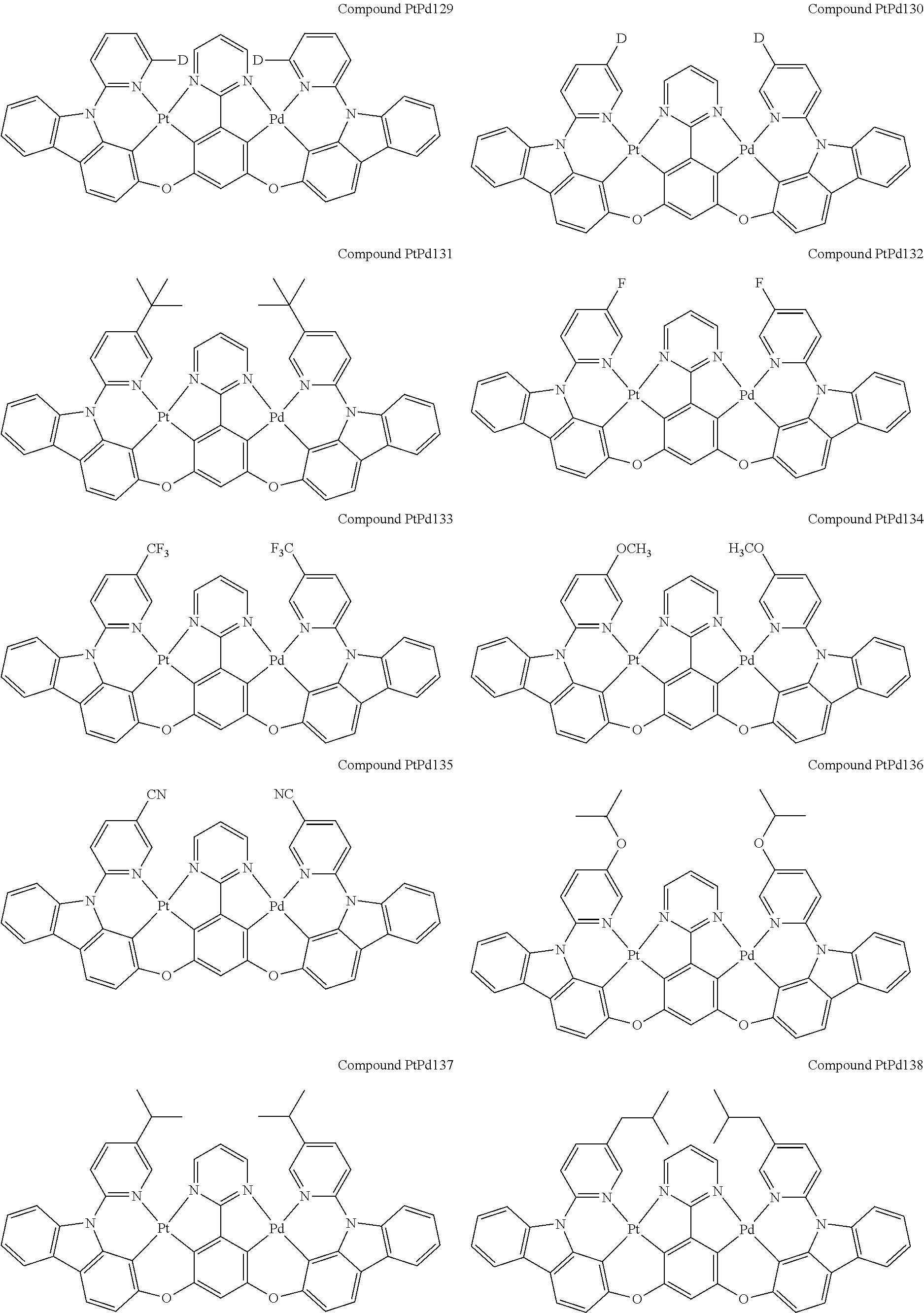

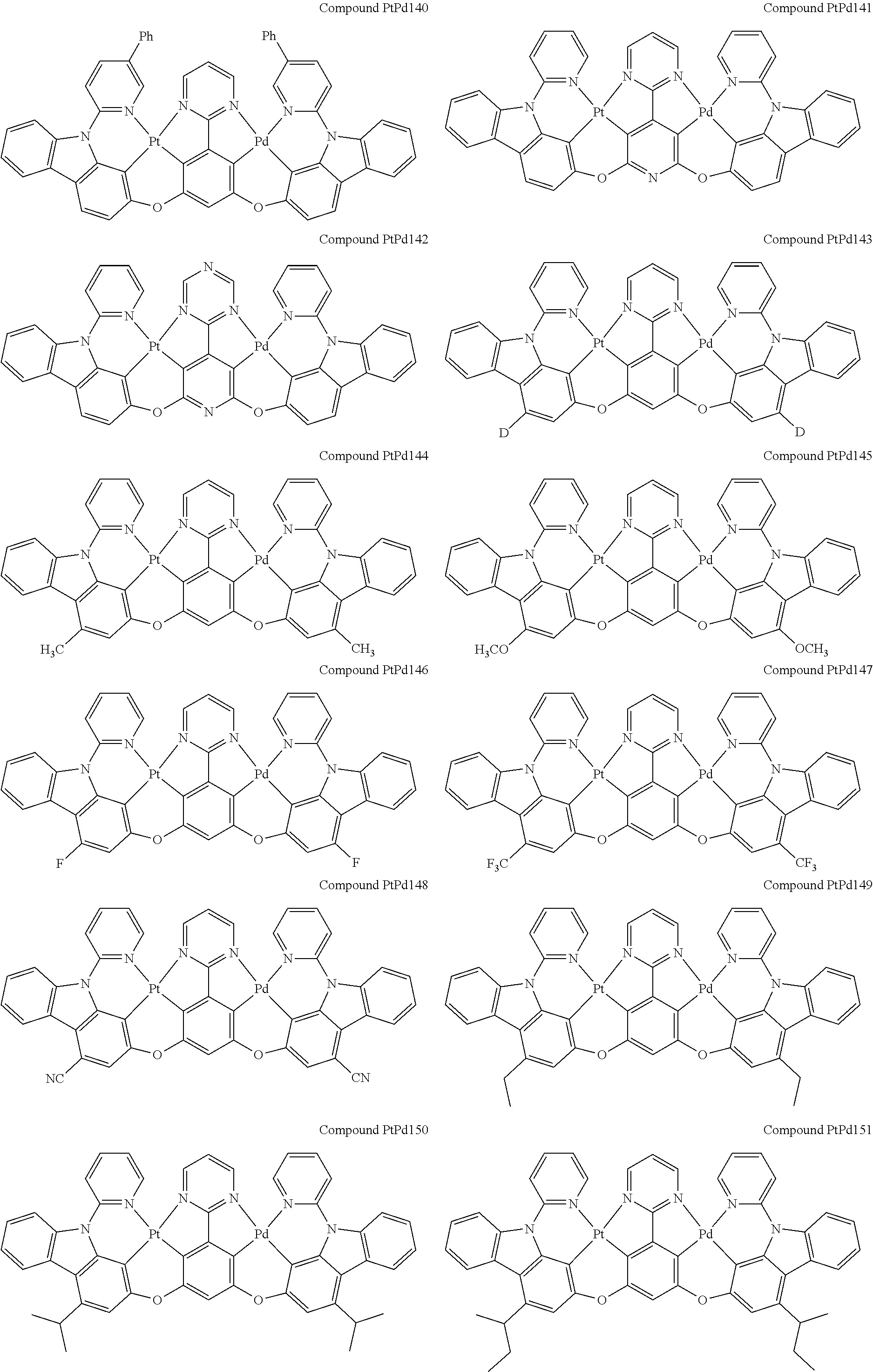
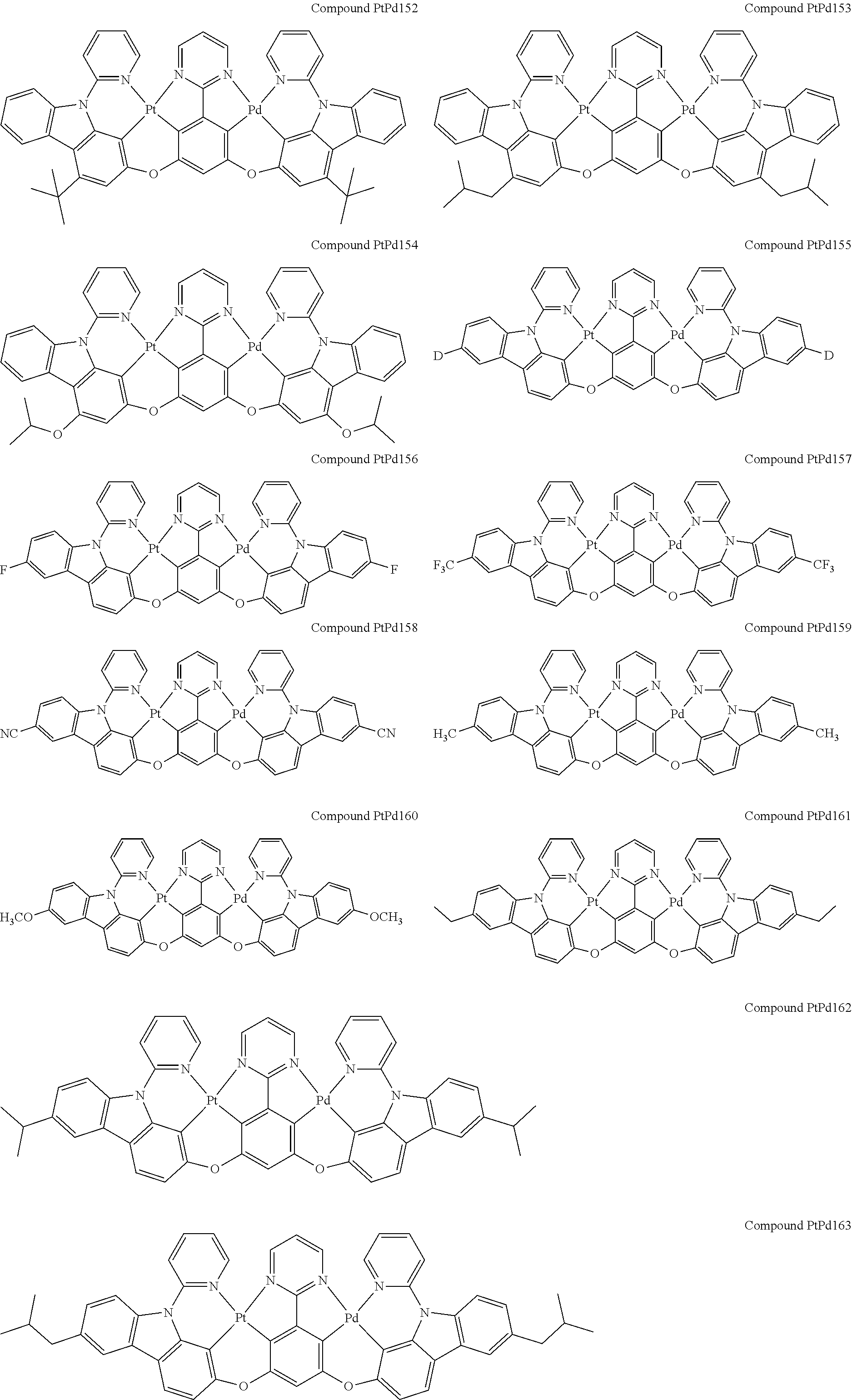

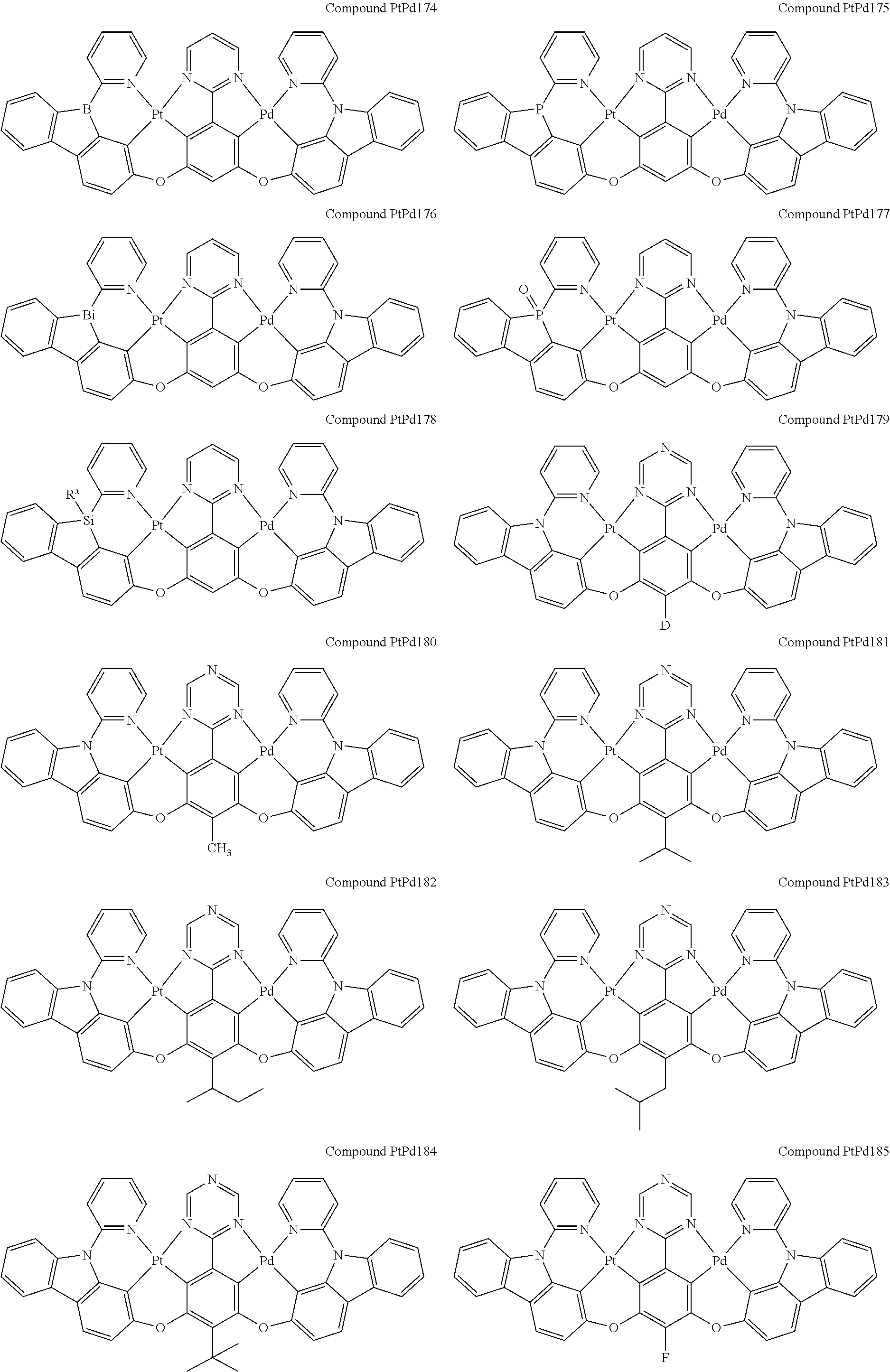

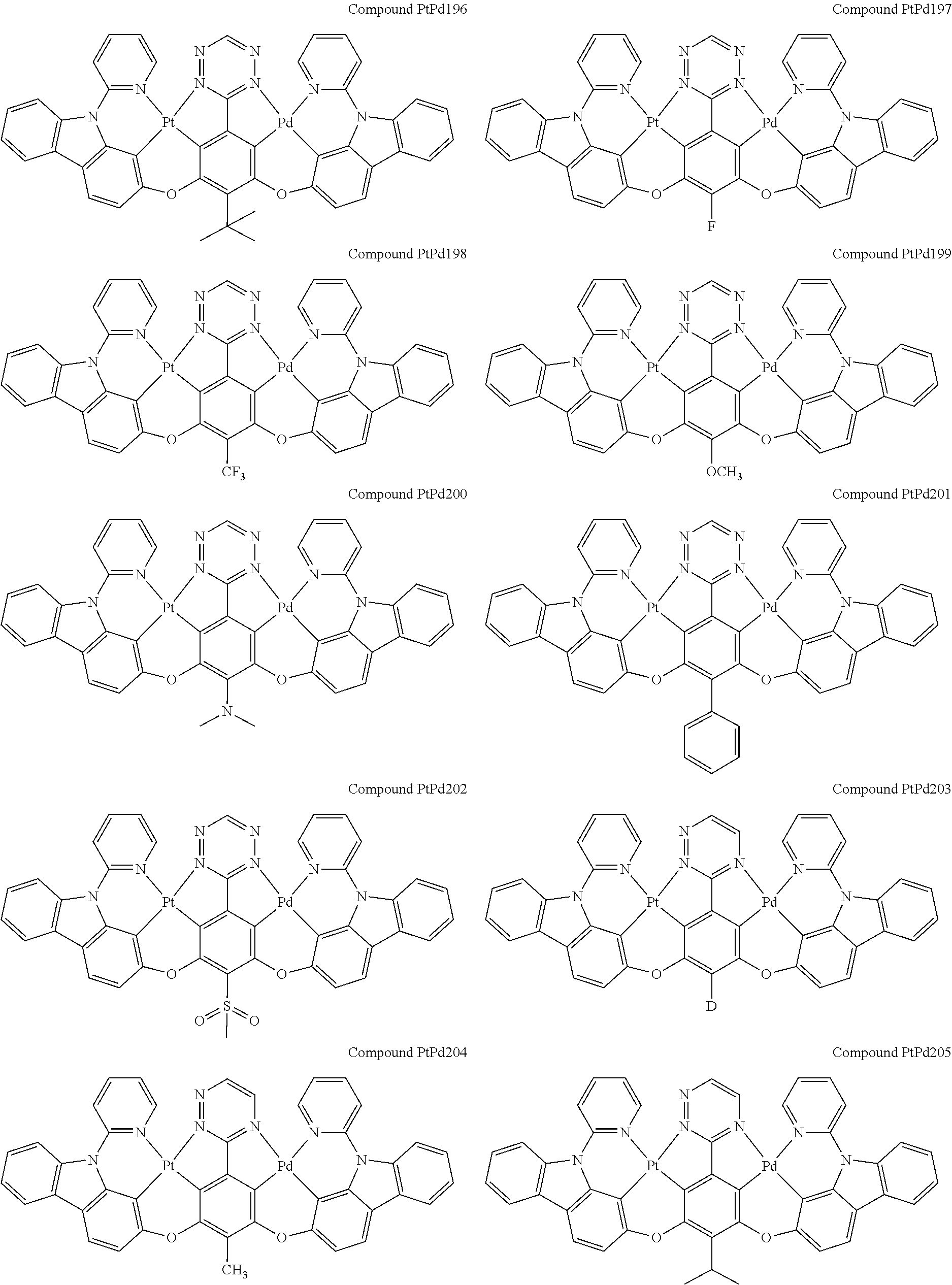
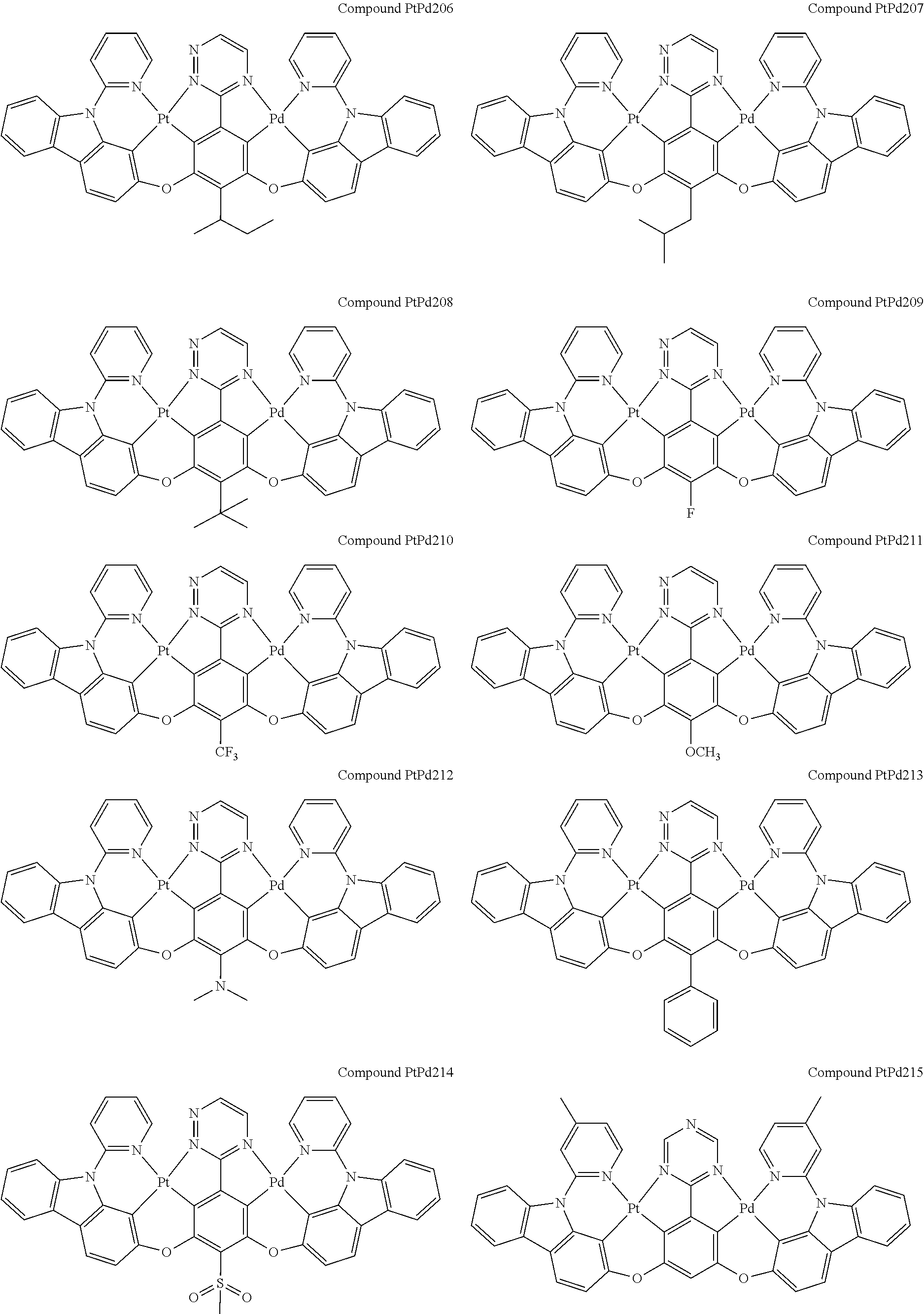
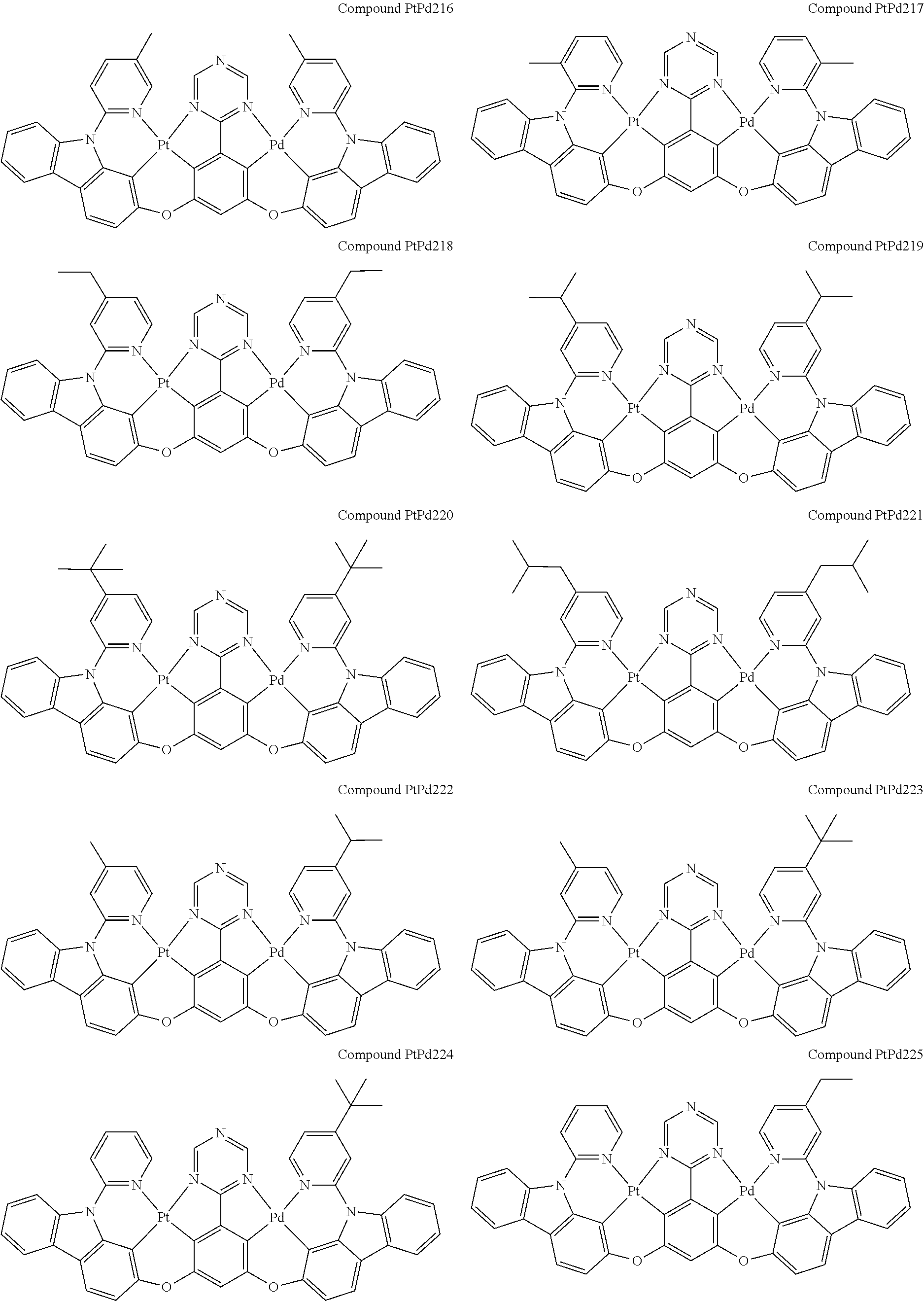
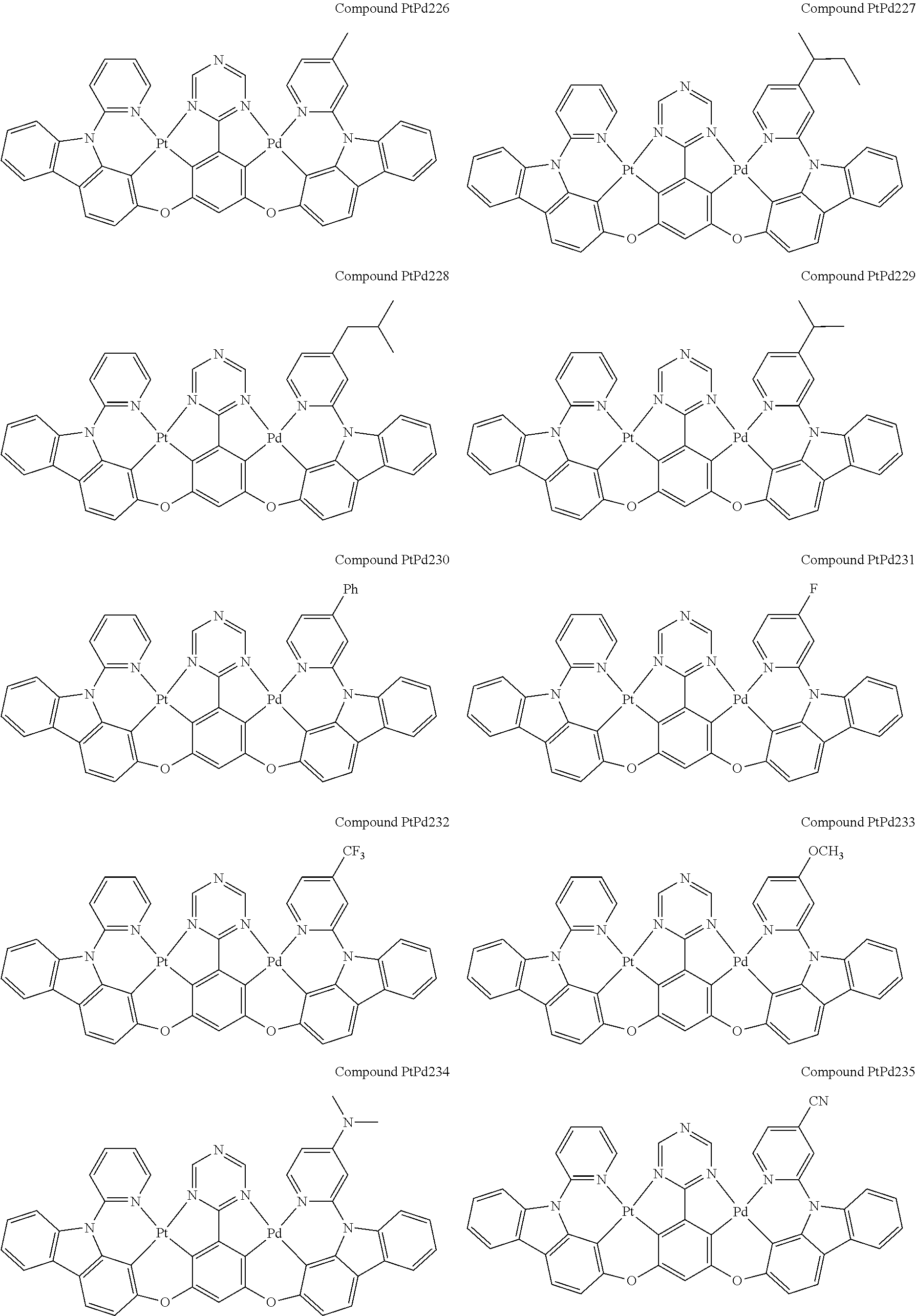
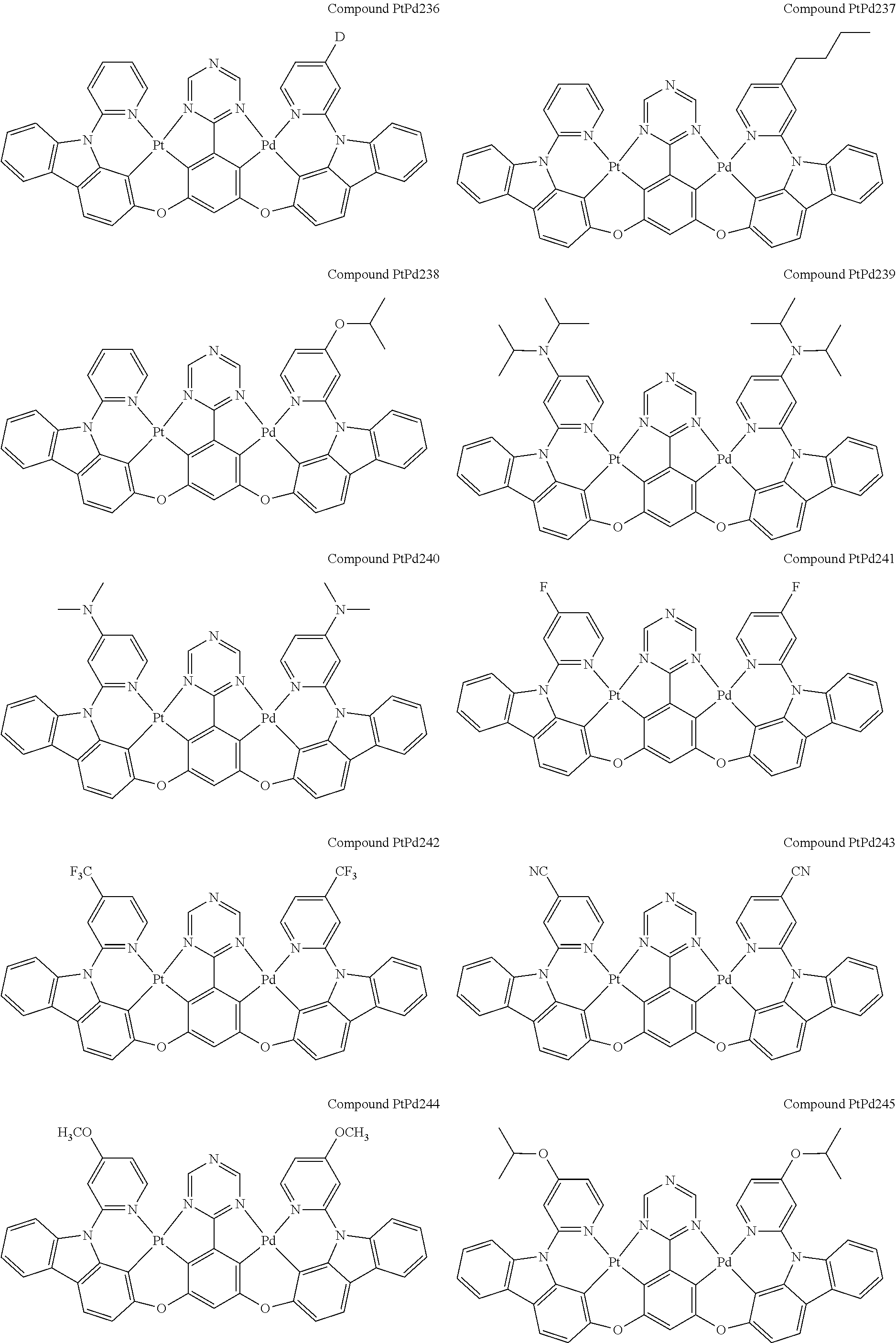

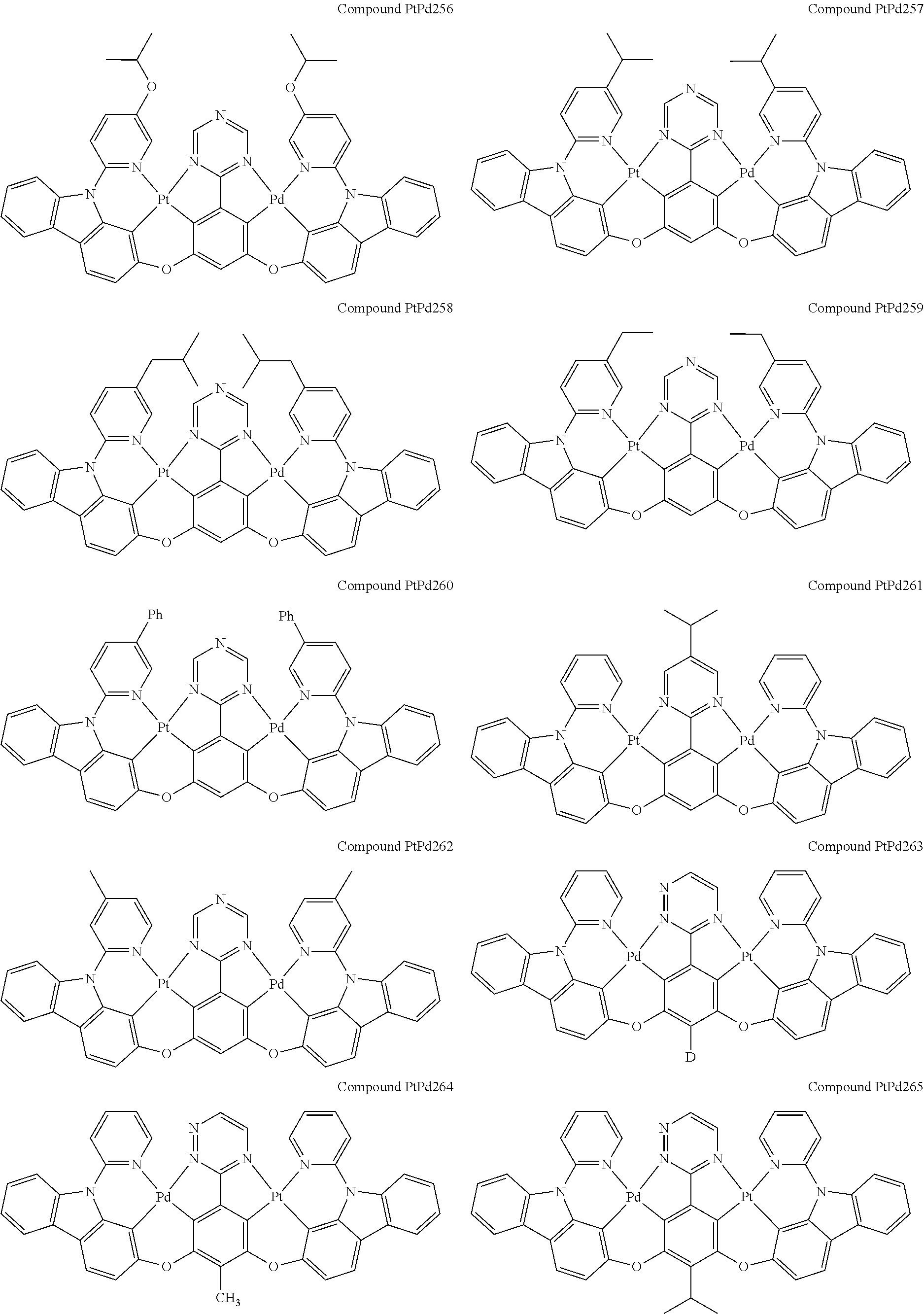




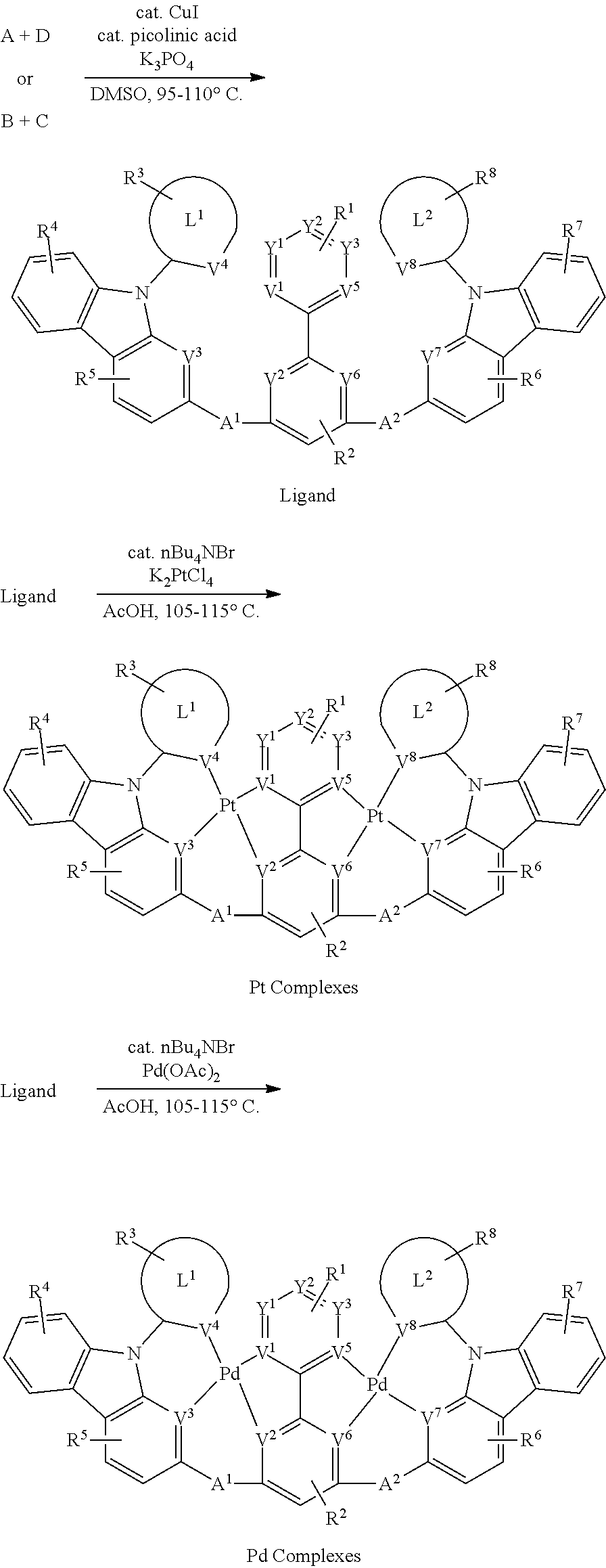
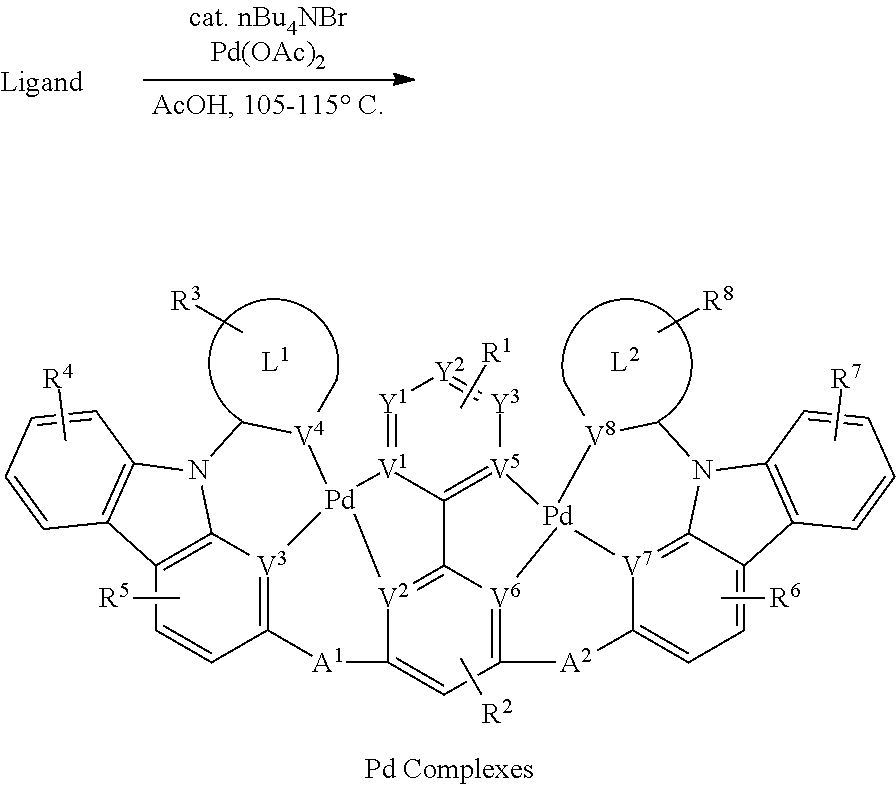
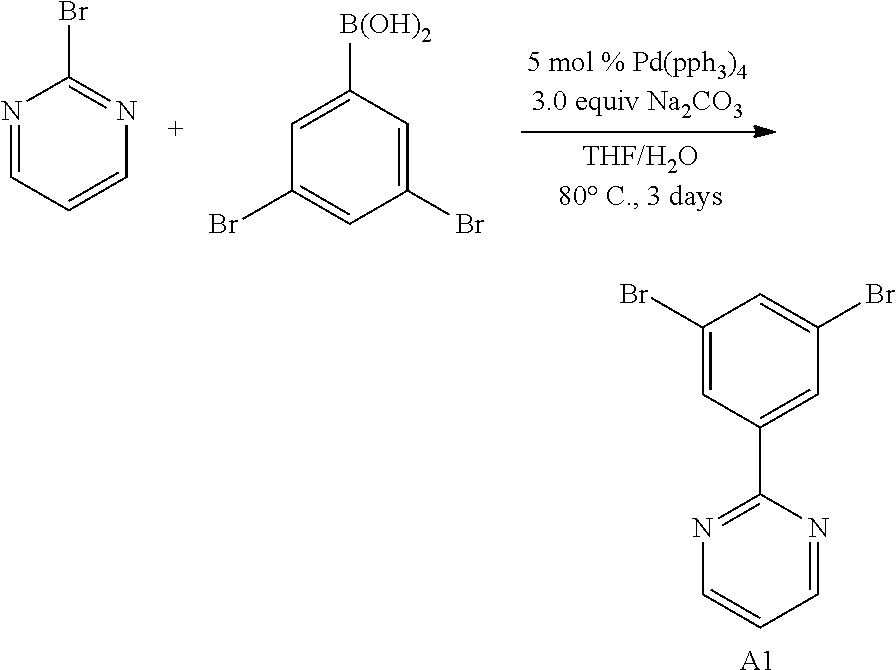
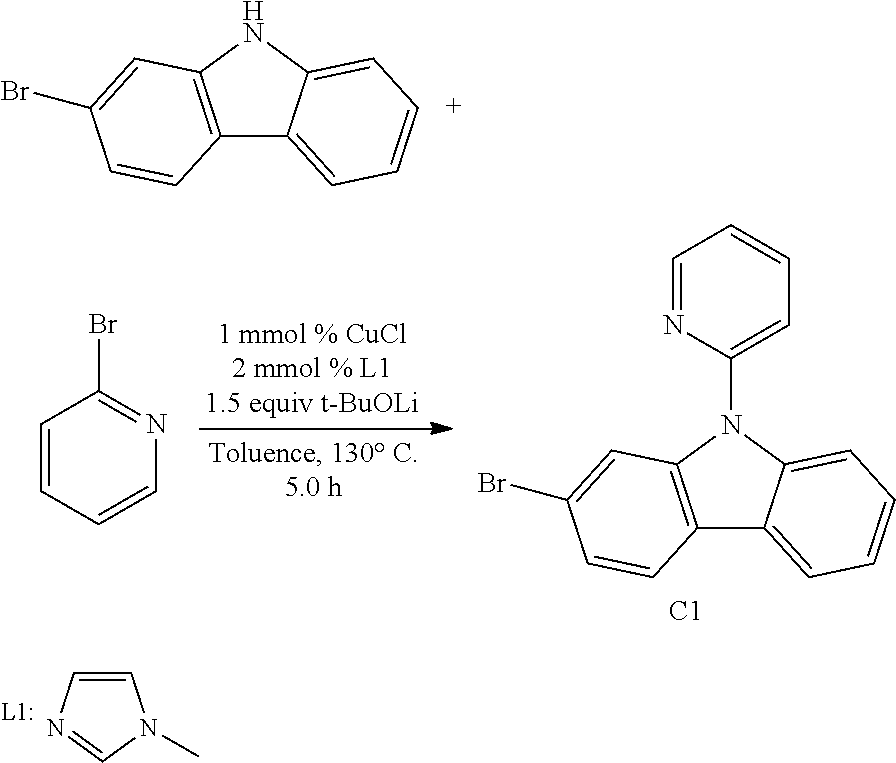
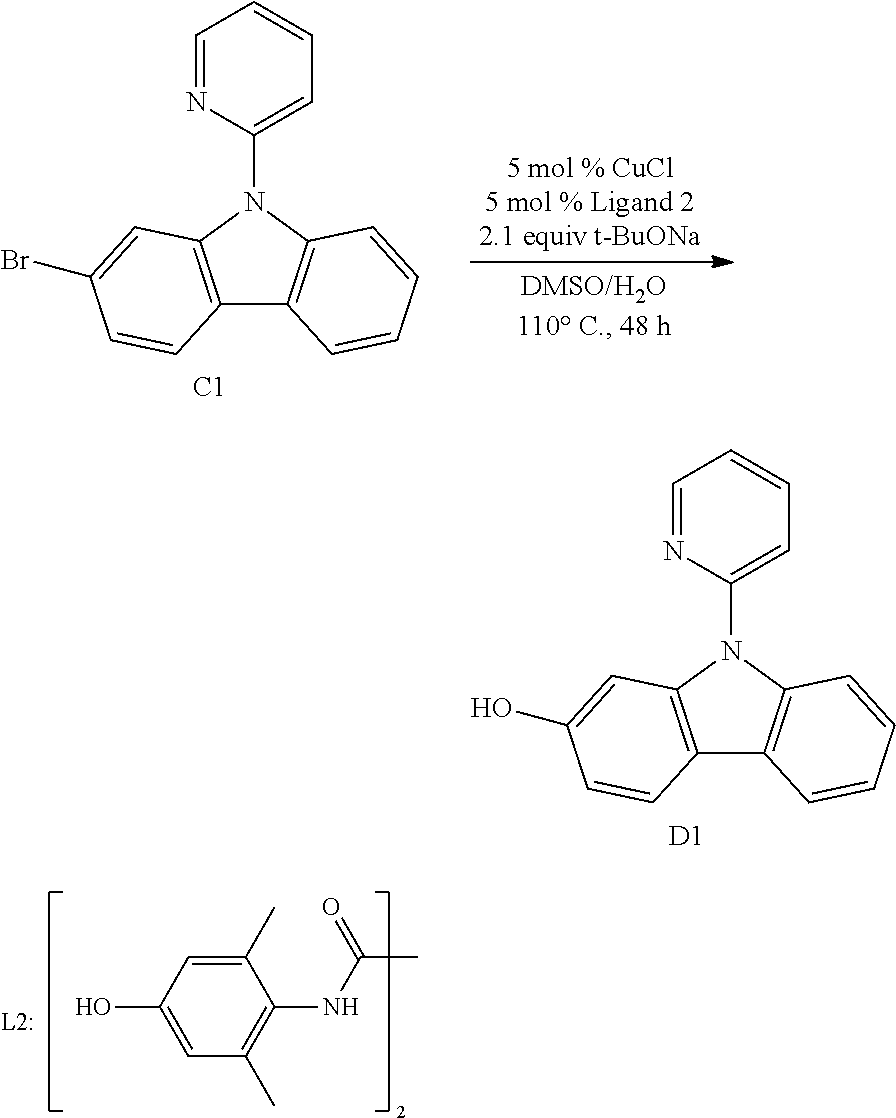
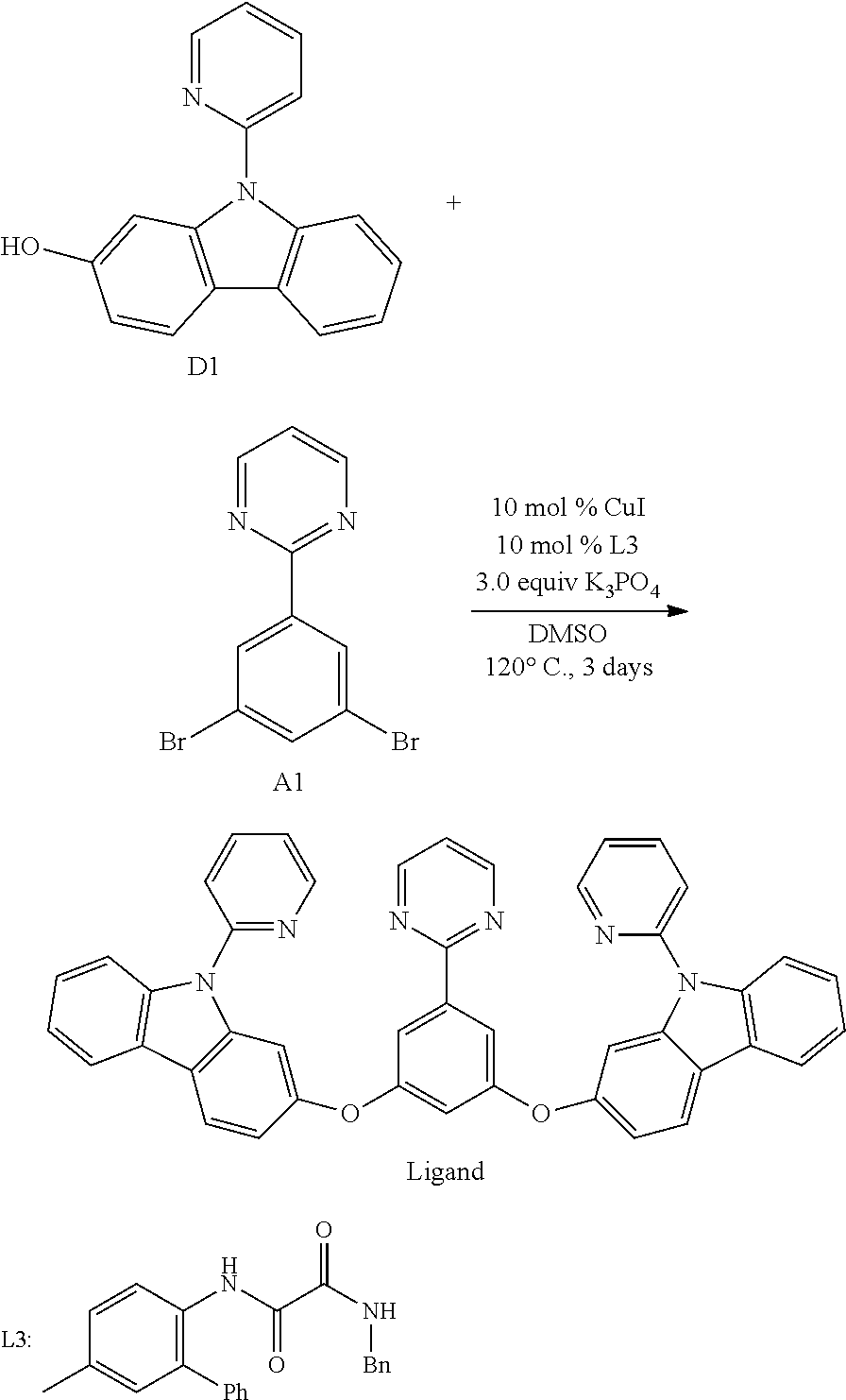

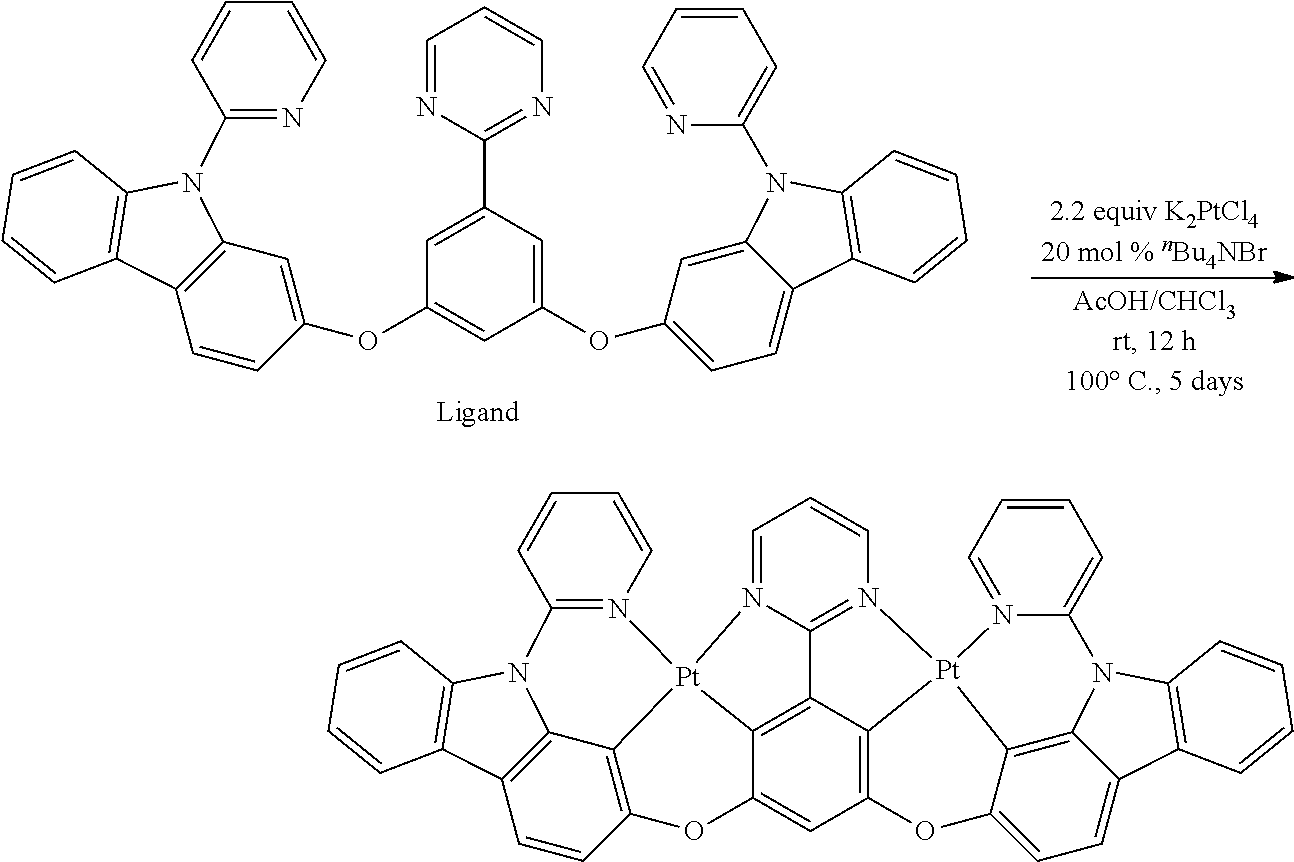
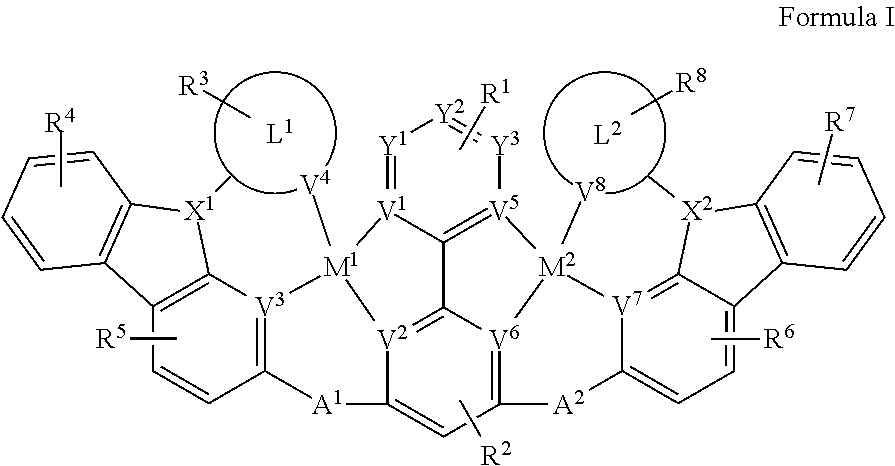


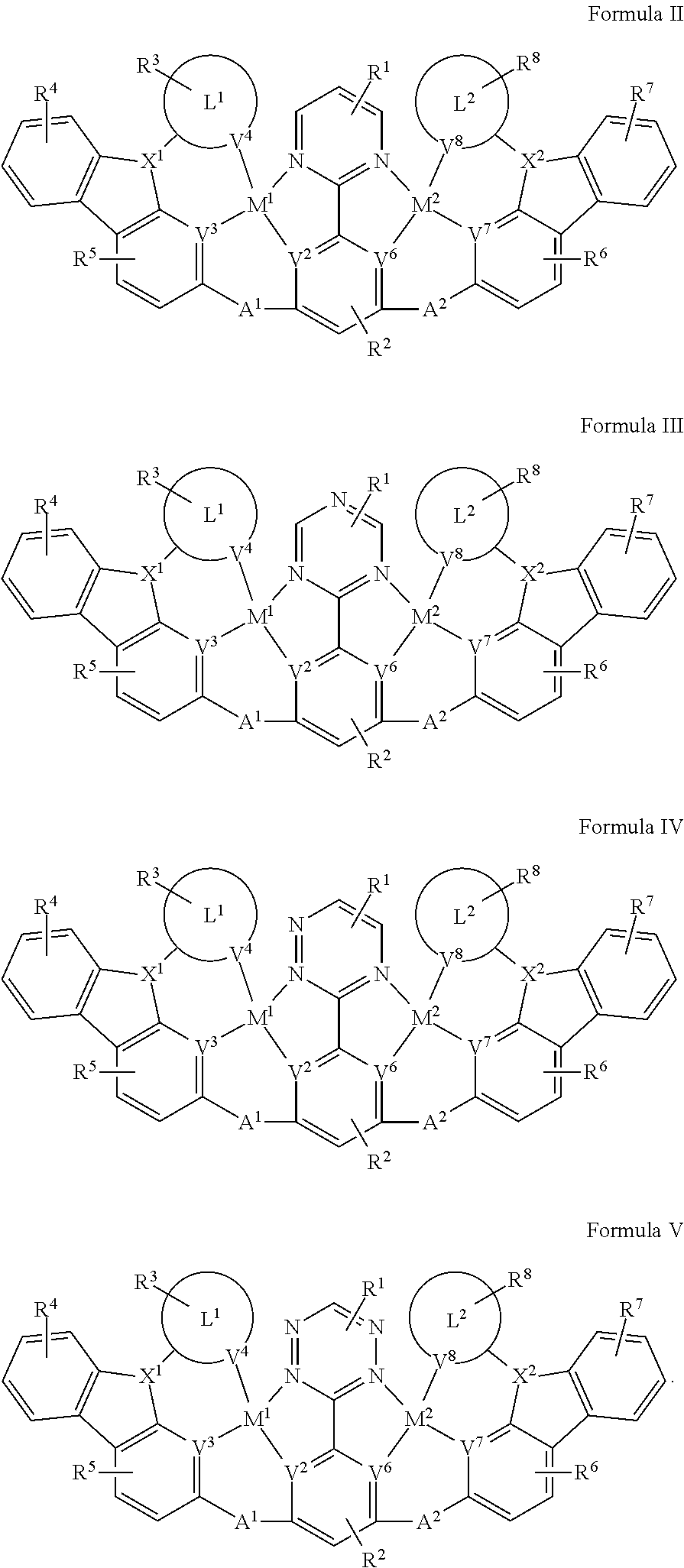
D00001
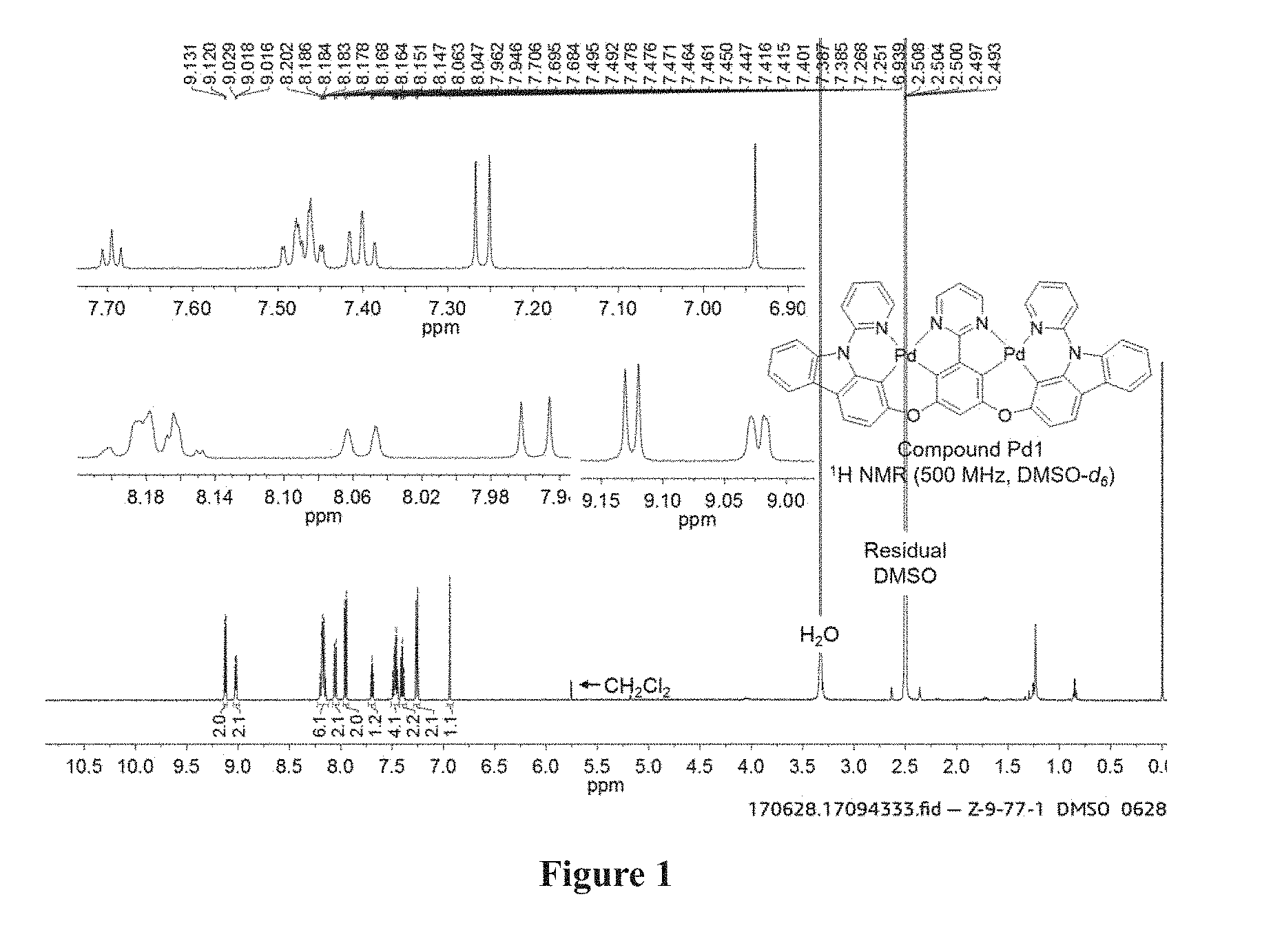
D00002
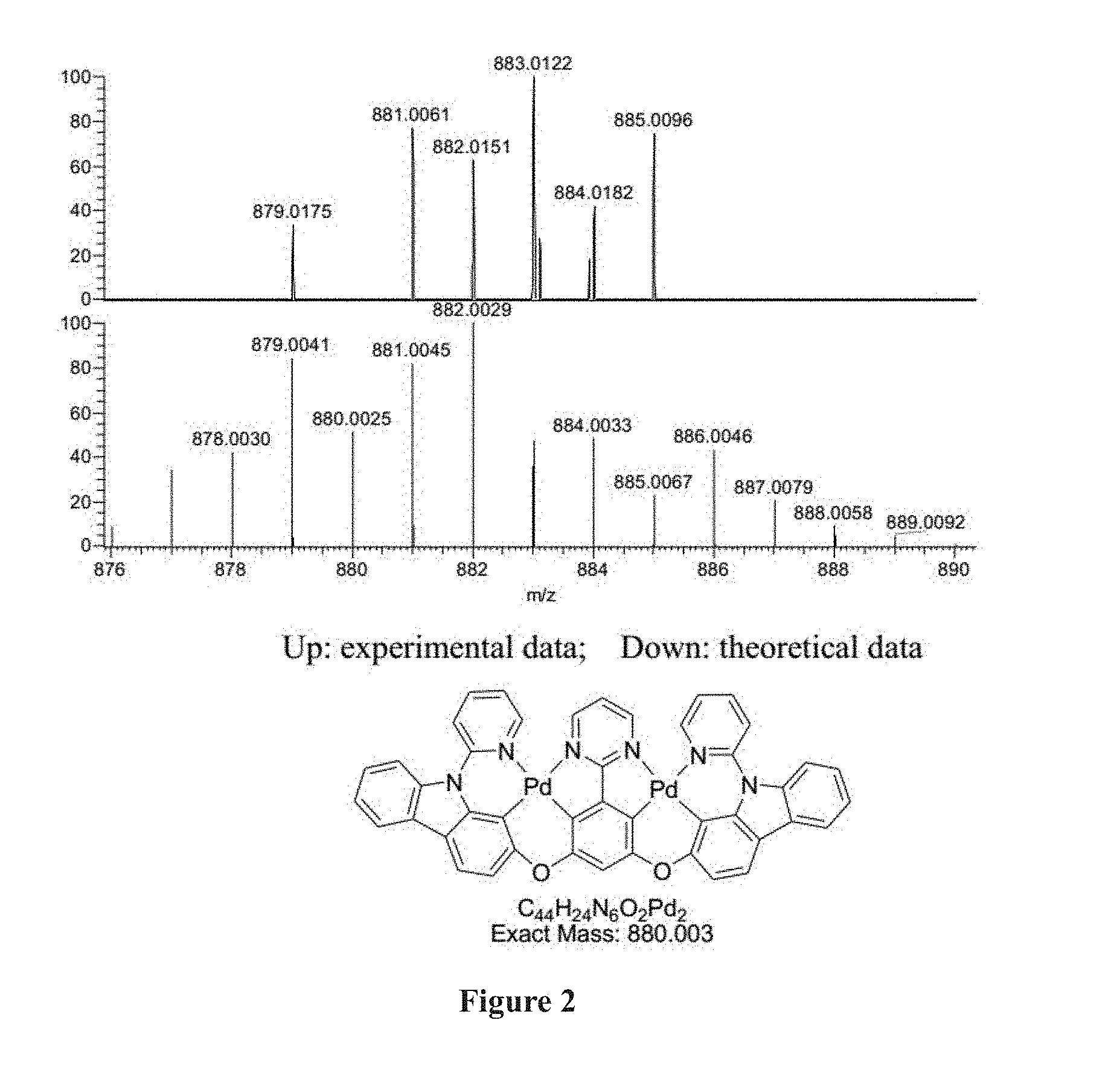
D00003

XML
uspto.report is an independent third-party trademark research tool that is not affiliated, endorsed, or sponsored by the United States Patent and Trademark Office (USPTO) or any other governmental organization. The information provided by uspto.report is based on publicly available data at the time of writing and is intended for informational purposes only.
While we strive to provide accurate and up-to-date information, we do not guarantee the accuracy, completeness, reliability, or suitability of the information displayed on this site. The use of this site is at your own risk. Any reliance you place on such information is therefore strictly at your own risk.
All official trademark data, including owner information, should be verified by visiting the official USPTO website at www.uspto.gov. This site is not intended to replace professional legal advice and should not be used as a substitute for consulting with a legal professional who is knowledgeable about trademark law.